By William Harwood
CBS News/Kennedy Space Center
The following copy originally was posted on the Current Mission space page at http://cbsnews.com/network/news/space/current.html. Comments, suggestions and corrections welcome!
TABLE OF CONTENTS
![]() 10:45 PM, 2/21/10, Update: Shuttle Endeavour lands in Florida (UPDATED at 1:50 a.m. with crew comments)
10:45 PM, 2/21/10, Update: Shuttle Endeavour lands in Florida (UPDATED at 1:50 a.m. with crew comments)
The shuttle Endeavour dropped through a partly cloudy sky and glided to a ghostly night landing at the Kennedy Space Center Sunday, leaving the International Space Station behind with a new life support module and observation deck.
Approaching the spaceport in a steep dive, commander George Zamka guided the shuttle through a sweeping left overhead turn, lined up on runway 15 and swooped to a picture-perfect touchdown at 10:20:31 p.m. EST. Pilot Terry Virts then released a red-and-white braking parachute and a few moments later, the spaceplane rolled to a stop.
"Houston, Endeavour, wheels stopped," Zamka radioed in a tradition call to mission control.
"Roger wheels stopped, Endeavour. Welcome home," replied astronaut Rick Sturckow from Houston. "Congratulations to you and the crew on an outstanding mission, installing the Tranquility node and opening up the cupola's windows to the world."
"Well Houston, it's great to be home," Zamka said. "It was a great adventure."
Space station flight engineer Soichi Noguchi watched Endeavour's fiery re-entry from a window in the new cupola observation deck, tweeting via the internet "I watched the shuttle atmospheric reentry from Cupola window. The view was definitely out-of-the-world."
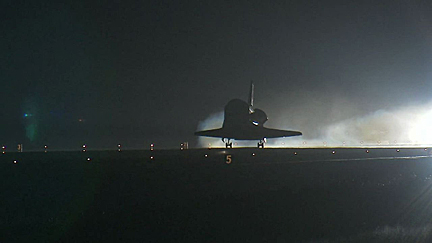
The shuttle Endeavour touches down at the Kennedy Space
Center. (Photo: NASA TV)
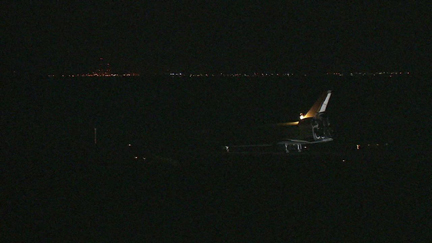
Exhaust from the shuttle's hydraulic power units shoots
into the night sky as Endeavour rolls down the runway.
(Photo: NASA TV)
Mission duration was 13 days 18 hours six minutes and 24 seconds, covering 217 complete orbits and 5.6 million miles since blastoff Feb. 8 from nearby pad 39A.
Zamka, Virts, Kathryn Hire, flight engineer Stephen Robinson and spacewalkers Robert Behnken and Nicholas Patrick doffed their pressure suits for a traditional runway inspection before heading to crew quarters for reunions with friends and family.
"STS-130 is mission complete, we're safe on deck here at Kennedy Space Center and that's due to the work of a lot of people," Zamka said. "We had a great team, we had tremendous hardware to bring up - node 3 was pristine, cupola was beautiful ... and Endeavour, my goodness, what a machine! She was perfect throughout the flight and we brought her back safe and sound due to a great mission control team. So thanks to all who were involved."

The shuttle Endeavourr, banking during re-entry, as photographed
by flight engineer Soichi Noguchi from the cupola. (Photo: NASA TV)
Landing was in doubt earlier in the day as entry Flight Director Norm Knight assessed cloudy weather at the Kennedy Space Center.
But conditions improved as the night wore on and based on observations by astronaut Christopher Ferguson, flying a shuttle training jet near the runway, Knight cleared Zamka and Virts to fire Endeavour's braking rockets on time at 9:14 p.m. to begin the descent. Zamka had no problems and touchdown was uneventful.
Endeavour undocked from the space station Friday night, leaving the outpost more than 98 percent complete with the addition of the Tranquility habitation module and a seven-window cupola observation deck.
The station's total pressurized volume is now 28,947 cubic feet - roughly the same as a 747 jumbo jet - and a habitable volume of 12,420 cubic feet. Total mass now stands at a bit more than 799,000 pounds. When the shuttle is attached, the two spacecraft mass more than a million pounds.

Pilot Terry Virts, left, and commander George Zamka on
Endeavour's flight deck after landing. (Photo: NASA TV)

The shuttle Endeavour surrounded by support crews. (Photo: NASA TV)

The Endeavour astronauts pose on the runway. (Photo: NASA TV)
The station's U.S. life support equipment - an oxygen generator, carbon dioxide scrubber, a water processing rack, a urine recycling rack and a toilet - were moved into Tranquility after it was attached to the station, along with a high tech exercise machine.
The cupola, launched on the outboard end of Tranquility, was moved to its Earth-facing port for use as an observation station and robot arm work station.
Only four more shuttle flights are planned to deliver supplies, equipment, experiment racks and other gear in a final push to leave the lab complex in the best possible shape when the shuttle fleet is retired this fall. And with every successful launch and landing, the reality of the looming end of the shuttle program gains more traction among the men and women who maintain the iconic orbiters.
"I got to watch a lot of the folks out on the runway tonight just kind of stand there and look up at Endeavour and think about the majesty of that ship and its next to last flight," said Launch Director Mike Leinbach. "There's a whole series of 'lasts' coming up. The people fall in love with the machines. It's going to be hard to let them go. But we've been given our direction. We're mature about it, we're professional about it so we're going to process and fly that last mission. And move on."
With Endeavour back on the ground, engineers at the Kennedy Space Center plan to haul the shuttle Discovery from its processing hangar to the Vehicle Assembly Building Tuesday for attachment to an external tank and solid fuel boosters. If all goes well, Discovery will be hauled to pad 39A on March 2, setting the stage for launch April 5.
On March 18, the Russian Soyuz TMA-16 capsule is scheduled to undock from the station, bringing Expedition 22 commander Jeffrey Williams and cosmonaut Maxim Suraev back to Earth after six months in orbit.
Another Soyuz, TMA-18, is scheduled for launch from the Baikonur Cosmodrome in Kazakhstan on April 2 to carry three fresh crew members to the outpost: Alexander Skvortsov, Mikhail Kornienko and NASA astronaut Tracy Caldwell.
Discovery is scheduled for take off three days later to deliver new science racks, a replacement ammonia coolant tank assembly, a rate gyroscope and to retrieve a Japanese experiment package.
8:55 PM, 2/21/10, Update: Shuttle crew cleared for re-entry
Entry Flight Director Norm Knight has cleared the shuttle Endeavour's crew to fire the ship's breaking rockets at 9:14:47 p.m. EST, setting up a landing at the Kennedy Space Center at 10:20:32 p.m.
Forecasters have taken rain out of the KSC forecast and with light winds expected, the only concern has been the cloud cover.
Astronaut Christopher Ferguson, flying a shuttle training jet over the Florida spaceport, says a deck of broken clouds at about 7,000 feet is generally transparent and does not obscure the runway.
After consultations with the flight control team and the Spaceflight Meteorology Group at the Johnson Space Center, Knight cleared shuttle commander George Zamka to proceed with an on-time re-entry.
This status report will be updated after Endeavour's landing or as conditions warrant.
3:20 PM, 2/21/10, Update: Station computer glitches possibly triggered by software in European Columbus module (UPDATED at 3:50 p.m. with success restoring high-speed station communications)
Engineers troubleshooting a series of glitches in the operation of the space station's three command and control computers Sunday may have traced the root cause to a problem with communications software in the European Space Agency's Columbus laboratory module.
"There's a memory address that's implicated every time one of the C&Cs has failed," Stan Love radioed the station from mission control. "It's part of the S-band telemetry software that packetizes Columbus data. So without enabling that particular piece of code, we are going to resume careful commanding ... to get your systems back to a nominal config. That commanding will include recovering the KU-band comm."
Love told station commander Jeffrey Williams "the silver lining of today's data system cloud, since we took up so much of your (off-duty) time today, we are clearing off Wednesday for you, so Wednesday will be an off-duty day for the crew."
"Well that's very generous. Thank you," Williams replied. "Once again, you think you've isolated it to some set of Columbus commanding. Is that true?
"Yeah, Jeff, in the S-band software that takes Columbus data and puts it into packets to send to the ground."
Williams complimented the mission control team for its "detective work."
"Everyone's been working very hard on this," Love replied.
A few minutes later, Love called back to tell the crew that engineers had successfully restored the station's high-speed KU-band communications system to normal operation and along with it, email and the lab's internet phone.
"OK, good news, we got KU back," Love said. "We were in the middle of a mail synch when the C&C troubles occurred. As you've probably noticed, you've been locked out of email all day. We're going to get you a mail synch and then you'll get a go for Outlook shortly.
"Also, with the C&C config, we have a lot of nuisance messages that are normally suppressed, or inhibited, and right now they are all enabled. We estimate it'll take about 24 hours of ground commanding to get them all back to their normal config. What that means is that there's a greater than normal chance of waking you guys up tonight with alarm tones. Again, we're fixing that as quick as we can, but it's going to be a while.
A few minutes later, the crew was told they could resume using their internet protocol telephone.
"Yoo hoo! Thanks," Timothy Creamer replied from the station.
"And mail synch is complete and you're go for Outlook," Love said.
"Double yoo hoo. Thank you so much for that."
1:05 PM, 2/21/10, Update: Shuttle landing forecast unchanged
The Spaceflight Meteorology Group at the Johnson Space Center in Houston has updated its forecast for this evening's planned landing of the shuttle Endeavour. The SMG is predicting the Kennedy Space Center in Florida and NASA's backup landing site at Edwards Air Force Base, Calif., will both be "no-go" barring an unexpected change in the weather.
In Florida, forecasters are expecting broken decks of clouds at 6,000, 12,000 and 25,000 feet with winds out of 160 degrees at 7 knots, gusting to 10 knots, and a chance of showers within 30 nautical miles.
At Edwards, the forecast calls for broken decks at 3,000 and 6,000 feet, overcast at 10,000 feet, winds out of 240 degrees gusting to 18 knots and rain within 30 nautical miles.
The forecast for Monday is even worse in Florida, with a broken deck as low as 2,000 feet and thunderstorms in the area. Edwards, however, appears "go" with scattered clouds and light winds.
The Endeavour astronauts are scheduled for wakeup at 2:14 p.m. The deorbit timeline begins shortly after 5 p.m.
11:15 AM, 2/21/10, Update: Space station central computer fails; backup takes over (UPDATED at 12:40 p.m. with additional details of more extensive computer problem)
Multiple computer glitches aboard the International Space Station triggered intermittent communications blackouts early Sunday, officials said, and while the three command and control computers seem to be working, engineers do not yet understand what has caused the machines to repeatedly transition from one to the other.
The station's command and control software was updated before the shuttle Endeavour's flight to account for the new Tranquility module and it's possible the computer failures, or transitions, are software related. Issues with computers in Tranquility also have been noted, but it's not yet clear whether they are related to the command and control issues.
During normal operations, one of the three C&C computers, known as a multiplexer/demultiplexer, operates as the "prime" machine, allowing station astronauts and ground controllers to send commands to various systems and providing critical telemetry.
A second C&C computer operates in backup mode, ready to take over if the prime computer suffers a problem, and the third machine operates in standby in a domino-like software architecture. The computer system is critical to all aspects of space station operation.
Early Sunday, the prime C&C computer ran into a problem, forcing a transition to the backup. A NASA source familiar with the troubleshooting said the backup "came on and was prime for about a second and then it failed a diagnostic, the equivalent of the blue screen of death on a Windows machine. The third one, which was in standby, it came up and was prime for about an hour and just a little while ago it also transitioned and stopped work. The first one that went down, the original prime, it's back up right now."
"But now that this has cycled through all three machines it is very clear there is some generic, probably software related problem," he said.
NASA mission control commentator Pat Ryan outlined a slightly different sequence of events, saying when the prime computer malfunctioned "the backup computer moved assume its responsibilities and then the standby computer moved to backup. In the process, Houston lost S-band communications with the crew on board."
Commander Jeff Williams called down at 9:55 a.m. EST "and confirmed there had been a primary and backup failure of the C&Cs," Ryan said. "However, two of the three computers were healthy. Later this morning, just before (11 a.m.), there was data here in mission control that indicated there had been another C&C transition, this time still with just two computers healthy.
"But after a third transition this morning, all three computers were indicating they were healthy, although they were now operating in different slots among the primary, backup and standby computers. About 20 minutes ago (just after noon EST), space station commander Jeff Williams indicated there had been another transition, this one only impacting the backup and standby computers.
"But we are still in a situation currently where all three computers are healthy but the team here in mission control is still scratching its head and trying to determine what's been causing the repeated transitions," Ryan said. "There has been no impact to station life support systems while this was going on and the crew is in good shape."
As of 12:30 p.m., command and control computer No. 3 was prime, with C&C No. 2 in backup and No. 1 in standby.
"We're thinking we might need another day off," Williams joked with mission control as the troubleshooting continued.
"Copy and concur, Jeff," replied Stan Love in Houston. "We are talking in the room, we still do not know what has been causing these transitions. We are toying with the idea there might be something related to commanding. But we are not sure, it's just speculation at this point."
Love later said engineers had detected a fault in a computer system in the Tranquility module, but it was not immediately known if that was related to the C&C issue.
2:40 AM, 2/21/10, Update: Entry flight director expects 'very difficult weather day' for planned shuttle landing Sunday
Entry Flight Director Norm Knight expects a "very difficult weather day" for the shuttle Endeavour's planned landing Sunday night at the Kennedy Space Center, with low clouds and showers in the vicinity. Conditions are expected to be even worse Monday, but forecasters expect good conditions at Edwards Air Force Base, Calif., if a one-day wave off is required.
Despite the gloomy forecast, Knight said NASA would be staffing both landing sites Sunday night in an attempt to get Endeavour down on time on one coast or the other.
"We're really not going to know until we get down to the wire," he told reporters early Sunday. "I anticipate that about an hour prior to the deorbit burn we'll have a pretty good idea what the weather looks like and make a decision at that point."
Commander George Zamka and his crewmates have two landing opportunities at Kennedy on Sunday and two at Edwards on four successive orbits. Here are the latest times (in EST and mission elapsed time):
DATE/TIME.....DD...HH...MM...SS...EVENT 02/21 09:14:52 PM...13...17...00...45...Deorbit ignition (orbit 217) 10:20:37 PM...13...18...06...30...Landing at Kennedy Space Center 10:50:52 PM...13...18...36...45...Deorbit ignition (orbit 218) 11:55:50 PM...13...19...41...43...Landing at Kennedy Space Center 02/22 12:20:31 AM...13...20...06...24...Deorbit ignition (orbit 219) 01:25:41 AM...13...21...11...34...Landing at Edwards AFB 01:56:41 AM...13...21...42...34...Deorbit ignition (orbit 220) 03:00:56 AM...13...22...46...49...Landing at Edwards AFB
The latest forecast from the Spaceflight Meteorology Group at the Johnson Space Center in Houston calls for broken decks of clouds at 6,000, 12,000 and 25,000 feet and a chance of showers within 30 nautical miles of the runway. The forecast for Edwards calls for rain and broken decks at 3,000 and 6,000 feet.
"As far as the landing strategy goes, we're definitely going to try two KSC opportunities (Sunday)," Knight said. "We have Edwards called up, the site's ready to support. ... The forecast right now doesn't look good for Sunday, but we're going to be looking hard at the weather and if an opportunity exists for Edwards, we'd probably take a shot at it."
If the weather doesn't cooperate, Zamka and his crewmates will spend an extra day in space and try again on Monday. Endeavour has enough on-board supplies to remain in orbit until Tuesday at the latest, but NASA typically reserves the final landing opportunity to protect against technical problems.
"For end of mission plus one, which is Monday, for KSC the current forecast indicates the site is degrading," Knight said. "That system that's moving across the central U.S. encroaches Florida and it brings thunderstorms, rain, high crosswinds and (low) ceilings to the site. So if the forecast holds true for KSC, it doesn't look good for Monday.
"Edwards, on the other hand, looks pretty good," he said. "That low pressure that was pretty much centered on top of them on Sunday moves off to the east and it leaves some very nice weather for landing if we need it on end of mission plus one."
He said forecasters with the Spaceflight Meteorology Group were confident Edwards would be available Monday.
Even so, Sunday night "is going to be a very difficult weather day," Knight said. "We're going to play it by ear. Again, it's going to go down to the wire and if we don't land (Sunday), if we wave off, we'll look at our end-of-mission-plus-one weather and try to get on the ground (Monday)."
Detailed entry timelines for landings at Kennedy or Edwards overnight Sunday are available on the CBS News STS-130 Quick-Look page.
09:15 PM, 2/20/10, Update: Astronauts test shuttle entry systems; NASA managers keep tabs on threatening weather (UPDATED at 9:15 p.m. with revised landing times)
Keeping tabs on threatening weather, the Endeavour astronauts packed up Saturday, powered down the ship's robot arm and tested the shuttle's re-entry systems in preparation for landing Sunday night at the Kennedy Space Center.
Commander George Zamka and his crewmates have two landing opportunities in Florida Sunday and two at Edwards Air Force Base, Calif. Flight controllers Saturday deleted a previously planned orbit adjust rocket firing, resulting in slightly revised deorbit and landing times (in EST and mission elapsed time):
DATE/TIME.....DD...HH...MM...SS...EVENT 02/21 09:14:52 PM...13...17...00...45...Deorbit ignition (orbit 217) 10:20:37 PM...13...18...06...30...Landing at Kennedy Space Center 10:50:52 PM...13...18...36...45...Deorbit ignition (orbit 218) 11:55:50 PM...13...19...41...43...Landing at Kennedy Space Center 02/22 12:20:31 AM...13...20...06...24...Deorbit ignition (orbit 219) 01:25:41 AM...13...21...11...34...Landing at Edwards AFB 01:56:41 AM...13...21...42...34...Deorbit ignition (orbit 220) 03:00:56 AM...13...22...46...49...Landing at Edwards AFB
But the Spaceflight Meteorology Group at the Johnson Space Center is predicting possible rain showers near the Kennedy Space Center with rain and low clouds expected at Edwards in California's Mojave Desert. Even worse conditions are expected in Florida on Monday but Edwards is expected to be "go."
NASA has a third shuttle landing site near White Sands, N.M., but it is considered a last-resort option because less support equipment is staged there and it would take longer to get a shuttle back to Florida. Given the current forecast, NASA is unlikely to consider a diversion to White Sands.
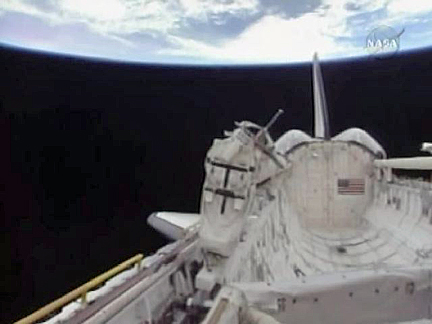
The shuttle Endeavour just after crew wakeup Saturday. (Credit: NASA TV)
"The forecast we have right now, we have at least an even chance, if not a little better than that, probably 60-40 in my estimation for getting into KSC on the first opportunity╩tomorrow night," LeRoy Cain, chairman of NASA's Mission Management Team, said at a news briefing.
"That's my personal guess, which means absolutely nothing, but since you asked, I'll give it to you. The good news is, we have a lot of options, a lot of capability in terms of our end-of-mission days and deorbit opportunities to the various sites. We're hopeful (Kennedy is) where we'll get to."
Endeavour has enough on-board supplies to remain in orbit until Tuesday at the latest. But NASA typically reserves the final landing opportunity to protect against payload bay door problems or other technical issues. Cain said NASA's current focus is to get Endeavour down, on one coast or the other, by Monday.
Entry Flight Director Norm Knight is expected to brief reporters on his landing strategy at 1:30 a.m. Sunday.
Aboard Endeavour, meanwhile, Zamka, pilot Terry Virts and flight engineer Stephen Robinson worked through a standard day-before-entry flight control system checkout, firing up one of the ship's hydraulic power units and exercising the shuttle's elevons, rudder and other systems before test firing the ship's maneuvering jets.
Just before the APU was shut down, a piece of debris of some sort could be seen floating away from the shuttle, possibly jarred loose by the vibrations of the hydraulic system. The object passed very close to a camera and was too out of focus to identify.

In this split-screen view showing Endeavour's left and right wings,
a piece of out-of-focus debris can be seen floating away on the left.
(Credit: NASA TV)
3:20 AM, 2/20/10, Update: NASA managers assess weather, landing options
With Endeavour safely away from the International Space Station, flight controllers are looking ahead to the crew's planned landing Sunday night, assessing threatening weather in Florida and California and evaluating a variety of landing options.
Endeavour's crew has two Florida landing opportunities Sunday evening, the first at 10:16 p.m. EST and the second, one orbit later, at 11:51 p.m. Two opportunities also are available at Edwards Air Force Base in California's Mojave Desert at 1:20 a.m. EST Monday and 2:55 a.m.
The Spaceflight Meteorology Group at the Johnson Space Center in Houston is predicting a chance of showers within 30 nautical miles of the runway at the Kennedy Space Center, a violation of NASA's flight rules.
The forecast for Edwards calls for low ceilings and showers near the runway. A third landing site near White Sands, N.M., is forecast "go" Sunday. As of Friday evening, all three sites were predicted to be no-go overnight Monday.
Endeavour has enough on-board supplies to remain in orbit until Tuesday at the latest. NASA typically reserves the final landing opportunity to handle shuttle-related problems. If that philosophy plays out here, Endeavour's crew would be expected to land, if possible, on one coast or the other Sunday or Monday.
Kwatsi Alibaruho, the lead shuttle flight director, said early Saturday that entry Flight Director Norm Knight plans to "manage our resources on orbit to keep the largest number of options open to us if the weather is not looking favorable for our Kennedy Space Center deorbit opportunities on Sunday."
"I think what will likely happen is we might consider calling up all three available sites on Monday and we'll plan our trajectory tomorrow or on Sunday to give us the largest number of deorbit opportunities on that end-of-mission plus-one day, which would be Monday," Alibaruho said. "That's the general thought process. Now of course, the specific decisions that will be made will start to take shape tomorrow as we understand more about the weather. Right now, the forecasts are a little bit sketchy in some areas."
11:26 PM, 2/19/10, Update: Shuttle crew beams down spectacular shots of space station
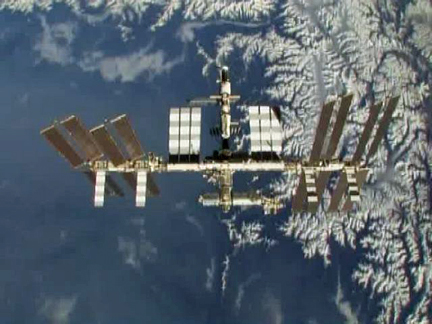
The International Space Station as seen from shuttle Endeavour
after undocking Friday. (Credit: NASA TV)
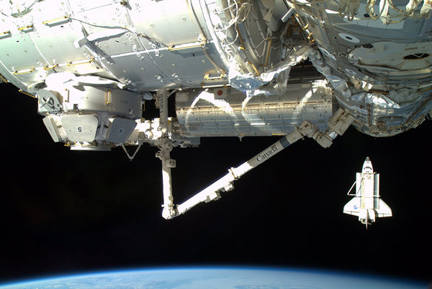
The shuttle as viewed from the space station. The new Tranquility
module and the multi-window cupola are visible in the foreground.
(Credit: NASA TV)
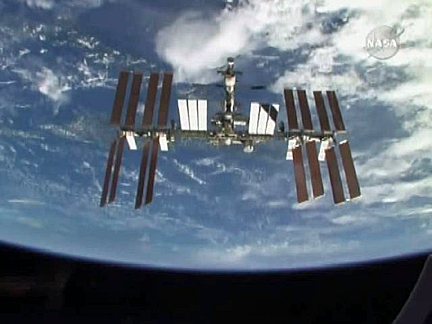
ISS approaching the limb of planet Earth. (Credit: NASA TV)
8:10 PM, 2/19/10, Update: Shuttle Endeavour undocks from space station (UPDATED at 9:05 p.m. with quotes, photos)
The shuttle Endeavour undocked from the International Space Station Friday, leaving a new habitation module and observation deck behind that virtually complete the U.S. segment of the lab complex after more than 11 years of construction.
With pilot Terry Virts at the controls, Endeavour pulled directly away from the station's forward docking port at 7:54 p.m. EST after nine days of joint activity.
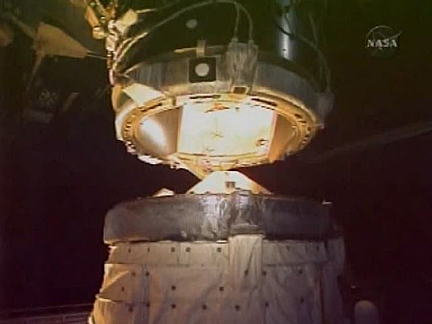
The shuttle Endeavour's docking system disengages its counterpart on
the International Space Station. (Credit: NASA TV)
"Zambo, it's been good having you, sorry to see you guys leave, enjoy the fly around," station flight engineer Timothy Creamer radioed. "We'll watch and wave."
"T.J. from Endeavour, thanks very much for the great hospitality," shuttle commander George Zamka replied. "We're sorry to go. Hope you get to enjoy Tranquility and the new view."
"Absolutely! And when you get back, write soon, OK?"
Station commander Jeffrey Williams, following naval tradition, formally announced the separation, saying "United States space shuttle Endeavour, departing," before ringing the ship's bell in the forward Harmony module.
At a distance of about 400 feet directly in front of the station, Virts planned to initiate a 360-degree photo-documentation fly around, looping up above the complex, directly behind and then below before a rocket firing to leave the area for good.
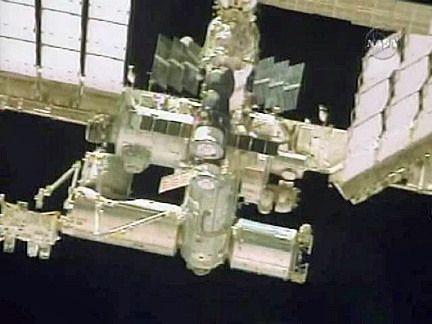
A view of the space station as Endeavour passed behind and below the
complex. The new Tranquility module is visible just to the left of
the Soyuz capsule in the center of the frame. (Credit: NASA TV)
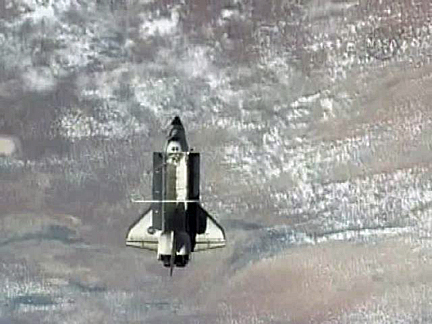
The shuttle Endeavour, viewed from the space station, passing above
Australia. (Credit: NASA TV)
"You guys are looking absolutely marvelous down there against the backdrop of the ocean and the clouds," Williams called at one point. "Terry, it looks like you're doing some smooth flying."
"Terry is making this an absolute pleasure trip around the International Space Station," Zamka said. "You guys look great as well. We had you back lit tremendously by the Himalayas and it is just a sight to behold. Looking forward to you guys seeing it when we get on the ground."
Zamka, Virts, Kathryn Hire, flight engineer Stephen Robinson and spacewalkers Robert Behnken and Nicholas Patrick plan to spend the rest of their "day" packing and inspecting the shuttle's reinforced carbon carbon nose cap and wing leading edge panels, which experience the most extreme heating during re-entry.
Using a laser scanner and camera on the end of a 50-foot extension to the shuttle's robot arm, the astronauts planned to look for signs of any micrometeoroid impact damage that might have occurred since an identical inspection the day after launch.
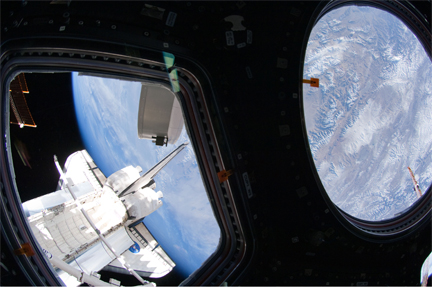
A view of shuttle Endeavour, before undocking, from the new cupola
module. (Credit: NASA)
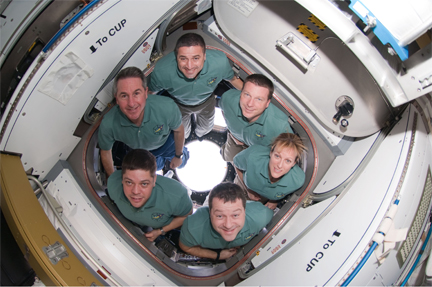
The Endeavour astronauts, posing in the cupola. Starting at the top
and going clockwise: George Zamka, Terry Virts, Kay Hire, Nicholas
Patrick, Robert Behnkwn and Stephen Robinson. (Credit: NASA)
"After undocking we have to perform another inspection like the one we did on flight day two, this time to check for damage that might have happened on orbit," Patrick said in a NASA interview. "And then we'll spend an entire day turning our orbiter back into a winged vehicle that can re-enter the Earth's atmosphere.
"So we'll get out all our suits and hang them up, ready to go the next morning for entry. We will set up all the seats and the communications lines and the oxygen lines and so on and we'll start putting away everything we've used during the mission, such as clothing. We carry huge bags of supplies for station. The bags may now be largely empty or full of foam that we're returning from station, but they need to be put safely away ... and that takes about a day, that process."
Landing back at the Kennedy Space Center is scheduled for 10:16 p.m. Sunday, but nearby showers could cause problems. The forecast also calls for rain near the shuttle's backup landing site at Edwards Air Force Base, Calif.
5:30 PM, 2/19/10, Update: Shuttle crew preps for undocking
The Endeavour astronauts are prepping the shuttle for undocking and separation from the International Space Station this evening, leaving the lab complex more than 98 percent complete after the delivery of a new habitation module and multi-window cupola.
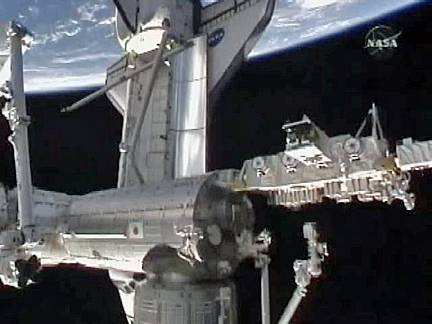
Shuttle Endeavour over the Pacific Ocean Friday. (Credit: NASA TV)
Aboard the space station, meanwhile, commander Jeffrey Williams and T.J. Creamer plan to carry out a detailed internal inspection of the lab's U.S. water recycling racks to look for any signs of a leak or other problem that might explain the apparent loss of about two pints of urine.
The loss was noted after the water processing racks were moved into the new Tranquility module and reactivated. Engineers do not believe any urine actually leaked out of the processor's plumbing, but it's not yet clear what went wrong during two attempts to re-activate the urine processing system. The inspections will not conflict with Endeavour's scheduled undocking.
With pilot Terry Virts at the controls, undocking is planned for 7:54 p.m. EST. Virts plans to pull out directly in front of the station before beginning a 360-degree photo-documentation fly around.
"Undocking day's always a big day for the pilot because we get to fly the undocking and so that's going to be a lot of fun," Virts said in a NASA interview. "We're going to slowly back away from the station. At about 400 feet, we'll start to fly up above the station. We're going to fly a 600-foot circle around it and we should get some great views.
"What we'll be seeing will be the first time that the station is in basically its final configuration. We'll see node 3 (Tranquility), the cupola, all the major station modules will be there at that point and so that's going to be a lot of fun."

Cosmonauts Oleg Kotov, left, and Maxim Suraev visit Endeavour's
flight deck Thursday. (Credit: NASA TV)
At the end of the fly around, Virts and commander George Zamka will oversee a rocket firing around 9:37 p.m. to leave the area. The shuttle astronauts plan to spend the rest of their "day" inspecting the ship's reinforced carbon carbon nose cap and wing leading edge panels to look for any signs of micrometeoroid impact damage that might have occurred since a similar inspection the day after launch.
"The whole crew will be involved in doing a late inspection where we take the boom sensor system and we move it around the shuttle to look to make sure there hasn't been any damage to the shuttle while we were in space, during our, roughly, two weeks in space," Virts said.
A mission status briefing is planned for 1:30 a.m. Saturday and the crew will call it a day at 7:14 a.m. The astronauts plan to pack up and test Endeavour's entry systems overnight Saturday.
Landing back at the Kennedy Space Center is targeted for 10:16 p.m. Sunday, weather permitting. The forecast for Sunday and Monday night at both Kennedy and Edwards Air Force Base, Calif., calls for showers, or a chance for showers, within 30 nautical miles.
Here is an updated timeline of today's activity (in EST and mission elapsed time; includes revision M of the NASA television schedule):
EST........DD...HH...MM...SS...EVENT 02/19 03:14 PM...11...11...00...00...Crew wakeup 05:09 PM...11...12...55...00...ISS daily planning conference 05:45 PM...11...13...30...53...US Arrays Feathered 05:59 PM...11...13...45...00...Group B computer powerup 06:07 PM...11...13...53...14...Sunset 06:39 PM...11...14...24...54...Maneuver to Undock Attitude 06:42 PM...11...14...28...37...Sunrise 07:07 PM...11...14...52...53...Orbiter/ISS in Undock Attitude 07:09 PM...11...14...55...00...Undocking timeline begins 07:10 PM...11...14...56...38...Noon 07:38 PM...11...15...24...39...Sunset 07:44 PM...11...15...30...00...Russian Segment Arrays Feathered 07:54 PM...11...15...40...00...Undocking 07:55 PM...11...15...41...00...Initial Separation Pulses 07:55 PM...11...15...41...40...ISS Holds Current Attitude 07:59 PM...11...15...45...00...Range = 50 feet 08:01 PM...11...15...47...00...Range = 75 feet 08:14 PM...11...16...11...00...Sunrise 08:14 PM...11...16...12...00...RS Arrays Resume Tracking 08:23 PM...11...16...09...00...Range = 400 ft; Start Flyaround 08:32 PM...11...16...18...30...Range = 600 feet 08:32 PM...11...16...18...31...US Arrays Resume Tracking 08:33 PM...11...16...18...54...ISS Maneuver to normal attitude begins 08:34 PM...11...16...20...30...Shuttle directly above ISS 08:42 PM...11...16...28...08...Noon 08:46 PM...11...16...32...00...Shuttle directly behind ISS 08:57 PM...11...16...43...30...Shuttle directly below ISS 09:09 PM...11...16...55...00...Sep 1 Burn 09:10 PM...11...16...56...05...Sunset 09:37 PM...11...17...23...00...Sep 2 Burn 09:39 PM...11...17...25...00...Post-undocking PGSC reconfig 09:54 PM...11...17...40...00...Group B computer powerdown 10:09 PM...11...17...55...00...Crew meals begin 10:34 PM...11...18...20...00...Playback ops 02/20 12:19 AM...11...20...05...00...Starboard wing survey 01:30 AM...11...21...16...00...Mission status briefing on NTV 01:59 AM...11...21...45...00...EVA unpack and stow 02:04 AM...11...21...50...00...Nose cap survey 02:54 AM...11...22...40...00...Post EVA entry preps 02:54 AM...11...22...40...00...Port wing survey 04:39 AM...12...25...00...00...LDRI downlink 07:14 AM...12...03...00...00...STS crew sleep begins 08:00 AM...12...03...46...00...Daily highlights on NTV 03:14 PM...12...11...00...00...Crew wakeup
03:40 AM, 2/19/10, Update: Shuttle astronauts return to Endeavour, prepare for undocking Friday night; engineers troubleshoot apparent urine leak in station recycling system
The Endeavour astronauts bid their space station colleagues farewell early Friday, sharing hugs and handshakes before returning to the shuttle and closing hatches in preparation for undocking Friday evening.
"It's been an awesome mission, you guys did a great job," station commander Jeffrey Williams told the shuttle crew. "Congratulations on all the work with the (new Tranquility) module and getting the (life support system) racks moved, the cupola, we're really going to enjoy the view. Wish you guys could stay a little longer."
"We will if you'll keep us," joked shuttle spacewalker Nicholas Patrick.
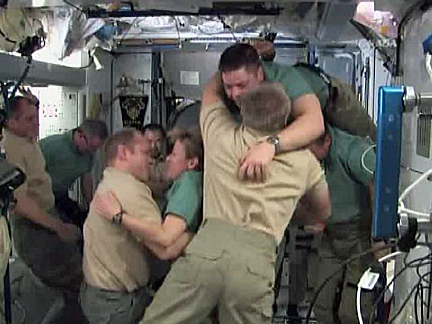
Robert Behnken (top right) hugs space station flight engieneer
Maxim Suraev while Kay Hire embraces Oleg Kotov before departing
the station. (Credit: NASA TV)
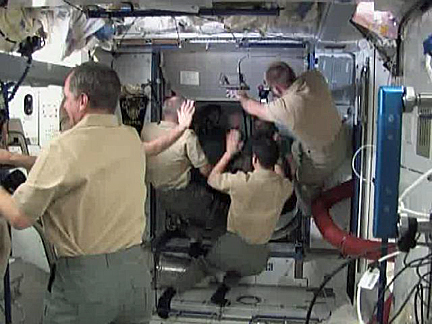
The station crew waves farewell to the departing shuttle astronauts.
(Credit: NASA TV)
Hatches between Endeavour and the space station were closed at 3:08 a.m., setting the stage for Endeavour's undocking at 7:54 p.m. Friday and landing back at the Kennedy Space Center Sunday night, weather permitting.
Space station engineers, meanwhile, are troubleshooting an apparent urine leak in the lab's water recycling system that has resulted in about two pints of waste water "that is not where we think it should be," said shuttle Flight Director Kwatsi Alibaruho.
The problem developed after the astronauts moved the station's two water recycling system racks, along with the NASA toilet, from the Destiny lab module to Tranquility.
"After we finished relocating the racks yesterday and we started to power up the system, part of that nominal power up sequence involves transferring about a half liter (about 1 pint) of urine from the waste and hygiene compartment system to the waste tank storage assembly," Alibaruho said.
"When that transfer was complete, what we would normally expect to see is a pressure-quantity increase in the tank and for that pressure and quantity to remain stable. What we saw was, we saw the quantity increase and after we finished the transfer, it went right back down, which suggested to us that the tank was not holding the liquid that was being moved into it. We repeated the procedure again today after doing some other reconfiguration and saw the same thing, it was about a half liter.
"So essentially, we've got a full liter of fluid that is not where we think it should be," he said.
There are two possibilities. Either the urine has leaked through a flow control valve into downstream plumbing or it has leaked out of the tank and is floating freely in the recycling system rack.
"We do not think it's the latter, because obviously there would be fairly conspicuous secondary indications if you had a liter ball of urine floating around in the cabin," Alibaruho said. "We've had none of those indications, no odors, no sign of water in and around that rack."
The station astronauts plan to open the rack in question overnight Friday "so they can inspect the valve, inspect the fluid fittings, all the plumbing in and around that tank to try to help us identify what the problem is," Alibaruho said.
"The engineers suspect they may know in general the area where the problem is, but we won't be able to verify until we get some hands into that rack and some eyes on the equipment," he said. "But we've got good reason to believe that it is probably not an external leak from the tank into the cabin."
Spare parts are available on the station to address a variety of problems and in the meantime, the toilet in the Tranquility module is operational. But until the problem is resolved, the astronauts will have to offload urine into a limited number of Russian storage tanks.
"Based on the supply of (tanks) we have available for this use, we need to get to the resolution of this within about two days, maybe three," Alibaruho said.
After that, "we will be in a situation where we have got to basically all use the Russian toilet, and then we've got another set of logistic challenges there, or maybe think about venting the fluid (overboard), which of course there are a bunch of other logistic challenges there."
"Basically, we've got spare components," Alibaruho said. "We've got to wrestle the system back to health within a couple of days, one way or the other."
Alibaruho started his NASA career as a space station life support systems officer and he said Endeavour's mission "represents the completion of a system that I was working on for a good 10 years before I became a flight director. And we knew this was going to be a barrel of laughs."
12:25 AM, 2/19/10, Update: Cupola ribbon cutting ceremony; crew praises 'phenomenal' view
Space station commander Jeffrey Williams and George Zamka, commander of the shuttle Endeavour, cut a ceremonial red ribbon late Thursday and declared the new cupola observation deck "open for business."
"Today, we are here in Tranquility standing above the cupola to formally open the cupola for use by other crews that will be here on the space station," Zamka said. "Arguably, mankind has been after this view for centuries, this perspective, this view of the world. And we finally have it, and we're going to take advantage and enjoy it."
"We on the station crew are especially happy to get this, to be able to enjoy this," Williams said. "I know for me personally it's a milestone that I will remember for the rest of my life."
He described the cupola as a "window on the world" marking the virtual completion of the International Space Station's assembly. He and Zamka then thanked the late Lacy Veach, an astronaut who participated in the cupola's initial design, and held up a container holding small moon rocks collected during the Apollo 11 mission and later carried to the top of Mount Everest.
"These moon rocks have had quite a journey and they will continue their journey for thousands and millions of miles in a very short amount of time," Zamka said. "They will be placed in the cupola as a reminder of man's reach and man's grit as they go out and explore."
Zamka then cut a ceremonial red ribbon and Williams said "the cupola is open for business! Let's take a look."
The combined shuttle-station crews then floated into the cupola one at a time to take in the view.

Space station commander Jeff Williams, left, and shuttle commander
George Zamka, display Apollo 11 moon rocks before cutting a ribbon to
formally open the new cupola module. (Credit: NASA TV)
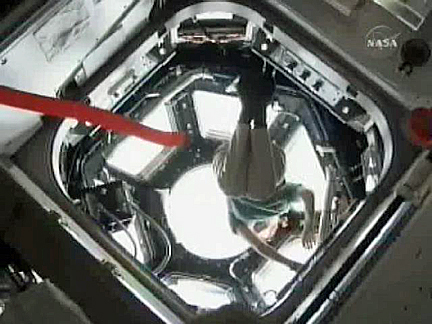
Astronaut Kay Hire takes in the view from the cupola. (Credit: NASA TV)
Endeavour's crew delivered and installed the new Tranquility habitation module and then mounted the cupola on its Earth-facing port. The seven-window cupola will be used as an observation deck and robotics work station, giving robot arm operators direct views of work sites and approaching cargo ships.
"It's so hard to put into words the view that we see out those beautiful seven windows," astronaut Kay Hire told reporters earlier. "It's (like) comparing a black-and-white analog picture to a super high-def color picture. It's just phenomenal what we can see out there. ... The most stunning thing I've seen so far is just some beautiful thunderstorms from above. It's really interesting to watch the way the lightning jumps from cloud to cloud far below us."
Endeavour pilot Terry Virts, making his first spaceflight, said all aspects of the experience have been "new and completely amazing."
"Getting to look out the shuttle windows and the station windows has been awesome," he said. "But when we looked out the cupola, it's impossible to put into words, but it took my breath away. We've only had a few opportunities to go down there because we have been busy inside doing work, but I think the favorite view that I've had has been watching a sunrise.
"At night, you can see cities if you're over land and then when you pass into the sunlight you get the blue limb (of Earth) and then it turns into pink and different colors like that and then when the sun pops up, it's like an instantaneous floodlight in your eyes, it kind of overwhelms you. But the view is amazing. You can sit there and ... perceive the entire Earth limb and you can really see the Earth has that round shape. It's just amazing."

An astronaut looks out of the cupola. (Credit: NASA TV)
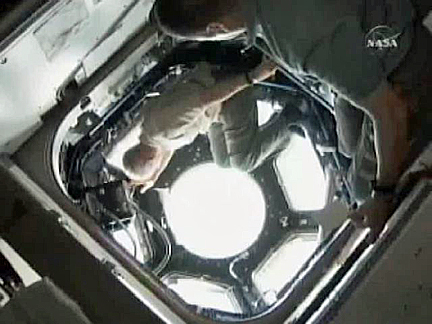
Williams enjoys a turn. (Credit: NASA TV)
Williams agreed, saying "to be able to see the entire Earth in one glance and see the entire limb of the Earth all the way around and see the spherical shape of the Earth is going to be new to us."
"Obviously, we've seen a lot of those segments of that view before, but only one segment at a time through a narrower field of view," he said. "We have taken a lot of photography up here, we will continue to do so. The cupola will offer us a very unique and new opportunity for photography in a new way, particularly with wide angle lenses, which we're already playing with a little bit to try to be able to share that experience with folks on Earth."
Spacewalker Robert Behnken said the view from the cupola rivaled and in some ways exceeded the view from a space helmet.
"The reason being you actually have time to look around through all the windows," he said. "Usually during a spacewalk, there's a fair amount of work to get done. ... There wasn't a lot of time for the sightseeing you might like to do out of a window like cupola.
"The other thing the cupola affords you is the opportunity to share some of those views with other people. We're really limited on the photography we can do during a spacewalk, but taking one of the HD cameras or some still photos inside the cupola is really going to allow us to share those beautiful sunrises and sunsets and Earth views in general with everyone on the ground."
05:30 PM, 2/18/10, Update: Astronauts wrap up station work, prepare to close hatches
The Endeavour astronauts are working through a busy day completing final transfers of equipment and experiment samples to and from the International Space Station before closing hatches between the two spacecraft in preparation for undocking Friday evening.
In a bit of welcome, if expected, news, the station's U.S. toilet, which was moved from the Destiny lab module into the new Tranquility module overnight Thursday, was declared open for normal use today in its new location.
"You have a 'go' to, uh, go," Robert Hanley called from mission control.
"OK," station astronaut Timothy Creamer laughed. "I'll go, then, so to speak."
A joint crew news conference is on tap at 9:39 p.m., followed by a ribbon-cutting ceremony for station's the new cupola observation deck at 11:39 p.m. A mission status briefing is scheduled for 2 a.m. Friday, with the crew's traditional farewell ceremony around 2:34 a.m. Hatches between the space station and Endeavour are scheduled to be closed about 10 minutes later. Undocking is targeted for 7:54 p.m. Friday, setting the stage for landing around 10:16 p.m. Sunday.

The shuttle Endeavour, docked to the International Space Station
Thursday. (Credit: NASA TV)
Here is an updated timeline of today's activity (in EST and mission elapsed time; includes revision L of the NASA television schedule):
EST........DD...HH...MM...EVENT 02/18 03:44 PM...10...11...30...Crew wakeup 05:19 PM...10...13...05...ISS daily planning conference 06:54 PM...10...14...40...Transfer ops 07:14 PM...10...15...00...Spacesuit install 09:39 PM...10...17...25...Crew news conference 10:19 PM...10...18...05...Joint crew photo 10:39 PM...10...18...25...Joint crew meal 11:39 PM...10...19...25...Cupola ribbon cutting 11:54 PM...10...19...40...ISS airlock tool stow 11:59 PM...10...19...45...PMA-3 repressurization 02/19 01:14 AM...10...21...00...Rendezvous tools checkout 02:00 AM...10...21...46...Mission status briefing on NTV 02:34 AM...10...22...20...Farewell ceremony 02:49 AM...10...22...35...Hatches closed 03:19 AM...10...23...05...ODS leak checks; centerline camera 04:24 AM...11...10...00...Evening planning conference 06:44 AM...11...02...30...ISS crew sleep begins 07:14 AM...11...03...00...STS crew sleep begins 08:00 AM...11...03...46...Daily highlights reel on NTV 03:14 PM...11...11...00...Crew wakeup
06:40 AM, 2/18/10: Life support equipment moved into Tranquility module
Amid troubleshooting to resolve problems outfitting the space station's new observation deck, the astronauts successfully moved two water processing racks, an oxygen generator and the U.S. segment's toilet into the Tranquility habitation module overnight Wednesday.
They also transferred 24 pounds of oxygen to the station's Quest airlock module, moved equipment from the station to the shuttle for return to Earth and fired Endeavour's maneuvering jets for about 33 minutes to boost the lab's mean altitude by about 1 nautical mile.
"The major activity for today was transferring the regenerative life support racks into node 3 (Tranquility), that's what the crew's been doing for most of the day and that has gone very well," lead Flight Director Bob Dempsey told reporters early Thursday. "The water recovery systems, racks one and two, the oxygen generation system and the waste and hygiene compartment have all been successfully transferred into node 3.
"The umbilicals that provide power, data and either take water to or from the racks or the appropriate supply consumables have all been mated and all the racks have been powered up. We are in the process of activating them now under the node 3 software."
The toilet is up and running with "an internal collection device so they can actually use it tonight even though the urine processing assembly, the UPA, is not fully activated," Dempsey said.
The astronauts installed a new distillation assembly centrifuge in the urine processing system earlier in the mission after unexpected high calcium levels caused problems for the previous unit. They also installed an external filter in the water processor to resolve a problem that had reduced the system's output. Dempsey said the urine recycling system appears to be working well and the station's U.S. oxygen generator "is in the process of being activated. Just like all the other racks, it takes a while to bring them up, warm them up, get them in their proper configuration for running."Earlier in the mission, the crew transferred a high-tech exercise device to Tranquility. Dempsey said shuttle commander George Zamka and pilot Terry Virts have been using the machine to help stay in shape for landing. A second exercise device, the COLBERT treadmill, will be moved into Tranquility after Endeavour departs.
The only problem of any significance is an interference issue that has prevented the astronauts from installing close-out panels in the multi-window cupola. The panels are needed to protect underlying equipment and to ensure that ventilation is properly routed. Until the issue is resolved, the crew cannot move a robot arm control station into the cupola as planned.
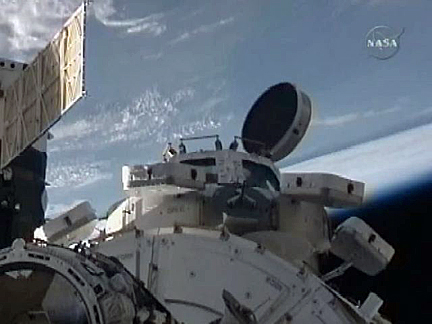
Shutters open on the cupola early Thursday. (Credit: NASA TV)
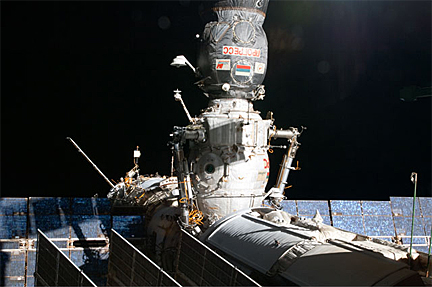
A dramatic view of the Russian Pirs docking module and a Progress
supply ship as seen from the cupola. (Credit: NASA)

Room with a view. (Credit: NASA)
"When the crew was installing the panels last night they ran into some obstructions that we had to go off and assess," Dempsey said. "Some of these obstructions are due to the common berthing mechanism that was used to berth the cupola to node 3, basically alignment guides, latches, that can be removed. We weren't planning to remove these, but at least some of them, we'll have to remove.
"There is one valve also that for some reason doesn't seem to fit our closeout panels quite right and we're actually going to have to make a small hole in one of the panels to accommodate that." he said. "But the crew has the procedures for that and hopefully if they have the time, they'll get to it tomorrow."
4:30 PM, 2/17/10: Astronauts await presidential call; focus on moving life support equipment to Tranquility
The combined crews of the International Space Station and the shuttle Endeavour expected a congratulatory call from President Obama Wednesday before a busy "day" of work to move life support system racks into the new Tranquility module. The president planned to call the astronauts from the Roosevelt Room of the White House at 5:15 p.m. EST.
Later this evening, water recycling equipment, the U.S. segment's toilet and oxygen generation system will be moved into the Tranquility module as the astronauts work to complete the new room's outfitting. When fully equipped, Tranquility will also will house the U.S. segment's carbon dioxide scrubber.
A new multi-window cupola attached to Tranquility's Earth-facing port eventually will house a robot arm control station, giving station arm operators direct views of work sites and approaching cargo craft. The astronauts had planned to move the work station into the cupola early Thursday, but resolution of an interference issue with other equipment forced a delay.
Here is an updated timeline of today's activity (in EST and mission elapsed time; includes revision J of the NASA television schedule):
EST........DD...HH...MM...EVENT 02/17 04:14 PM...09...12...00...Crew wakeup 05:14 PM...09...13...00...Crew downlink 05:49 PM...09...13...35...ISS daily planning conference 06:34 PM...09...14...20...Water recycling system rack demates 07:44 PM...09...15...30...SAFER checkout and swap 07:59 PM...09...15...45...WRS 1 transfer 08:44 PM...09...16...30...SAFER transfer 08:59 PM...09...16...45...WRS 2 transfer 08:59 PM...09...16...45...WRS 1 MT 10:39 PM...09...18...25...WHC transfer 11:39 PM...09...19...25...OGS demate 11:54 PM...09...19...40...EVA reconfig and transfer 02/18 12:09 AM...09...19...55...RWS cup relocate 01:24 AM...09...21...10...ISS airlock tool stow 02:28 AM...09...22...14...ISS reboost 04:44 AM...10...30...00...ISS evening planning conference 05:30 AM...10...01...16...Mission status briefing on NTV 07:14 AM...10...03...00...ISS crew sleep begins 07:44 AM...10...03...30...STS crew sleep begins 08:00 AM...10...03...46...Daily highlights 01:30 PM...10...09...16...Flight director update on NTV 03:44 PM...10...11...30...Crew wakeup
3:25 AM, 2/17/10: Spacewalk No. 3 ends
Astronauts Robert Behnken and Nicholas Patrick began repressurizing the space station's Quest airlock at 3:03 a.m. Wednesday, officially ending a five-hour 48-minute spacewalk.
"Hey Bob and Nick. Welcome back to the airlock," astronaut Kay Hire called. "Great job raising the curtains on the bay window to the world."
"Thank you, Kay. It was fun," Patrick replied. "I look forward to the view from the inside."
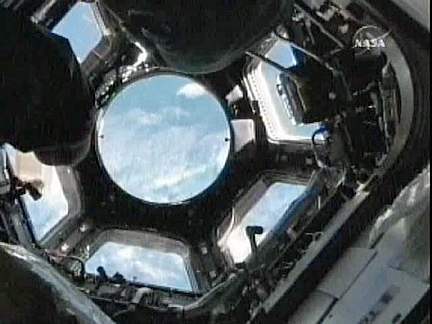
A view from inside the cupola with all seven of its windows
unshuttered. (Photo: NASA TV)
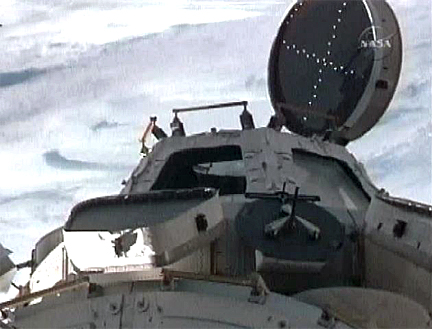
An external view of the cupola with its shutters open. (Photo: NASA TV)
Before re-entering the space station, Behnken and Patrick thanked flight controllers and their trainers.
"Thank you very much for those kind words, we all appreciate it," said Hal Getzelman in mission control "Right now, we're admiring your handiwork and I'm sure you guys are going to appreciate looking from the other side of the cupola out."
"We are looking forward to that," Patrick agreed.
"I don't think space station's ever going to be the same after this," said astronaut Stephen Robinson, the spacewalk co-ordinator.
This was the 140th spacewalk devoted to station assembly an maintenance since construction began in 1998, the sixth for Behnken and the third for Patrick. Total station EVA time now stands at 873 hours and 16 minutes while the total for Endeavour's mission is 18 hours and 14 minutes. Behnken's total through six EVAs is 37 hours and 33 minutes, putting him 22nd on the list of most experienced spacewalkers.
12:50 AM, 2/17/10: Tranquility cooling connected; cupola windows opened
The Endeavour astronauts briefly cranked open aluminum shutters protecting the windows in the space station's new observation deck early Wednesday, giving the crew inside an "absolutely incredible" vista of the Earth 220 miles below.
Spacewalkers Robert Behnken and Nicholas Patrick first removed insulation blankets from the cupola's seven windows late Tuesday and unbolted launch locks holding the aluminum shutters in place.
Astronauts Terry Virts and Kay Hire, standing by inside the cupola, then were cleared to crank open the shutters one at a time to test the deployment mechanisms, starting with the module's large central window.
"Terry and Kay, you are clear to open window number seven for a shutter check and get the first view out the cupola," Endeavour commander George Zamka called just after midnight.
"I see it opening," Patrick said from his perch outside. Live television views showed the disk-like shutter smoothly rotating open and out of the way.
"Well, as expected, the view from window seven is absolutely spectacular," station commander Jeffrey Williams marveled. "This has to be the largest window on board and when we have the others around it open, it'll give us a view of the entire globe. Absolutely incredible."
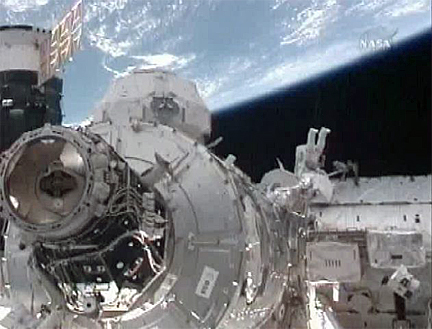
The cupola, covered with protective insulation, on the
Earth-facing port of the Tranquility module. (Photo: NASA TV)
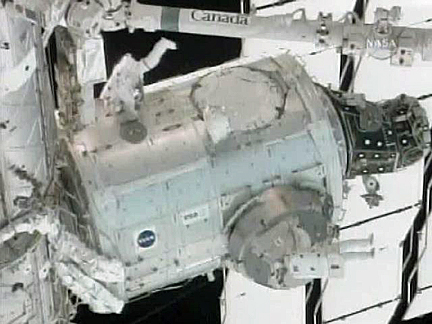
With insulation blankets removed, Patrick unbolts launch locks
from aluminum window shutters. (Photo: NASA TV)
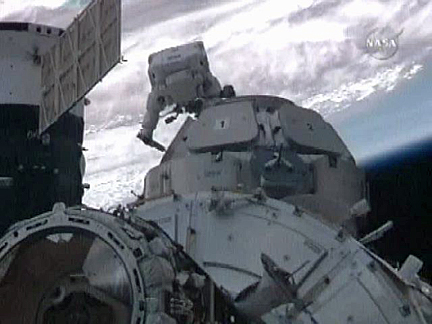
Patrick removes a final launch lock. (Photo: NASA TV)
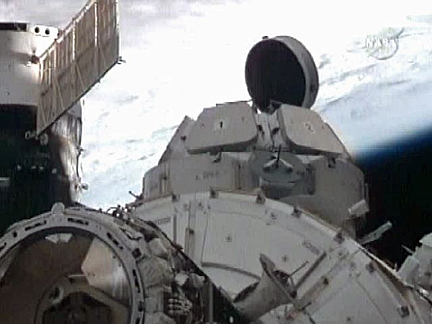
The central shutter cranks open. (Photo: NASA TV)
Earlier in the spacewalk, Behnken and Patrick activated a second ammonia coolant loop for the Tranquility module, removed a no-longer-needed keep-alive heater cable and connected power and data cables to a pressurized docking port on Tranquility's outboard port.
They then made their way to the cupola to remove the insulation and launch locks. There have been no problems of any significance and the cupola's systems appear to be working normally.
"Our wakeup music today on Endeavour was Jimmy Buffett's 'Window on the World,'" astronaut Steve Robinson observed. "I think that came from Kay's family."
"Ah, lovely," Patrick replied.
9:30 PM, 2/16/10: Spacewalk No. 3 begins
Astronauts Robert Behnken and Nicholas Patrick switched their spacesuits to battery power at 9:15 p.m. EST, officially starting a planned six-and-a-half-hour spacewalk to finish outfitting the new Tranquility module and to remove covers from a multi-window cupola.
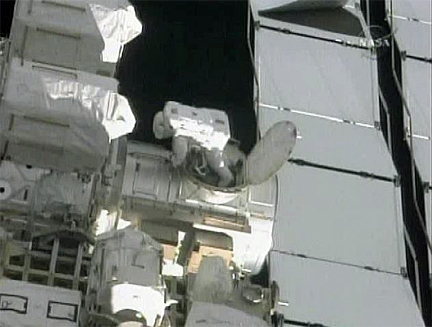
Astronaut Robert Behnken exits the space station's Quest
airlock module. (Photo: NASA TV)
"Bob and Nick, have a tremendous third EVA," shuttle commander George Zamka radioed the spacewalkers. "You guys are doing great work so far, let's get that other cooling loop fired up for node 3 and let's take the covers off (the cupola)."
5:25 PM, 2/16/10: Astronauts gear up for third spacewalk
Astronauts Robert Behnken and Nicholas Patrick are gearing up for a third and final spacewalk to activate a second ammonia coolant loop for the space station's new Tranquility module and to remove insulation and launch locks securing shutters to a seven-window observation deck.
The six-and-a-half-hour spacewalk is scheduled to begin at 9:09 p.m. EST when Behnken and Patrick switch their spacesuits to battery power. For identification, Behnken will be wearing a suit with red stripes around the legs while Patrick's suit is unmarked.
This will be the 140th spacewalk devoted to station assembly and maintenance since construction began in 1998, the fourth so far this year and the third for Behnken and Patrick.
The first major task will be to open valves routing ammonia coolant to and from Tranquility. The module was tied into one of the station's two independent coolant loops during the crew's second spacewalk, allowing engineers to power up Tranquility's internal systems. Coolant loop B will be activated this evening.
The astronauts will then remove a temporary "keep-alive" power cable that is no longer needed and complete outfitting of a pressurized docking port that was moved to Tranquility's outboard port late Monday.
From there, the astronauts will make their way to the cupola on Tranquility's Earth-facing port to remove protective insulation covering the observation deck's seven windows. They also will remove launch locks securing aluminum shutters that protect against micrometeoroid impacts.

The Tranquility module, center, with the insulation-covered
cupola facing up toward Earth. (Photo: NASA)

A cutaway showing an astronaut at the robotics work station
in the cupola. (Photo: ESA)
If all goes well, the windows will be uncovered for the first time, one at a time, starting around 12:30 a.m. Wednesday.
"The plan is, after the spacewalkers have removed the launch locks, we will then be able to open the shutters," said station Flight Director Bob Dempsey. "We want to open them while the spacewalkers are still out there so if there are any problems with these new shutters, they can go over and make sure they can be closed."
The cupola will provide spectacular panoramic views for Earth observation and serve as a robot arm work station, giving arm operators direct views of approaching cargo ships and maintenance sites. Robot arm computer displays and control equipment will be moved into the cupola overnight Wednesday.
Dempsey said all of the shutters will be opened during initial checkout while this evening's spacewalk is proceeding.
"At one point, we will have all the shutters open to sort of verify and get a view," Dempsey said. "The crew will be taking some video inside, we'll also see what video we can get outside with the windows during the spacewalk and after.
"I'm not sure we'll get a good view of the astronauts while they're out spacewalking from there. I hope to, but they need to be at least 10 feet away from the open shutters because the water that comes out of their evaporator cooling systems could contaminate the windows a little bit, plus we want to make sure that they're not near it so they physically don't kick or have any tools or anything that bump against the windows and possibly scratch them."
Built by Thales Alenia Space, the cupola weighs 1.6 tons, featuring six trapezoidal side windows and a 31.5-inch circular top window, the largest ever launched into space. Each window features a protective "scratch" pane on the interior side, two inch-thick pressure panes and a debris pane on the outside to protect against space debris impacts.

A simulated view through the cupola windows.
(Photo: European Space Agency)

The robotics work station in the cupola. (Photo: ESA)

A room with a view. (Photo: ESA)
When not in use, the windows will be covered by the aluminum shutters, which are manually cranked open and closed by the astronauts. The greatest threat from a debris standpoint is from the front, along the direction of the station's 5-mile-per-second velocity vector. Shutters on the forward-facing windows typically will remain closed unless visibility in that direction is needed. Trailing windows can remain open for longer periods.
"We do have a very long flight rule that deals with the operations of this particular set of equipment," Dempsey said. "The two most major concerns of operating the shutters are thermal and micrometeoroid debris. ... The debris concern, obviously, is more severe. There's not a lot of debris out there but it wouldn't take much for a small piece of debris coming through and damaging these windows.
"Even though they're reinforced to prevent anything happening to the crew, we want to keep them in good pristine condition so that over a long period of time, the crew will have good views since this will be used for not only Earth observations but for things like capturing, with the robotic arm, upcoming visiting vehicles.
"So as long as we can keep within these constraints, the crew can open the windows more or less as needed," Dempsey said. "The windows that are going into the velocity vector where you're more likely to have debris come in and strike it will be closed most of the time. The large round one that faces the Earth, or the nadir, side and the two rear facing ones ... those can pretty much be open as much as the crew wants. So we anticipate that they'll have that open a lot during the crew day to look out, take pictures, whatever they want to do. The other ones, just when they need it for operations."
The cupola robotic work station will be used during the next shuttle visit in April to remove a cargo carrier from Discovery's cargo bay and attach it to the station.
Here is an updated timeline of today's activity (in EST and mission elapsed time; includes revision I of the NASA television schedule):
EST........DD...HH...MM...EVENT 02/16 04:14 PM...08...12...00...STS/ISS crew wakeup 04:54 PM...08...12...40...EVA-3: 14.7 psi repress/hygiene break 05:39 PM...08...13...25...EVA-3: Airlock depress to 10.2 psi 07:19 PM...08...15...05...Cupola vestibule outfitting 07:34 PM...08...15...20...EVA-3: Spacesuit purge 07:49 PM...08...15...35...EVA-3: Spacesuit prebreathe 08:39 PM...08...16...25...EVA-3: Crew lock depressurization 08:49 PM...08...16...35...Cupola audio terminal install 09:09 PM...08...16...55...EVA-3: Spacesuits to battery power 09:14 PM...08...17...00...EVA-3: Airlock egress/setup 09:39 PM...08...17...25...EVA-3: EV1: Open loop B QDs 09:39 PM...08...17...25...EVA-3: EV2: PMA-3 HD cable install 09:49 PM...08...17...35...Cupola UDP install 10:09 PM...08...17...55...EVA-3: EV1: Node 3 LTA cable demate 10:29 PM...08...18...15...MTL sample tool install 10:39 PM...08...18...25...EVA-3: Cupola MLI removal 11:49 PM...08...19...35...EVA-3: EV1: Node 3 outfitting 11:49 PM...08...19...35...EVA-3: EV2: Cupola launch locks 02/17 12:29 AM...08...20...15...EVA-3: EV2: APFR relocation 12:34 AM...08...20...20...Cupola window shutters opened 12:44 AM...08...20...30...Cupola FSS fill 12:49 AM...08...20...35...EVA-3: EV2: VSC video cable routing 12:54 AM...08...20...40...Cupola panel install 01:09 AM...08...20...55...EVA-3: EV1: VSC video cable routing 02:09 AM...08...21...55...EVA-3: Get aheads; node 2 CBM ops 03:09 AM...08...22...55...EVA-3: Cleanup and ingress 03:39 AM...08...23...25...EVA-3: Airlock repressurization 03:54 AM...08...23...40...Spacesuit servicing 04:14 AM...09...00...00...Node 1 Airlock/ITCS reconfig 05:30 AM...09...01...16...Mission status briefing on NTV 07:44 AM...09...03...30...ISS crew sleep begins 08:14 AM...09...04...00...STS crew sleep begins 09:00 AM...09...04...46...Daily highlights reel on NTV 01:30 PM...09...09...16...Flight director's update on NTV 04:14 PM...09...12...00...Crew wakeup
04:20 PM, 2/16/10: Next shuttle launch slips to April 5
Launch of shuttle Discovery on the next mission to the International Space Station will slip from March 18 to April 5 because of an unusual cold snap in Florida that has delayed processing and to avoid having a shuttle at the lab when the next Russian Soyuz crew transport arrives.
The shuttle must launch into the plane of the space station's orbit to reach the outpost and the launch window moves about 24 minutes earlier each day. Because of the delay to April 5, liftoff will move from daylight to predawn darkness at around 6:27 a.m. EDT. Assuming an on-time launch, landing would be expected around 12:30 a.m. on April 18.
The goal of shuttle mission STS-131 is to deliver science racks to the station, along with supplies and other equipment. Three spacewalks are planned to replace an ammonia coolant tank, to change out a rate gyro assembly and to retrieve an external Japanese experiment.
NASA had hoped to haul Discovery to the pad this week for a launch on March 18. But unusually low temperatures, which can cause problems for the shuttle's maneuvering jets, delayed Discovery's move from its hangar to the Vehicle Assembly Building for attachment to an external tank and solid rocket boosters.
NASA could have had Discovery ready for launch in late March, but a Russian Soyuz crew transport mission is scheduled for take off April 2 and it could arrive before the shuttle departed, depending on the shuttle's launch date. Space station managers opted to avoid the complexities associated with "dual docked ops," agreeing to delay Discovery to April 5, the day after Easter.
Rollout to the pad is targeted for March 2, followed by a dress-rehearsal countdown with the crew March 5. An executive-level flight readiness review to assess processing and set an official launch date is planned for March 26.
How the delay for Discovery might impact NASA's three subsequent shuttle missions is not yet clear. The final flight is currently targeted for launch Sept. 16.
9:50 PM, 2/15/10: PMA-3 attached to Tranquility
Astronauts operating the space station's robot arm Monday moved a pressurized docking port from a temporary storage location on top of the space station's forward Harmony module to the recently vacated outboard port on the new Tranquility habitation module.
Robert Behnken and Nicholas Patrick maneuvered pressurized mating adaptor No. 3 into position around 9 a.m., making fine adjustments as needed to line up four sets of motorized bolts in the common berthing mechanism.
The bolts then were driven home in a two-stage procedure, firmly locking PMA-3 to Tranquility by 9:28 p.m.
Before the shuttle Endeavour's launching, PMA-3 was bolted to the Unity module's left side hatch. To clear the way for attachment of Tranquility, PMA-3 was moved to the Harmony module's zenith port.
Tranquility, launched with a seven-window cupola on its outboard hatch, was attached to Unity's left-side port last week. The cupola was detached and moved to Tranquility's Earth-facing, or nadir, port early Monday. That cleared the way for PMA-3 to be mounted in its place on the outboard end of Tranquility.
Inside the space station, meanwhile, the astronauts opened up the cupola Monday evening and began its initial outfitting. During the crew's third and final spacewalk overnight Tuesday, Behnken and Patrick plan to pull off two large insulation blankets protecting the cupola's seven windows and remove launch locks holding aluminum shutters in place.
At some point after that, the astronauts will open the shutters and enjoy a panoramic view of Earth. A robot arm control station will be moved into the cupola Wednesday.
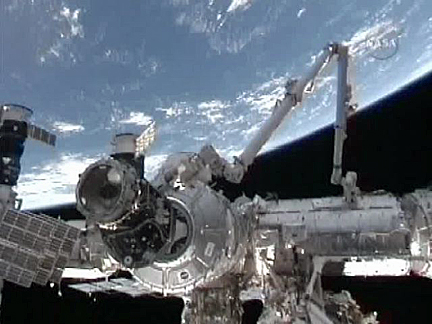
PMA-3 is positioned near the outboard port of the Tranquility
module. (Photo: NASA TV)
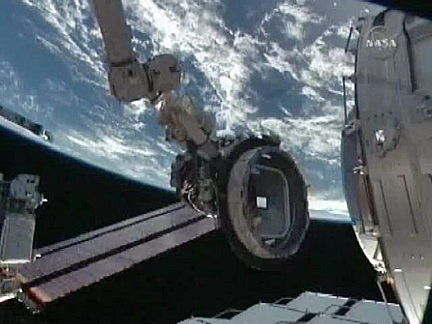
Another view showing PMA-3 lined up for docking at Tranquility.
(Photo: NASA TV)
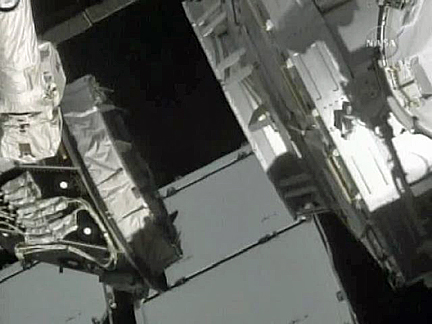
PMA-3, left, being driven into Tranquility's outboard port.
(Photo: NASA TV)
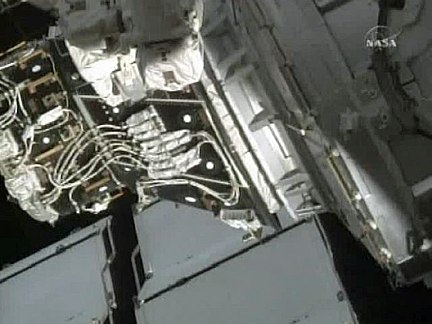
Mission accomplished. (Photo: NASA TV)
6:45 PM, 2/15/10: Astronauts prepare to move mating adaptor; off-duty time on tap
The Endeavour astronauts are preparing to move a pressurized mating adaptor docking port from the top of the Harmony module at the front end of the International Space Station to the outboard end of the new Tranquility module on the left side of the lab complex.

The Tranquility module, center, with the cupola facing Earth.
PMA-3 will be attached to Tranquility's outboard port, extending
out above the radiators visible at the left. (Photo: NASA TV)

PMA-3, center, atop the Harmony module with the station's robot
arm attached. (Photo: NASA TV)
Pressurized mating adaptor No. 3 will be attached to the same port used by the multi-window cupola observation deck for launch aboard the shuttle. The cupola was successfully moved from Tranquility's outboard port to its Earth-facing hatch early Monday.
Using the station's robot arm, the astronauts plan to detach PMA-3 from Harmony's zenith port around 7 p.m. and attach it to Tranquility's outboard port starting around 8:39 p.m.
After two spacewalks and extensive robotics operations, the astronauts looked forward to a half-day off beginning at 11:39 p.m. A procedures review for a third and final spacewalk over night Tuesday is on tap at 4:09 a.m. and crew sleep is scheduled to begin at 8:14 a.m.
Here is an updated timeline of today's activity (in EST and mission elapsed time; includes revision I of the NASA television schedule):
EST........DD...HH...MM...EVENT 02/15 04:14 PM...07...12...00...Crew wakeup 05:44 PM...07...13...30...ISS daily planning conference 06:29 PM...07...14...15...PMA-3 pressure check 07:09 PM...07...14...55...Cupola vestibule outfitting (part 2) 07:59 PM...07...15...45...PMA-3 maneuver 08:34 PM...07...16...20...PMA-3 installation 08:49 PM...07...16...35...PMA-3 first stage bolts 08:59 PM...07...16...45...Cupola ATU install 09:14 PM...07...17...00...PMA-3 second stage bolts 09:59 PM...07...17...45...Cupola UDP install 10:09 PM...07...17...55...SSRMS ungrapple 10:09 PM...07...17...55...Crew meals begin 11:39 PM...07...19...25...Crew off duty 02/16 04:09 AM...08...00...00...EVA-3: Procedures review 05:19 AM...08...01...05...Evening planning conference 05:30 AM...08...01...16...Mission status briefing on NTV 06:39 AM...08...02...25...EVA-3: Mask pre-breathe 07:24 AM...08...03...10...EVA-3: Airlock depress to 10.2 psi 07:44 AM...08...03...30...ISS crew sleep begins 08:14 AM...08...04...00...STS crew sleep begins 09:00 AM...08...04...46...Daily highlights reel on NTV 01:30 PM...08...09...16...Flight director update on NTV 04:14 PM...08...12...00...Crew wakeup
1:45 AM, 2/15/10: Cupola attached to Tranquility's Earth-facing port (UPDATED at 3:45 a.m. with flight director comments)
After resolving minor problems with a pair of balky bolts early Monday, the Endeavour astronauts moved a multi-window cupola to the new Tranquility module's Earth-facing port where the observation deck will provide bay-window views for robot arm operators.
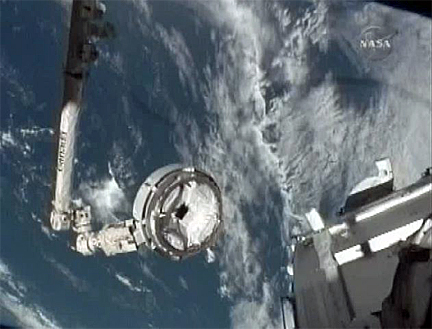
The cupola, on the end of the station's robot arm, nearing
the Tranquility module's Earth-facing port. (Photo: NASA TV)
Initial attempts to detach the cupola from Tranquility's outboard port ran into a snag late Sunday when at least two motorized bolts in the docking mechanism failed to disengage. The common berthing mechanism features four sets of motorized bolts.
"We had some initial challenges with unbolting the cupola from the port side and that was basically due to higher than expected running torques on the bolts," said shuttle Flight Director Kwatsi Alibaruho. "The cupola was bolted to the port side of node 3 on the ground so we just had to apply slightly higher torque than what we had expected, just by a few newton meters."
The control software, in its default mode, was limited to applying a a maximum torque of about 22 foot-pounds. When that didn't work, flight controllers sent commands to increase the torque and the bolts released at about 27 foot-pounds.
"So not a problem at all, just a minor adjustment we had to make," Alibaruho said. He described the problem as "analogous to a situation where if you had a piece of equipment from the manufacturer that's got screws or bolts in it, they tend to be bolted down fairly tight. Once you release that initial torque ... the subsequent torque that you experience on those bolts tends to be a little bit less. Same type of situation, but no indication of off-nominal performance of the mechanism at all."
After the common berthing mechanism disengaged, astronauts Kay Hire and Terry Virts, operating the space station's robot arm, moved the cupola into position for attachment at Tranquility's nadir port.
Motorized bolts drove home in two stages, completing the attachment procedure at 1:31 a.m. The astronauts planned to work on outfitting the vestibule between Tranquility and the cupola later this morning, but they do not plan to open the hatch and go inside until overnight Monday.
The cupola features six canted windows and a central overhead pane. While it will give station crews panoramic views of Earth, the primary goal is to give robot arm operators direct views of approaching unmanned cargo ships. Computer displays and equipment for controlling the station's robot arm will be moved into the cupola overnight Wednesday.
Launch locks and protective window covers will be released during a spacewalk overnight Tuesday.
12:30 AM, 2/15/10: Cupola bolts and latches released
Resolving a problem with jammed bolts, ground controllers uplinked commands early Monday that successfully freed a multi-window cupola from the space station's new Tranquility module. Astronauts Terry Virts and Kay Hire, operating the station's robot arm, then began the slow process of moving the cupola from Tranquility's outboard port to an Earth-facing hatch. Once in place, the cupola will provide picture-window views of Earth and give robot arm operators direct views of approaching cargo ships.
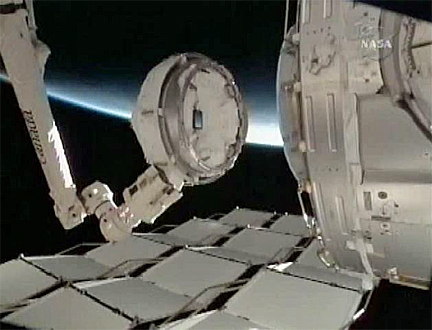
The cupola, attached to the station's robot arm, is removed
from the Tranquility module's outboard port. (Photo: NASA TV)
11:25 PM, 2/14/10: Cupola move held up by apparently stuck bolts
Initial attempts to detach a multi-window cupola from the space station's new Tranquility module so it can be moved to a different port ran into a snag late Sunday when at least two motorized bolts in the docking mechanism failed to disengage.
The space station's robot arm locked onto the cupola in preparation for the move earlier in the evening, after it was depressurized. The crew then began sending commands to back out the bolts holding it in place. The common berthing mechanism features four sets of motorized bolts.

The cupola, mounted on the end of the Tranquility module, extends
out of the frame to the left toward the viewer. The station's
robot arm is locked on. (Photo: NASA TV)

A closeup showing the robot arm locked onto the cupola.
(Photo: NASA TV)
Station commander Jeffrey Williams notified mission control when one of the bolts in the third set failed to back out.
"And Houston, you see the three-dash-three-R bolt jammed status? Master command status has failed," WIlliams reported.
"OK, Jeff, we see that and we'd like you to step into the procedure 2.401 in the struc-and-mech book," Hal Getzelman radioed from Houston, referring to a structures-and-mechanisms procedure book.
Williams then made another attempt and a second bolt indicated it was jammed. He was told to stand by while engineers assessed the issue.
To fit in the shuttle Endeavour's cargo bay, the cupola had to be launched "in line," attached to Tranquility's outboard port. But it is intended to operate on the module's Earth-facing port to give robot arm operators good views of approaching cargo ships. The seven-window cupola also will give station crews spectacular views of Earth.
5:25 PM, 2/14/10: Astronauts cleared to move cupola to permanent port
The Endeavour astronauts have been cleared to move a multi-window cupola from the outboard port of the new Tranquility module to its Earth-facing hatch after engineers concluded an interference issue with a protective cover would not prevent a normal docking.
To fit in Endeavour's cargo bay, the cupola had to be launched on Tranquility's outboard port but it is intended to serve as an observation deck and robot arm control station and for that it needs to be on the module's Earth-facing, or nadir, port.
Preparing for the move, the astronauts attempted to install a protective cover over the outboard hatch's docking mechanism to protect it from low temperatures and micrometeoroid impacts after the cupola was removed. But a mechanical interference issue prevented the crew from locking the cover in place.
Station commander Jeffrey Williams ultimately succeeded after removing underlying bolts, allowing the so-called "towel bar" latching mechanism to engage. But clearances were tight and engineers were unsure whether a similar cover on the nadir port could prevent the cupola's attachment.
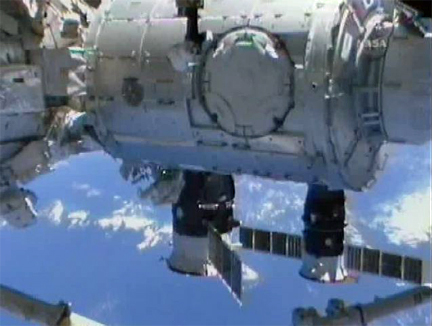
The cupola, protected by insulation blankets and covers, is
visible extending out of the frame to the right on the
outboard port of the Tranquility module. A protective hatch
cover like the one with an interference issue on the cupola port can be
seen on the hatch facing the camera. (Photo: NASA TV)
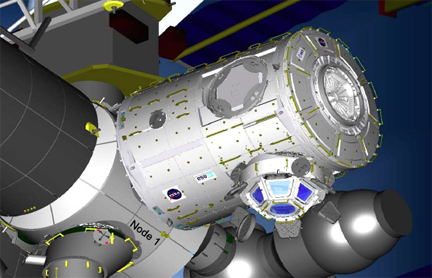
A drawing showing the cupola in its final position attached
to Tranquility's nadir port. (Photo: NASA)
After extensive analysis, engineers concluded the tolerances were acceptable and during the morning wakeup call, the astronauts were cleared to proceed.
"The good news for today is, overnight we looked at all the information you gathered for us yesterday and sent down and we became very comfortable with you doing the cupola depress and relocate today," said Shannon Lucid in mission control. "So that's our plan."
"Shannon, that's fantastic news," replied astronaut Nicholas Patrick from Endeavour. "Thank you to all on the ground who worked on that so hard overnight. There are cheers from downstairs as everybody is waking up. And to all in mission control and Houston and elsewhere, happy Valentine's Day."
The crew plans to depressurize the cupola starting around 6:51 p.m. EST. Terry Virts and Kay Hire, operating the station's robot arm, then will lock onto a grapple fixture on the side of the cupola just after 9 p.m. After Williams disengages the common berthing mechanism holding the cupola in place, Virts and Hire will move it to Tranquility's nadir port.
The unberthing procedure is expected to begin around 10:44 p.m. If all goes well, installation on the nadir port will begin around 11:30 p.m.
Engineers will be monitoring how much torque is required to drive the motorized bolts in the berthing mechanism that will lock the cupola to the nadir port. No problems are expected, but if high torque levels indicate unacceptable interference, the procedure will be aborted. In that case, the cupola likely would be returned to the outboard port pending additional analysis.
03:45 AM, 2/14/10: Spacewalk No. 2 ends; coolant routed to new module (UPDATED at 6:45 a.m. with post-EVA briefing)
After successfully hooking up ammonia coolant lines to the new Tranquility module, astronauts Robert Behnken and Nicholas Patrick returned to the space station's Quest airlock to check for contamination while flight controllers finished powering up the module's electrical systems.
Despite the release of a small amount of ammonia early in the mission, Patrick's suit was not contaminated and Flight Director Bob Dempsey said engineers successfully powered up the new module, a major milestone for the shuttle Endeavour's mission.
"It was an extremely exciting and successful day on the International Space Station, one that I'm very proud of," Dempsey said. "The team has been working for over two years to make today happen. And it did, and it was extremely successful and I'm very pleased with the way it has gone.
"Everything was accomplished as we had planned," he said. "The main objective, of course, was hooking up the ammonia lines. The ammonia lines provide cooling to the electronics and systems of the node 3 (Tranquility) module and integrates it into the cooling system of the space station. That was performed today, which allowed us to begin actually powering up the module for the first time."
As planned, only one of the two ammonia coolant loops was activated. The second loop will be activated during a spacewalk overnight Tuesday. But with one loop circulating coolant to and from the new module, flight controllers were able to complete the power-up sequence, activating lights, ventilation, computer systems and air conditioning.
The only problem occurred early in the spacewalk when Patrick was sprayed by a small amount of ammonia when he uncapped a line. The astronauts continue the spacewalk as planned, but they returned to the airlock early and worked through a procedure to make sure no toxic ammonia made it into the station.
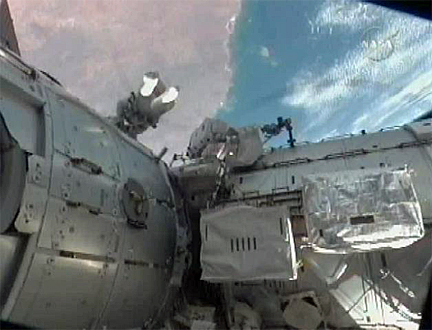
The space station passes above the western coast of Australia.
(Photo: NASA TV)
Patrick did not believe any ammonia had adhered to his spacesuit and a test showed none was present. The astronauts then were cleared to re-enter the station.
"This is something we've seen before, it's not unexpected necessarily, and we had prepared for it," Dempsey said. "We did go through some decontamination procedures during the EVA, just sort of inspecting and timing what we call a 'bake out.' We did come in a little bit early to make sure we had enough consumables to complete all our other decontamination procedures, which we did. No ammonia was detected, everything was fine."
The spacewalk already was officially over by that point, ending at 3:14 a.m. EST for a duration of five hours and 54 minutes. Over two spacewalks, Behnken and Patrick have logged 12 hours and 26 minutes of EVA time, pushing the station total to 867 hours and 28 minutes over 139 spacewalks.
Connecting the ammonia lines was one of the top priorities of Endeavour's mission.
"You'll be pleased to know that cooling is flowing through node 3 and our temperatures are dropping and we're continuing with the node 3 activation," Hal Getzelman radioed from mission control.
"Outstanding!" Stephen Robinson replied from the shuttle Endeavour's flight deck. "Outstanding, that's great. We're so happy our feet are off the floor."
Behnken and Patrick had no problems deploying a long sheet of multi-layer insulation and the four long ammonia hoses needed to connect Tranquility to the station's cooling system. The astronauts then had to wrap the hoses in the insulation.
"I am enjoying watching you," shuttle commander George Zamka said at one point "You are making this look very easy despite how hard we thought it was going to be."
"All those practice runs in the pool seem to be helping," Patrick said.
"Yeah, they sure do. I mean, you guys are making it look like regular duct work up there."
"Actually getting a chance to go to Huntsville (Ala.) and see the hardware makes a difference," Behnken said.
"Oh yeah, this is the second time, at least, that you all are seeing this, which must help a lot," Zamka said.
"Hugely."
While the spacewalk was going on, station commander Jeffrey Williams continued troubleshooting an interference issue that has prevented the crew from installing a protective cover over the hatch mechanism of Tranquility's outboard port where a multi-window cupola currently is attached.
The astronauts need to move the cupola from the outboard hatch to Tranquility's Earth-facing port, but the move is on hold pending resolution of the interference issue.
Williams removed two protruding bolts that were contributing to the interference and while that appeared to resolve the matter in theory, clearances remained very tight and Dempsey said engineers were not comfortable with proceeding.
"It does fit," Dempsey said of the protective cover. "Unfortunately, it doesn't appear we have the clearance that we were hoping to get. We thought we would have about (two tenths of an inch) clearance and it looks like it's very thin, maybe 1/32nd of an inch. Therefore, we're not sure yet that we are comfortable in relocating the cupola with this potential interference. So the teams are continuing to look at options."
Dempsey said the space station's repaired urine recycling equipment appears to be working well, but another part of the water processing system is operating in a degraded mode, putting out less water than expected. Dempsey said the system's output is stable, but engineers are continuing to evaluate its performance.
12:15 AM, 2/14/10: Coolant lines connected; Patrick reports minor ammonia release
Spacewalkers Robert Behnken and Nicholas Patrick connected ammonia coolant supply and return lines between the new Tranquility module and the International Space Station late Saturday, accomplishing one of the primary objectives of the mission.
Patrick was sprayed with a small amount of ammonia ice at one point, prompting a suit inspection - no ammonia was seen - and "bake out" procedures to make sure no ammonia makes it into the station after the spacewalk concludes.
The space station has two redundant ammonia coolant systems and Tranquility is being connected to both. Flight controllers only plan to activate loop A initially, allowing them to press ahead with the module's electrical activation. Loop B will be activated later in the mission.
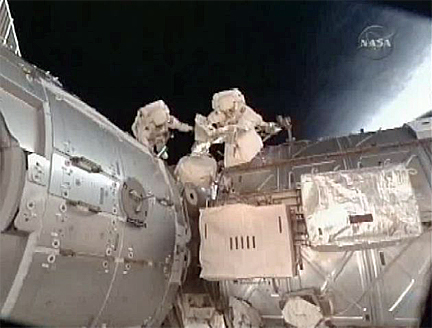
Behnken and Patrick deploy insulation needed to wrap ammonia coolant
lines. (Photo: NASA TV)

Behnken's helmet-cam view of ammonia coolant line connections.
(Photo: NASA TV)

Behnken working at the Unity/Tranquility interface. (Photo: NASA TV)
The spacewalk proceeded smoothly through its initial stages, but Patrick reported getting sprayed with a small amount of ammonia around 11 p.m. when he uncapped a connector on the Unity module before plugging in a jumper hose.
"And, OK, I have a small spray of ammonia coming out from under the cap," Patrick said. "I've backed away, I do have... ammonia did come in my direction. No more is coming out. I would estimate the total amount to be on the order of 1 cc."
"I saw some small pieces that just looked like snow, no continuous stream, just flakes is what I saw," Behnken said.
"Yep, I do not see any that's adhered to me," Patrick said. "It came out in the general direction of my right glove and my visor, but I see none adhering. I believe no more is coming out."
"And again, nothing visible currently on your helmet?" Robinson asked a few moments later.
"Nothing at all. It was about the kind of quantity of stuff that you would expect if you didn't empty the straw at the end of your drink bag."
"If you were drinking ammonia," Robinson said.
"If you were drinking ammonia," Patrick laughed.
A few moments later, Patrick pressed ahead with uncapping the line.
"I can confirm the pressure behind it is now released," he said. "My working hypothesis is it was a small leak and I'll go and continue this here. ... There's no more ammonia coming out."
"Outstanding. So this was the case we were briefed about that's happened several times before," Robinson said.
"Yeah."
09:30 PM, 2/13/10: Spacewalk No. 2 begins
Floating in the space station's Quest airlock, astronauts Robert Behnken and Nicholas Patrick switched their spacesuits to battery power at 9:20 p.m. EST, officially beginning a planned six-and-a-half-hour spacewalk.

Robert Behnken emerges from the Quest airlock to begin the
second spacewalk of Endeavour's mission. (Photo: NASA TV)
The primary goal of the excursion is to connect ammonia coolant lines to the new Tranquility habitation module, permitting flight controllers to proceed with activating the new room's electrical systems.
Bags holding the ammonia lines and the insulation they will be wrapped in were positioned outside during the crew's first spacewalk overnight Thursday.
The first item on the agenda this evening is to unpack the insulation and tether it in place along the coolant line runs. The ammonia hoses then will be put in place and the insulation wrapped around them.
Supply and return lines for the station's two coolant loops will be connected, but only loop A will be pressurized.
6:20 PM, 2/13/10: Astronauts gear up for second spacewalk; mission extended one day
Astronauts Robert Behnken and Nicholas Patrick prepared for a planned six-and-a-half-hour spacewalk Saturday to hook up ammonia coolant lines between the new Tranquility module and the International Space Station.
Mission managers, meanwhile, approved a one-day extension to the shuttle Endeavour's flight to give the astronauts more time to move life support system racks and exercise gear into the new module. Undocking from the station is now targeted for Feb. 19 with landing back at the Kennedy Space Center around 10:24 p.m. EST on Feb. 21
The primary objective of the crew's second spacewalk is the connection of ammonia coolant loops to carry away the heat generated by Tranquility's electrical systems. Two independent coolant loops will be connected but only one of them - loop A - will be activated, allowing engineers to begin powering up the new module.
The spacewalk was scheduled to begin around 9:09 p.m. EST. For identification, Behnken, call sign EV-1, will be wearing a suit with red stripes around the legs. Patrick, EV-2, will be wearing an unmarked suit.
This will be the 139th spacewalk devoted to station assembly since construction began in 1998, the second of three planned by Behnken and Patrick and the third so far this year. Total station EVA assembly time stood at 861 hours and 34 minutes going into Saturday's excursion.
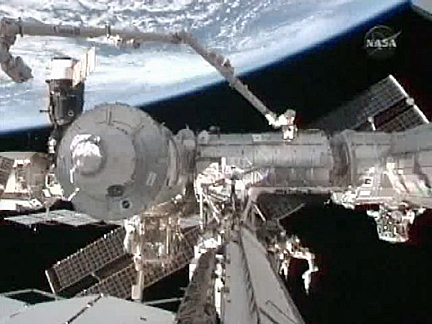
The new Tranquility module and multi-window cupola are visible
extending out of the frame on the left in this view of the
International Space Station. (Photo: NASA TV)

The other side of the space station, showing the Quest airlock
module, directly across the long axis from Tranquility, extending
out of the frame to the right. (Photo: NASA TV)
The Tranquility module, also known as node 3, was attached to the left side of the station's central Unity module during the crew's first spacewalk overnight Thursday.
The astronauts worked overnight Friday to make internal connections between the new module and the station and to prepare a multi-window cupola attached to the far end of Tranquility for relocation to the module's Earth-facing port overnight Sunday.
But the crew ran into problems installing a protective cover on the outboard side of the Tranquility hatch where the cupola is currently attached. Engineers are troubleshooting an interference issue that is preventing the cover from going into place. Plans to depressurize the cupola in preparation for its upcoming move were delayed.

This photograph shows a docking hatch cover from the outside.
An interference issue is preventing the astronauts from installing
the cover in the cupola port. (Photo: NASA TV)

An inside view of the protective cover in the cupola-Tranquility
interface. (Photo: NASA TV)
Station commander Jeffrey Williams reported Saturday that a closer inspection indicated removal of a few bolts would eliminate the interference. Photos were downlinked to engineers in Houston while Behnken and Patrick pressed ahead with their spacewalk preparations.
"The major activities, of course, are installing the ammonia lines and wrapping them in protective insulation," said station Flight Director Bob Dempsey. "This is going to be the major portion, the first half of the EVA.
"All four ammonia jumper lines will be installed, but only two of them, what we call the A loop, will be integrated into the external thermal control system. At that point, the ground will have already prepared the node 3 by activating some of the basic computer and power systems. Once we have that thermal control system activated, we will then complete the activation of the module. At that point, at the end of the EVA, we'll have one leg of our redundant system fully operational.
"The remainder of the EVA will be preparing some gap spanners, which the crew uses for (moving around the module's exterior), putting some handrails in place, putting in some sockets that will be used for foot restraints down the road if we ever need it, general outfitting of the module. They will also be preparing the node 3 nadir port, the common berthing mechanism, by removing some launch locks so we can open the petals we'll use to berth the cupola."
NASA originally planned to attach Tranquility to the Unity module's Earth-facing port, but engineers decided to move it to the left side of the module to improve visibility for robot arm operators and to provide more clearance for Soyuz spacecraft docking at a nearby Russian port.
But connectors needed to circulate ammonia coolant to and from Tranquility were not correctly positioned, or "clocked," for Tranquility to be attached to Unity's left-side port. Custom 16-foot extension hoses were ordered, but problems during recent pressure tests forced NASA to develop an alternative approach.
NASA managers ultimately decided to connect shorter flight-qualified hoses to solve the problem while improvements were ordered to bring the longer hoses up to flight standards as a backup.
For redundancy, the space station has two independent cooling loops and during Saturday's spacewalk, Behnken and Patrick plan to connect the supply and return lines for both loops. But only loop A will be pressurized. Loop B will be pressurized during a third spacewalk overnight Tuesday.
Saturday's flight plan calls for Behnken and Patrick to unfold a large sheet of multi-layer insulation and tether it in place. Then, the coolant lines will be laid down and the insulation wrapped around them.
"That's the biggest single challenge in all three of the EVAs, is getting the ammonia lines right," said Patrick. "Because there are four of them, and then there's this huge piece of insulation that we call MLI, for multi-layer insulation, it's about 20 feet long but it looks like it's a hundred feet long, shaped like a Y.
"It comes out of the bag very carefully and deliberately and we lay that down along the path of the ammonia jumpers. We put that MLI insulation behind some tethers that hold it in the right place and then, one at a time, we take the ammonia jumpers out of their bag and connect them to the lab and the new node 3 and open the valves."
While no one expects any leaks, the astronauts will be prepared for possible decontamination procedures if any problems are encountered.
"When we first open up the valve and allow the ammonia to flow, that'll be our first indication if there's any leaking," Dempsey said before launch. "If there's something that happens at that point, there's not really any automated computer response. We will shut down the lines, have the crew take some sort of response, which may be to close the valve or something like that.
"If you didn't do anything with a leak, you could drain a large quantity of ammonia," he said. "However, we do have a number of valves at various places, mainly right on both sides where we will open the valves and connect them, that we could shut."
Here is an updated timeline of today's activity (in EST and mission elapsed time; includes revision F of the NASA television schedule):
EST........DD...HH...MM...EVENT 02/13 04:14 PM...05...12...00...Crew wakeup 04:54 PM...05...12...40...EVA-1: Airlock repress/hygiene break 05:39 PM...05...13...25...EVA-1: Airlock depress to 10.2 psi 07:34 PM...05...15...20...EVA-2: Spacesuit purge 07:39 PM...05...15...25...Starboard deck IMV install 07:39 PM...05...15...25...Node 3 overhead IMV cap 07:49 PM...05...15...35...EVA-2: Spacesuit prebreathe 08:04 PM...05...15...50...Node 3 VAP cap removal 08:39 PM...05...16...25...Starboard overhead IMV install 08:39 PM...05...16...25...EVA-2: Crew lock depressurization 08:54 PM...05...16...40...Node 3 PPRV cap removal 09:09 PM...05...16...55...EVA-2: Spacesuits to battery power 09:14 PM...05...17...00...EVA-2: Airlock egress 09:39 PM...05...17...25...Node 3 ISP stowage transfer 09:49 PM...05...17...35...EVA-2: Node 3 MLI layout 10:09 PM...05...17...55...EVA-2: Ammonia jumper install 11:34 PM...05...19...20...EVA-2: Ammonia MLI install 02/14 12:19 AM...05...20...05...EVA-2: EV2: Open lab loop A QDs 12:19 AM...05...20...05...EVA-2: EV1: Open node 3 loop A QDs 12:39 AM...05...20...25...EVA-2: Ammonia MLI closure 12:54 AM...05...20...40...Node 3 ISP 1 removal 01:09 AM...05...20...55...EVA-2: EV2: Node 3 outfitting 01:19 AM...05...21...05...EVA-2: EV1: Node 3 outfitting 01:39 AM...05...21...25...Node 3 ISP 2 removal 02:24 AM...05...22...10...Starboard deck IMV checkout 02:54 AM...05...22...40...Starboard overhead IMV checkout 03:09 AM...05...22...55...EVA-2: Cleanup and ingress 03:39 AM...05...23...25...EVA-2: Airlock repressurization 03:54 AM...05...23...40...Node 3 CDC troubleshooting 03:54 AM...05...23...40...Spacesuit servicing 05:30 AM...06...01...16...Mission status briefing on NTV 07:44 AM...06...03...30...ISS crew sleep begins 08:14 AM...06...04...00...STS crew sleep begins 09:00 AM...06...04...46...Daily highlights reel on NTV 01:30 PM...06...09...16...Flight director's update on NTV 04:14 PM...06...12...00...Crew wakeup
7:30 AM, 2/13/10: Engineers troubleshoot cupola issue; reduced water processing system flow
The combined crews of the shuttle Endeavour and the International Space Station worked overnight Friday outfitting the new Tranquility module and preparing it for activation during a spacewalk Saturday night to connect ammonia coolant lines.
"The big activity today was the ingress of node 3, our new rec room," said lead station Flight Director Bob Dempsey. "Since then, they've been like busy bees running around inside the module, working away very diligently. ... The crew went in, took a few samples to make sure the air quality was exactly as we expected, took a few photos, obviously, to celebrate the moment and then got right down to work."
With the addition of Tranquility, or node 3, the International Space Station is more than 98 percent complete. The new module is the last major U.S. component scheduled for attachment to the lab complex.
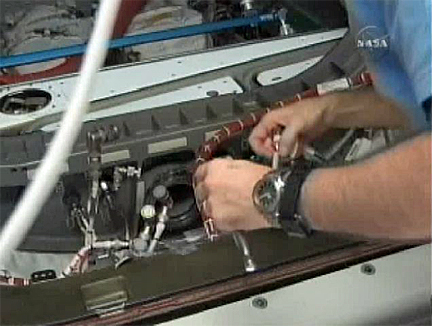
Space station commander Jeff Williams works to make connections
in the vestibule between the new Tranquility and Unity modules.
(Photo: NASA TV)
Initial checkout work went well, but the crew ran into a problem installing a protective cover on the module's outboard hatch, an issue that likely will require corrective action before a new seven-window cupola can be moved to its permanent location.
To fit in the shuttle's cargo bay, the cupola was attached to Tranquility's outboard port. But the flight plan calls for the crew to move the cupola to Tranquility's Earth-facing hatch overnight Sunday. On Monday, the crew plans to move a pressurized mating adaptor docking port from the Harmony module to Tranquility's outboard port, the one currently occupied by the cupola.
Before the cupola is relocated, the astronauts need to install a cover on the outboard side of the mating interface to protect it from micrometeoroid impacts and low temperatures.
"What this cover is, it's about the diameter of the module and it fits on the end cone of each module that when we remove a module and expose the (docking interface) to space, you want some sort of protection," Dempsey said.
"This cover is made of multi-layer insulation and some supporting fabric to give you some debris protection as well. The intent was to install this cover so that when we move the cupola off of the node 3, we had it there protecting the end. There's a similar cover on the nadir side of node 3 where the cupola will be relocated to."
The cover is held in place by four bars that rotate closed to engage a set of hooks. When the astronauts attempted to secure the cover overnight Friday, they discovered a physical interference that prevented the bars from rotating far enough to lock in place.
"Unfortunately, when they installed it, we discovered that the bars, the four standoff bars that hold the MLI in place, cannot swing down into the locked position because (they're) bumping up against some structure in the cupola," Dempsey said.
"Therefore, we are looking at various options to see if we need the cover, how we're going to install it and if we have any clearance issues with the cover should we be berthing the cupola on the nadir side. This is still being assessed at this time, we're not sure of the impact. It'll probably make some changes to the timeline in a few days."
It may be possible to simply remove the underlying equipment that is causing the interference and then re-install it after the cupola is moved. Engineers also are assessing whether the cover can be left off and whether or not the cover currently in place on the nadir port might prevent the cupola from being attached.
"There is no immediate requirement to move the cupola down to its final location," Dempsey said. "Obviously, we've got the crew (on board) that's trained with the robotics so we'd prefer to do it. But if in the next few days we decide we need more time to think about it, we will. The main focus the next few days is going to be activating node 3, getting those systems up and running."
Dempsey said the space station's urine recycling system, repaired earlier in the mission with equipment brought up aboard Endeavour, appears to be working normally. As of early Saturday, 55 pounds of urine had been processed without incident.
But engineers were looking into an apparent problem with the station's potable water system. A new filter was installed earlier in the mission to address an issue with degraded performance, but the system still appears to have problems.
"We have had some reduced flow before," Dempsey said. "We're not certain at this point if it's the same sort of problem. It likely is. It appears to be happening between a valve and the new external filter that we installed earlier in the mission.
"We're going to ... do what we call a back flush, where we push some of the water back and bypass the filter and see if it's possibly a solenoid, a valve that is having some sort of debris that's blocking it. Alternatively, it could be the filter."
Astronauts Robert Behnken and Nicholas Patrick planned to spend the night in the Quest airlock module at a reduced pressure of 10.2 pounds per square inch to help purge their bodies of nitrogen before a spacewalk overnight Saturday to connect coolant lines between Tranquility and the station.
Crew wakeup is expected at 4:14 p.m. and the spacewalk is scheduled to begin at 9:09 p.m.
9:30 PM, 2/12/10: Astronauts open hatch to Tranquility module
Space station commander Jeffrey Williams opened the hatch to the new Tranquility module at 9:17 p.m. EST Friday, revealing a roomy new addition to the lab complex that will house life support systems, exercise gear and an observation deck that promises spectacular views.
The new module, the final major U.S. addition to the space station, will not be electrically powered up until after a spacewalk overnight Saturday to activate the first of two ammonia coolant loops. As such, the astronauts got their first looks inside using flashlights.
Wearing face masks in case any debris worked its way loose in weightlessness, the astronauts got to work with initial outfitting, using portable ventilation ducts to provide air circulation.
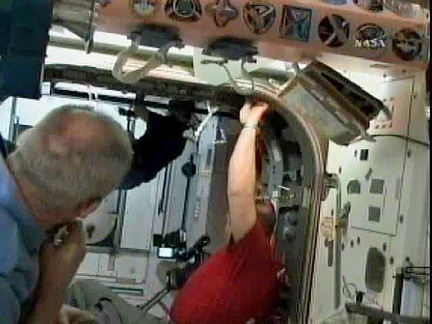
Station astronauts look into the new Tranquility module shortly
after hatch opening. (Photo: NASA TV)
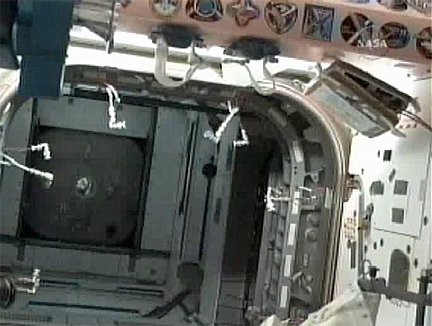
An unobstructed view into Tranquility. (Photo: NASA TV)
07:45 PM, 2/12/10: Astronauts prep new module for activation
The shuttle Endeavour's heat shield - the protective tiles on the ship's belly and the critical carbon composite nose cap and wing leading edge panels - have been cleared for re-entry after a detailed analysis of post-launch imagery and sensor data, NASA officials said Friday.
"The team has completed their analyses ... and we determined that Endeavour is cleared for entry," said LeRoy Cain, chairman of NASA's Mission Management Team. "All the TPS (thermal protection system) is cleared and the vehicle is safe for deorbit, re-entry and landing."

A dramatic shot of the shuttle Endeavour during approach to the
space station late Tuesday. (Photo: NASA TV)
Only three "areas of interest" were identified during the analysis and Cain said none of them posed any additional risk.
A small ceramic insert over a bolt in a carrier panel that helps hold one of the cockpit windows in place backed out slightly during launch, posing a potential risk for hitting the shuttle's tail fin if it released during re-entry.
A similar issue developed during at least one previous shuttle flight and in that case, the insert did not release. Cain said engineers do not expect Endeavour's to release, either, but even it did it could not cause any critical damage.
"The rudder-speedbrake on the vertical tail was an area we had determined that it could transport to," Cain said. "But all the assessment, the analyses of the associated critical systems in the vertical tail, including the rudder and speedbrake actuator areas as well as the leading edge of the vertical tail, the object just would not have enough energy to impart critical damage to any of those systems. And so we're not concerned about that."
Another area of interest was a tile on the top of the crew cabin that has a small crack in one corner. The tile had been repaired but the fix apparently failed and the crack re-opened. As with the insert, Cain said engineers do not expect any pieces to break away during re-entry but even if one did, it would not have enough energy to cause any damage.
The third area of interest involved a so-called flipper door seal that was seen protruding above the surface of Endeavour's left wing after launch. The seal covers part of the interface between the back of the wing and the elevons that help control the shuttle's flight in the atmosphere.
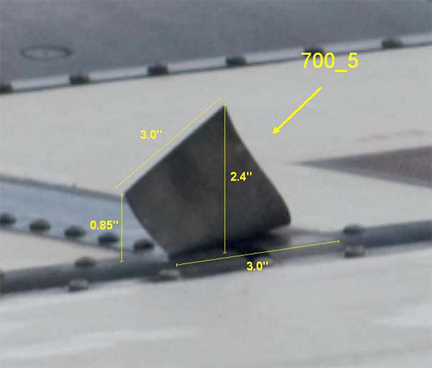
A protruding flipper door seal on Endeavour's left wing.
(Photo: NASA TV)
"There is no issue with that seal protruding as it is," Cain said Friday. "We don't expect it to do anything during entry in terms of peeling back any further or breaking off or anything like that.
"If it should somehow liberate, which is absolutely not expected, it has the potential for impacting one of the elevon control surfaces at the back of the wing. But again, it doesn't have the mass or the energy to do anything other than ... something superficial and nothing of any critical nature at all."
The analysis also showed no issues with the thermal environment under the lifted seal.
Aboard the shuttle-station complex Friday, the crews focused on preparations for activating the new Tranquility habitation module attached to the Unity module's left-side port during a spacewalk overnight Thursday.
The hatch leading into the new module is expected to be opened just after 9 p.m. Power will not be routed to the module's circuitry until after the first of two ammonia coolant loops is connected and activated during a spacewalk overnight Saturday.
Using flashlights and portable ventilation ducts, the crew plans to open the module this evening and move the vibration isolation system used by one of the station's exercise machines inside, followed by a carbon dioxide removal rack.
"The systems will not be activated, so it will be a little bit dark in there and it won't have the ventilation fans going, but we will have the crew going in there, they will be working to prepare and outfit node 3, getting it ready," said space station Flight Director Bob Dempsey.
Tranquility, also known as node 3, was launched with a seven-window cupola attached to its outboard end. Later this weekend, the station's robot arm will be used to remove the cupola and attach it to Tranquility's Earth-facing port.
One of the station's two robot arm control stations will be moved into the cupola once it is activated, providing a direct view for operators performing maintenance or capturing approaching supply ships.
"One of the main activities (overnight Friday) will be preparing the cupola for its relocation," Dempsey said. "What this will entail is opening the hatch to the cupola, putting in a cover that will be in place once the cupola is removed and provides protection to that port when it's exposed to space, capping some valves so we have good seals there and don't have any paths to vacuum. Then we will close the hatch and get ready to depress the cupola in preparations for its relocation.
"The crew will also be working on outfitting the vestibule between the ISS and node 3, attaching computer cables, data cables, various power cables and so forth. And then the crew will be working inside the module, getting ready for relocating some of the racks later on."

The shuttle Endeavour and the International Space Station fly above
the Pacific Ocean Friday. The two spacecraft together mass
more than 1 million pounds. (Photo: NASA TV)
The new module eventually will house the U.S. segment's water processing system, urine recycling equipment, oxygen generator, carbon dioxide scrubber and the NASA toilet. But the crew is holding off the relocation of the water processing racks until engineers have had time to assess the performance of the station's repaired urine recycling system.
Endeavour's crew delivered a new distillation assembly centrifuge and an external filter to address two problems that had degraded the system's performance in recent weeks. The new hardware was installed Thursday and the crew is now using the system while engineers monitor its operation.
'There are actually two issues," Dempsey said. "Coming out of what's called the waste water tank assembly as it goes into what's called the liquid separator, as part of the processing we believe there's some biological material that's been sort of growing in there, gunk or fungi or something like that, and the external filter assembly that we attached will help filter that out before it gets into the rest of the (system)."
The other issue is unexpected calcium buildups that caused problems for the distillation assembly. The fix for that issue was to reduce the amount of liquid in the system at any given time.
Cain said Friday the system was operating at a slightly reduced pressure, but it's not yet clear whether that indicates a problem or is simply the result of the new filter and operating philosophy.
Here is an updated timeline of today's activity (in EST and mission elapsed time; includes revision F of the NASA television schedule):
EST........DD...HH...MM...EVENT 02/12 04:14 PM...04...12...00...Crew wakeup 06:04 PM...04...13...50...ISS daily planning conference 07:14 PM...04...15...00...Node 3 vestibule outfitting (part 1) 07:19 PM...04...15...05...Spacesuit resizing 07:24 PM...04...15...10...SSRMS walkoff to lab module 07:49 PM...04...15...35...Spacesuit power harness replacement 08:09 PM...04...15...55...EVA tools configured 08:54 PM...04...16...40...SSRMS releases node 2 09:09 PM...04...16...55...Node 3 hatch open 09:39 PM...04...17...25...EVA tool audit 09:39 PM...04...17...25...Node 3 vestibule outfitting (part 2) 10:09 PM...04...17...55...QD familiarization 10:19 PM...04...18...05...Node 3 port IMV cap 10:44 PM...04...18...30...Node 3-Cupola hatch open 11:19 PM...04...19...05...Node 3 port CDC install 11:39 PM...04...19...25...Crew meals begin 02/13 12:39 AM...04...20...25...Node 3 overhead IMV cap 12:59 AM...04...20...45...Node 3V AP cap removal 01:04 AM...04...20...50...Node 3 VAP cap removal 01:14 AM...04...21...00...Node 3 vestibule outfitting (part 3) 01:54 AM...04...21...40...Node 3 PPRV cap removal 01:59 AM...04...21...45...ARED vibration isolation transfer 02:29 AM...04...22...15...PAO event 02:49 AM...04...22...35...EVA-2: Equipment lock preps 02:49 AM...04...22...35...Equipment lock preps 02:59 AM...04...22...45...ARS rack transfer 05:24 AM...05...01...10...PAO event 05:49 AM...05...01...35...ISS evening planning conference 06:39 AM...05...02...25...EVA-2: Mask/pre-breathe 07:24 AM...05...03...10...EVA-2: Airlock depress to 10.2 psi 07:44 AM...05...03...30...ISS crew sleep begins 08:14 AM...05...04...STS crew sleep begins
4:10 AM, 2/12/10: Spacewalk No. 1 ends
Astronauts Robert Behnken and Nicholas Patrick began repressurizing the International Space Station's Quest airlock module at 3:49 a.m. EST, ending a successful six-hour 32-minute spacewalk after making initial connections between the lab and the new Tranquility module.
The 15-ton habitation module, also known as node 3, was removed from the shuttle Endeavour's cargo bay late Thursday and installed on the left port of the central Unity module by Kay Hire and Terry Virts, operating the space station's robot arm.
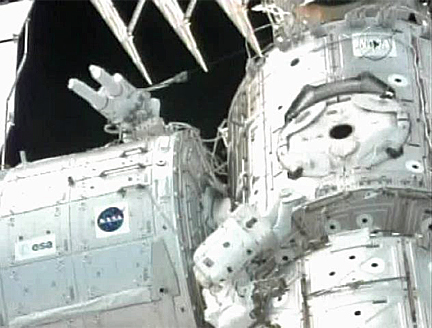
Robert Behnken (top) and Nicholas Patrick connect power and data
cables to and from the Tranquility module. (Photo: NASA TV)
Behnken and Patrick then hooked up data cables and a temporary keep-alive power cable to operate internal heaters until cooling is established later in the mission and the module's electrical system is fully activated.
"Houston, for EVA, you guys can be advised we have good avionics and heater cable activation, so all those connections look good down here," radioed Hal Getzelman from mission control.
"Great news,╩Houston, we appreciate it," astronaut Stephen Robinson, the spacewalk coordinator, replied from Endeavour.
"And we also got a good gross leak check on the vestibule" between the Unity and Tranquility modules, Getzelman added.
"Oh, that's outstanding news, thanks for letting us know, Houston," Robinson said. "Good work, gents."
"Well thank you, Steve," replied Behnken, who also took a moment to thank the crew's trainers. "I'm really glad for how successful it was, for getting this far and getting that power on node 3. Let the activation of node 3 begin!
"I whole heartedly agree," Patrick said. "It's been a great year of training with all those wonderful trainers back in Houston and I also really appreciated the support from our friends at the NBL (Neutral Buoyancy Laboratory training pool) who made all the training possible."
"A noble start for the STS-130 EVA extravaganza!" Robinson concluded.
This was the first of three spacewalks planned by Behnken and Patrick. Total space station EVA time now stands at 861 hours and 34 minutes. Behnken's total through four spacewalks is 25 hours and 51 minutes.
01:50 AM, 2/12/10: Tranquility module bolted to station; astronauts work to complete electrical, data connections
The 15-ton Tranquility module was eased into position and robotically bolted in place on the left side of the International Space Station's central Unity module early Friday to accomplish the primary goal of the shuttle Endeavour's mission.
The big module, the last major U.S. addition to the space station, was bolted in place at 12:20 a.m. EST.
Astronauts Robert Behnken and Nicholas Patrick then began work to hook up avionics cables and keep-alive power to provide temperature control until coolant lines are attached and internal power circuits are activated later in the mission.
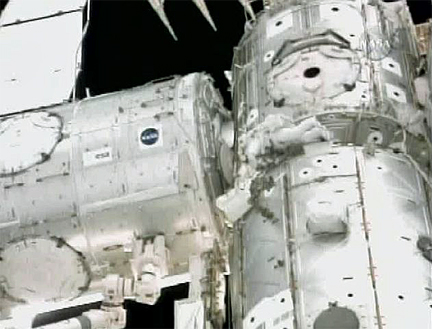
Astronaut Nicholas Patrick floats at the junction of the Unity (top
right) and Destiny (bottom right) modules. The new Tranquility
module is visible at left. (Photo: NASA TV)
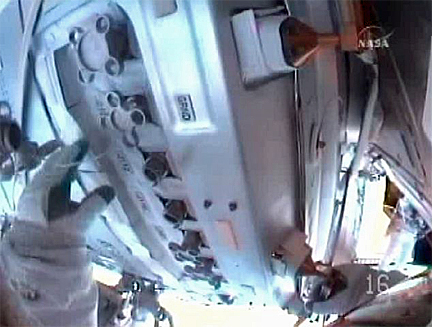
Astronaut Robert Behnken's helmet-cam view as he removes dust
covers from avionics plugs on the Tranquility module. (Photo: NASA TV)
There have been no problems of any significance during the mission's first spacewalk and at one point the astronauts were an hour ahead of schedule.
11:25 PM, 2/11/10: Tranquility module lifted from shuttle payload bay
Astronauts Kay Hire and Terry Virts, operating the International Space Station's robot arm, lifted the Tranquility habitation module from the shuttle Endeavour's cargo bay late Thursday and began moving it toward its attachment point on the left side of the central Unity module.
The arm began lifting the 15-ton module at 11:07 p.m. EST after spacewalkers Robert Behnken and Nicholas Patrick removed protective covers over its docking mechanism and unplugged shuttle keep-alive power.
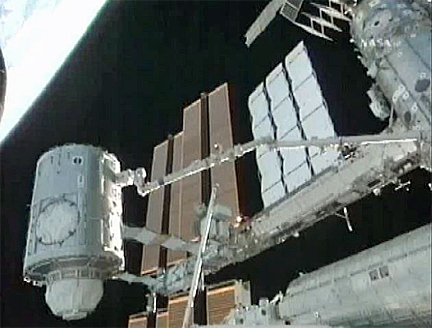
The Tranquility module being pulled from the shuttle Endeavour's
cargo bay. (Photo: NASA TV)
It will take Virts and Hire about two hours to maneuver Tranquility into position so the module's common berthing mechanism can engage its counterpart on Unity. Behnken and Patrick, meanwhile, will be working up on the station's main power truss, removing a component from the Canadian DEXTRE robot.
After Tranquility is locked in place on Unity's left port, the spacewalkers will connect power and data cables, along with space station keep-alive power. The module's main power system will not be activated until after it has been connected to the station's ammonia coolant loops during the crew's second and third spacewalks.
9:40 PM, 2/1 1/10: Spacewalk No. 1 begins
Astronauts Robert Behnken and Nicholas Patrick switched their spacesuits to battery power at 9:17 p.m. EST, officially beginning a planned six-and-a-half-hour spacewalk.
"Have a great EVA and we'll see you in a few hours," Endeavour commander George Zamka radioed from inside the space station.
"Thanks for all your help," George," Behnken replied.
"Gentlemen, it's a great day outdoors, nighttime right over Rio de Janeiro," called spacewalk coordinator Stephen Robinson from the shuttle's flight deck. "In addition to greeting you guys outdoors, I'll greet the big EVA team down in Houston. It's a great day to do EVA. It's a good time to finally get started."

The space station's robot arm, locked onto the Tranquility module.
(Photo: NASA TV)

Astronauts Robert Behnken and Nicholas Patrick exit the
Quest airlock. (Photo: NASA TV)
9:40 PM, 2/1 1/10: Astronauts suit up for launch
Astronauts Robert Behnken and Nicholas Patrick suited up for a planned six-and-a-half-hour spacewalk Thursday to help connect a new 15-ton habitation module to the International Space Station. Floating in the station's Quest airlock, the spacewalkers were expected to begin the EVA around 9:09 p.m. EST.
This will be the 138th spacewalk devoted to station assembly and maintenance since construction began in 1998, the second so far this year and the first of three by the Endeavour astronauts.
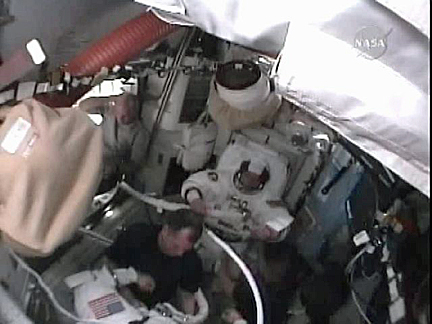
Robert Behnken (top) and Nicholas Patrick (bottom) suiting up
for a planned spacewalk Thursday. (Photo: NASA TV)
Behnken, call sign EV-1, will be wearing a suit with red stripes around the legs. He has three previous spacewalks to his credit, totaling 19 hours and 19 minutes. Patrick, EV-2, will be making his first spacewalk in an unmarked suit.
Both astronauts spent the night in the station's airlock at a reduced pressure of 10.2 pounds per square inch to help purge nitrogen from their bloodstreams prior to spending a day in NASA's 5-psi spacesuits.
The primary goal of the first spacewalk is to prepare the Tranquility module for extraction from Endeavour's cargo bay and its installation on the left-side port of the station's central Unity module.
The spacewalkers will make their way from Quest to the shuttle's payload bay and then split up. Behnken, working at the back of the cargo bay, will remove eight protective blankets from the module's berthing mechanism while Patrick, working at the forward end of Tranquility, disconnects and stows a shuttle power cable.
Terry Virts and Kay Hire, working inside the Destiny lab module, will use the station's robot arm to pull Tranquility from Endeavour's payload bay and install it on Unity.
While that work is going on, Behnken and Patrick will pre-stage two large bags containing ammonia coolant lines and insulation needed for the second spacewalk. They then will move to the Canadian DEXTRE robot and remove a stowage tray that will be replaced during a subsequent flight.
"On the first spacewalk, the biggest concern is getting power to node 3 after it's attached to the space station," Behnken said in an interview. "The timer that's running on it for its keep-alive power is longer than an EVA but not long enough to go to the next EVA."
With Tranquility mated to Unity's left port, Behnken will work to connect data cables while Patrick hooks up a "launch-to-activation" cable, providing keep-alive power. The module's internal systems will not be activated until ammonia coolant loops are connected during the second and third spacewalks.
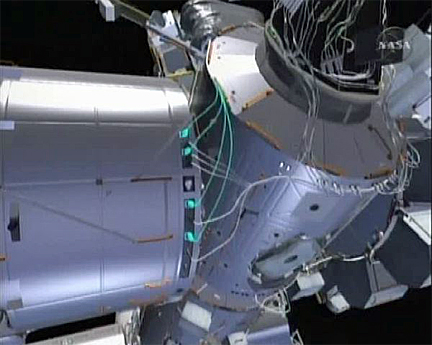
Avionics cables attached to Tranquility (left). (Photo: NASA TV)
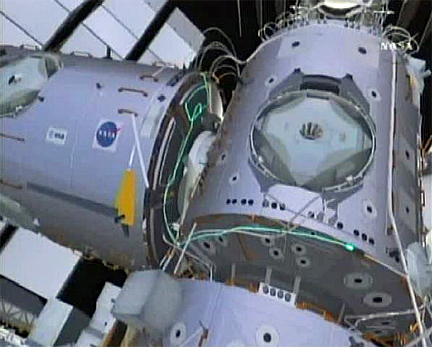
Keep-alive power cables between Unity and Tranquility (left). (Photo: NASA TV)
If all goes well, Behnken and Patrick will return to the Quest airlock and end the first spacewalk around 3:39 a.m. Friday.
Here is an updated timeline of today's activity (in EST and mission elapsed time; includes revision D of the NASA television schedule):
EST........DD...HH...MM...EVENT 04:14 PM...03...12...00...Crew wakeup 04:54 PM...03...12...40...EVA-1: Airlock repress/hygiene break 05:39 PM...03...13...25...EVA-1: Airlock depress to 10.2 psi 07:34 PM...03...15...20...EVA-1: Spacesuit purge 07:49 PM...03...15...35...EVA-1: Spacesuit prebreathe 08:29 PM...03...16...15...SSRMS grapples Node 3 08:39 PM...03...16...25...EVA-1: Crew lock depressurization 09:09 PM...03...16...55...EVA-1: Spacesuits to battery power 09:14 PM...03...17...00...EVA-1: Airlock egress 09:49 PM...03...17...35...EVA-1: EV2: Node 3 prepped for unberth 09:54 PM...03...17...40...EVA-1: EV1: Node 3 prepped for unberth 10:39 PM...03...18...25...EVA-1: EV1: NH3 bag ops 10:49 PM...03...18...35...EVA-1: EV2: NH3 bag ops 10:49 PM...03...18...35...SSRMS moves Node 3 to pre-install location 11:39 PM...03...19...25...EVA-1: OTP removal 02/12 12:24 AM...03...20...10...SSRMS moves Node 3 to RTL location 12:44 AM...03...20...30...Node 3: Stage 1 capture 01:04 AM...03...20...50...Node 3: Stage 2 capture 01:34 AM...03...21...20...EVA-1: EV1: Avionics cable install 01:34 AM...03...21...20...EVA-1: EV2: LTA cable install 02:34 AM...03...22...20...EVA-1: EV2: Get aheads 02:54 AM...03...22...40...EVA-1: EV1: Get aheads 03:09 AM...03...22...55...EVA-1: Cleanup and ingress 03:34 AM...03...23...20...Node 3 vestibule leak check (part 1) 03:39 AM...03...23...25...25...EVA-1: Airlock repressurization 03:54 AM...03...23...40...Post-EVA servicing 04:39 AM...04...25...00...Node 3 vestibule leak check (part 2) 05:30 AM...04...01...16...Mission status briefing on NTV 07:44 AM...04...03...30...ISS crew sleep begins 08:14 AM...04...04...00...STS crew sleep begins 09:00 AM...04...04...46...Daily highlights on NTV 01:30 PM...04...09...16...Flight director's update on NTV 04:14 PM...04...12...00...Crew wakeup
07:05 PM, 2/10/10: Station water processor repairs on tap; crew off duty time
The Endeavour astronauts worked through a light day in orbit Wednesday, preparing for a spacewalk overnight Thursday, the first of three to attach and outfit a new habitation module, and enjoying a bit of time off.
Space station commander-turned-plumber Jeffrey Williams, meanwhile, spent his "morning" repairing the lab's urine recycling equipment, installing a new distillation assembly centrifuge and pump module brought up aboard Endeavour, along with a new filter that engineers hope will restore the critical system to normal, or near-normal operation.

The space station robot arm, poised to grapple the Tranquility
module. Installation is planned overnight Thursday.
(Photo: NASA TV)
If all goes well, Williams will complete the repairs this evening and the equipment will begin processing stored urine to make sure the system works as expected.
"The top priority really will be replacing the distillation assembly, which is a centrifuge that's a central component in the urine processor," said lead Flight Director Kwatsi Alibaruho. "That assembly will be replaced and if everything goes well, we'll do the initial activation of that assembly and start a brief shakedown period."
Engineers on the ground "will be looking at the performance of that system, making sure all the currents and the rotation rates and other parameters are as they expect," he said. "And then we'll try to process some of the urine that's been stored. We'll probably start that process early on flight day five (overnight Thursday) or a little bit later."
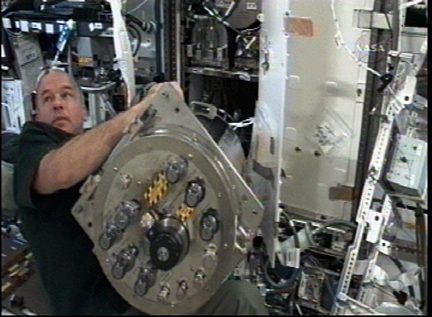
Station commander Jeff Williams moves a new distillation
assembly into position for installation in the lab's urine
recycling system. (Photo: NASA TV)
The primary goal of Endeavour's mission is to attach a new habitation module to the station that will house the U.S. toilet, oxygen generation system, carbon dioxide scrubber and water processing system, all of which are currently housed elsewhere in the lab.
But the equipment racks will not be moved until the urine processing system has had a chance to operate, generating pure water that will be returned to Earth aboard Endeavour for analysis.
Shuttle engineers at the Johnson Space Center are continuing their assessment of Endeavour's heat shield to make sure the orbiter can safely descend to Earth a the end of the mission.
LeRoy Cain, chairman of NASA's Mission Management Team, said engineers now have enough imagery to rule out any need for an additional, focused inspection. Time set aside for such an inspection now will be put to use transferring equipment and supplies and doing other tasks.
Overall, Cain said, the shuttle's thermal protection system appears to be "very clean" with only two "areas of interest" under discussion.
A photo survey carried out by the station crew during the shuttle's approach Tuesday showed a ceramic insert around a fastener securing a carrier plate around one of the shuttle's cockpit windows had loosened, protruding a bit above the surface of the window frame.

A protruding ceramic insert around a cockpit window.
(Photo: NASA)
The fastener acts as a spacer of sorts and engineers are assessing what might happen if it worked loose during re-entry, whether it could strike the shuttle's tail fin, speed brake or an aft orbital maneuvering system rocket pod.
"The vertical stabilizer, where we have the rudder and the speedbrake, is the area that would be of concern, possibly the OMS pod," Cain said. "The ceramic insert is a fairly dense material. We'll see what the debris transport shows us."
It's not yet known what sort of energy the insert could impart if it did work itself loose, or even whether that's a possibility given that it didn't come all the way out during the vibrations of launch.
"There are a whole lot of questions that have to be answered before we would ever consider whether or not we need to do anything to mitigate it," Cain said. "We have more questions than answers at this point, so we'll let the team go off and do the work."
Another area of interest is a repaired tile on the upper surface of the crew module. The repair appears to have failed and one corner of the tile has separated slightly from the rest.

A cracked tile spotted on the upper surface of Endeavour's
crew cabin. (Photo: NASA)
Neither issue appears to be a serious threat and as of this writing, it appears unlikely any repairs would be attempted. But Cain said nothing has been ruled out.
"Those are two areas we'll take a closer look at from an analysis standpoint, we'll do some debris transport assessment and we'll talk some more about those two areas as we go through the mission," he said. "Initially, it doesn't look like we're going to be very concerned about them, but we want to be very vigilant and take a closer look."
Overall, he said, "the vehicle is very, very clean from a thermal protection standpoint. Endeavour looks really good."
Here is an updated timeline of today's activity (in EST and mission elapsed time; includes revision C of the NASA television schedule):
EST........DD...HH...MM...EVENT 02/10 04:14 PM...02...12...00...Crew wakeup 04:30 PM...02...12...16...Post MMT briefing on NTV 05:49 PM...02...13...35...ISS daily planning conference 06:04 PM...02...13...50...ISS: Distillation assembly install 07:04 PM...02...14...50...ISS: Water pump assembly replacement 07:19 PM...02...15...05...EVA tools configured 07:44 PM...02...15...30...Transfer operations 08:24 PM...02...16...10...ISS: Waste water tank offload 09:19 PM...02...17...05...EVA tool audit 09:30 PM...02...17...16...Mission status briefing on NTV 09:39 PM...02...17...25...ISS: Filter install 10:49 PM...02...18...35...Joint crew meal 11:49 PM...02...19...35...PAO event on NTV 02/11 12:09 AM...02...19...55...Crew off duty time 04:14 AM...03...00...00...EVA-1: Procedures review 05:29 AM...03...01...15...ISS evening planning conference 06:39 AM...03...02...25...EVA-1: Mask/pre-breathe 07:24 AM...03...03...10...EVA-1 Airlock depress to 10.2 psi 07:44 AM...03...03...30...ISS crew sleep begins 08:14 AM...03...04...00...STS crew sleep begins 09:00 AM...03...04...46...Daily highlights reel on NTV 01:30 PM...03...09...16...Flight director update on NTV 04:14 PM...03...12...00...Crew wakeupFixing the urine processor is critical to long-term station operation. With a crew of up to six full-time astronauts, generating fresh water is an on-going issue that will take on added significance when the shuttle is retired later this year.
Here is a bit more background from the CBS News STS-130 mission preview:
The station's urine processor has been shut down in recent weeks because of problems with the distillation assembly. More recently, blockage in a line knocked out the part of the system that converts condensate into clean water.
"We brought home the other failed distillation assembly on the last shuttle flight," station Program Manager Mike Suffredini said before launch. "Through a failure investigation, we found calcium deposits inside the distillation assembly and we're doing quite a bit of investigation to determine how to prevent that in the future.
"One way is to not process to as high a concentration of brine inside the system, meaning we empty the tank that carries the ultimate waste from the urine processor, we empty it a little more often. So we want to run the processor with the new distillation assembly inside long enough to fill the tank up to the new level we plan to operate at, remove that tank and bring it home.
"That will take us almost the entire mission, from the time we're able to install the spare until the time the crew has to depart," Suffredini said. "That's what's driving us not to do the rest of the rack moves until the urine processor can move."
As for the presumed line blockage problem with the water processing system that is preventing conversion of condensate, engineers believe a filter carried up aboard Endeavour should resolve the issue.
"When the shuttle arrives we'll install the filter and then we'll activate the water processor along with the urine processor and recover our regenerative (environmental control and life support) system by the end of the mission," Suffredini said.
The station has plenty of stockpiled water for extended operations while work to fix the current problems is carried out. Station Flight Director Bob Dempsey described the repairs as "an extensive amount of work."
"Once they complete that work, we'll activate from the ground and begin processing the urine and we'll watch that very closely," he said. "We'll process as much as we can through the mission so the filter/tank assembly gets to be used as much as we can and verify that the system is working in its new configuration and then we'll bring it back on the last day."
As it now stands, the oxygen generation system, the U.S. toilet and the water processing system racks bound for Tranquility will not be moved into the new module during the normal shuttle timeline. If the flight is extended one day as managers hope, the Endeavour astronauts should be able to get some, if not all, of the equipment transferred.
01:00 AM, 2/10/10: Endeavour docks with space station (UPDATED at 02:55 a.m. with hatch opening; UPDATED at 4:30 a.m. with post-docking briefing)
The shuttle Endeavour docked with the International Space Station early Wednesday after a picture-perfect rendezvous that included spectacular views of the shuttle against the blue-and-white backdrop of Earth.
With shuttle commander George Zamka flying Endeavour from the aft flight deck, the docking systems engaged on time at 12:06 a.m. EST as the two spacecraft sailed 215 miles above the Atlantic Ocean west of Portugal at five miles per second.
"Station and Houston, capture confirmed," shuttle pilot Terry Virts called out.
Going into this mission, the space station's mass was 764,350 pounds. With the addition of Endeavour and its cargo - the 15-ton Tranquility module, a multi-window cupola and other equipment - the combined mass of both spacecraft exceeded 1 million pounds for the first time.
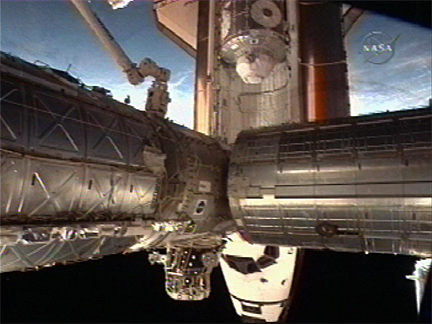
Endeavour docked with the International Space Station early
Wednesday. (Photo: NASA TV)
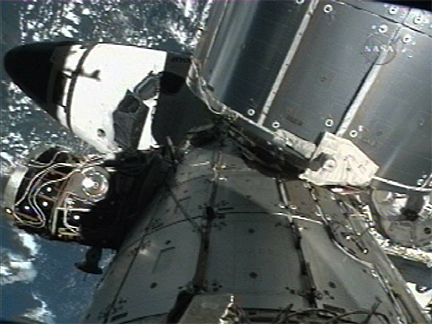
Another view of the shuttle docked with the space station.
(Photo: NASA TV)
It took longer than usual for relative motion to damp out between the two spacecraft but by 12:50 a.m., the docking systems were aligned and stable and the vehicles were pulled firmly together.
It took another hour and a half or so to carry out leak checks and confirm a tight seal. After that, hatches were opened and station commander Jeffrey Williams and his crewmates - T.J. Creamer, Soichi Noguchi, Oleg Kotov and Max Suraev - welcomed the shuttle astronauts aboard around 2:15 a.m.
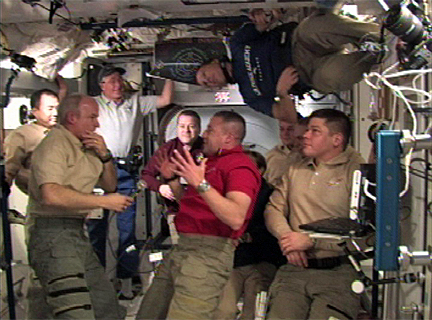
Shuttle commander George Zamka, in red shirt, describes
docking to space station commander Jeff Williams.
(Photo: NASA TV)
"We just wanted to take a moment to welcome the crew of STS-130 aboard the ISS," Williams said. "We're happy to see our friends. Some of us are really happy because we haven't seen many people other than the crew for a long time. And happy that we're coming close to the completion of assembly of station with this mission. So really happy to have you guys on board."
"Jeff, we are glad to be here," Zamka replied. "It was absolutely beautiful coming on up. We're ready to bring up Tranquility and cupola and work with you guys and bring it to life. This is a great day."
Lead shuttle Flight Director Kwatsi Alibaruho said the rendezvous and docking went smoothly despite problems with a trajectory control system laser range finder.
"We had an excellent day on orbit today and a very clean rendezvous and docking," he said. "The only issues we were tracking were associated with the trajectory control system. It's basically a laser range system that provides us range and range-rate data between the space shuttle and the space station that helps the commander navigate as he's flying the final approach.
"That system started providing some erratic data when we were at about 200 feet away from the space station. It wasn't a problem at all because this really is one of several tools that we have. ... We just relied more heavily on the hand-held laser and disregarded some of the noisy data that was coming from the trajectory control system."
Before docking, when Endeavour was positioned 600 feet directly below the space station, Zamka monitored a computer-assisted back flip maneuver that exposed heat shield tiles on the belly of the shuttle to powerful cameras operated by Williams and Kotov.
The rendezvous pitch maneuver is part of a post-Columbia suite of techniques to help engineers assess the health of the shuttle's heat shield.
The digital images shot during the rendezvous pitch maneuver were downlinked right away and Alibaruho said no obvious problems were immediately apparent. The team will know by the end of the day Wednesday whether any additional inspections are required.
"Really, by close of business this day, we should have a very good sense of whether or not we have any outstanding concerns or whether we're well on the path to the thermal protection system being cleared for entry," he said.
"If we get past these meetings we have today with no requirements for focused inspection and no significant concerns ... it's very, very high likelihood the TPS (thermal protection system) will be cleared for entry in due course."
11:41 PM, 2/9/10: Shuttle performs back flip on approach to space station
Positioned 600 feet directly below the International Space Station, the shuttle Endeavour performed a graceful back-flip maneuver late Tuesday, exposing the ship's heat shield to powerful cameras aboard the lab complex.
The so-called rendezvous pitch maneuver, or RPM, a now-routine procedure in all shuttle-station dockings, provides a direct look at the underside of the orbiter and gives engineers the high-resolution imagery they need to assess the health of the shuttle's thermal protection system before re-entry.
No obvious problems were apparent in live television views of Endeavour's RPM, but the camera was not zoomed in enough to provide much detail. Engineers rely on still images shot with powerful telephoto lenses to carry out their assessment.
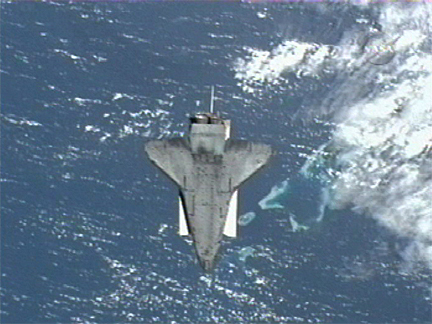
Endeavour performs a slow back flip, allowing station crew
to photograph the shuttle's heat shield. (Photo: NASA TV)
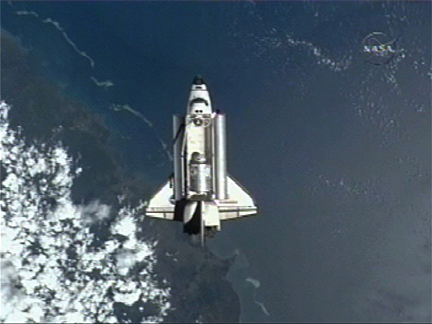
Pitch around complete, Endeavour heads up to the space station.
(Photo: NASA TV)
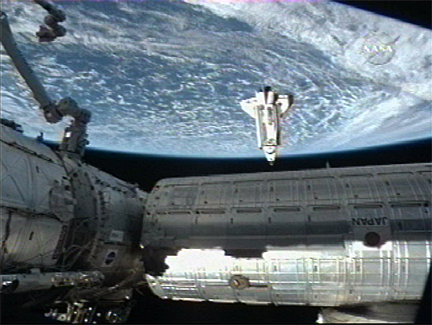
Endeavour moves up in front of station prior to docking.
(Photo: NASA TV)
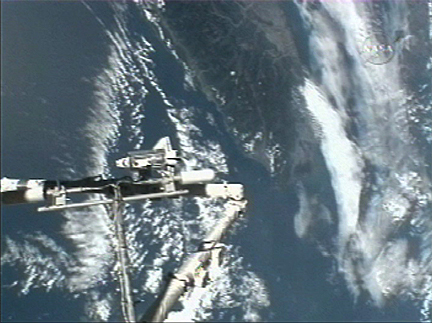
Find the shuttle! (Photo: NASA TV)
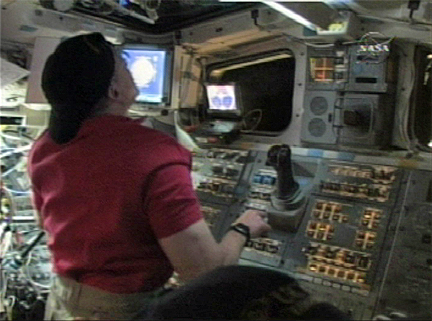
Shuttle commander George Zamka looks at the space station
through an overhead window. (Photo: NASA TV)
07:20 PM, 2/9/10: Shuttle Endeavour closes in on space station
The shuttle Endeavour closed in on the International Space Station Tuesday, bringing a new habitation module and a multi-window observation deck that will give crew members a bird's eye view of Earth and approaching cargo ships.
The terminal phase of this evening's rendezvous procedure was scheduled to begin at 9:28 p.m. EST when commander George Zamka and pilot Terry Virts oversee the first in a series of rocket firings to close the final 9.2 miles to the space station.
Docking at the station's forward port is expected around 12:06 a.m. Wednesday.
"We start with a whole lot of closure ... but at docking, we'll have a relative speed of a little more than an inch per second so it ends up being very controlled," Zamka said in a NASA interview. "It's a great day because we'll be playing with orbital mechanics and using the shuttle's control system to have a nice, smooth, controlled docking with the space station."
Joining Zamka and Virts aboard Endeavour are Kathryn Hire, flight engineer Stephen Robinson and spacewalkers Robert Behnken and Nicholas Patrick.
After the shuttle-station docking system engages and firmly locks the two spacecraft together, the shuttle's steering jets will be used to yaw the combined vehicles 180 degrees, putting Endeavour at the back of the "stack" to provide additional protection from micrometeoroids and space debris.
Hatches will be opened around 2 a.m. and the shuttle astronauts will be welcomed aboard by Expedition 22 commander Jeffrey Williams, cosmonauts Maxim Suraev and Oleg Kotov, Japanese astronaut Soichi Noguchi and NASA flight engineer Timothy Creamer.
The primary goal of Endeavour's mission is to deliver and install the 15-ton Tranquility module, or node 3, and a seven-window cupola that will be attached to the new module's Earth-facing port. The cupola will provide spectacular views of Earth and serve as a control tower for robot arm operators.
Tranquility will be attached to the central Unity module's left port. It will house NASA life support equipment currently located elsewhere, including the station's U.S. toilet and urine recycling system, as well as exercise equipment.
Tranquility and the cupola will be installed overnight Thursday during the crew's first spacewalk. The cupola, attached to module's outboard port for launch, will be moved to the Earth-facing port Sunday night.
As with all post-Columbia docking missions, the flight plan called for Zamka to first guide Endeavour to a point 600 feet directly below the station about an hour before docking, carrying out a computer-assisted back-flip maneuver to expose the ship's belly to powerful cameras aboard the lab.
As the shuttle flips over, the station crew planned to snap hundreds of zoomed-in digital images of Endeavour's heat shield tiles to help engineers at the Johnson Space Center in Houston assess the health of the thermal protection system.
During launch early Monday, a piece of foam insulation fell away from the shuttle's external tank about two minutes after liftoff. Based on imagery from a camera mounted on the side of the tank, engineers do not believe the debris hit the shuttle's belly tiles. The upcoming rendezvous pitch maneuver should resolve the issue.
LeRoy Cain, chairman of NASA's Mission Management Team, said engineers are still assessing ascent imagery and will be working through the next few days to analyze laser scans of the shuttle's nose cap and wing leading edge panels collected overnight Monday as well as photos from the rendezvous pitch maneuver just before docking.
But so far, no signs of any significant heat shield damage have been seen.
"The crew completed the wing surveys, the inspection we do of the reinforced carbon carbon on the wing leading edge, both wings, and the nose cap and all of that data has been downlinked to the ground, as well as all of the data from the external tank hand-held camera, the external tank umbilical camera and the wing leading edge sensor data," he said.
"All that data is on the ground and in hand and we're well on track in terms of processing that data as we normally do."
The only technical issues of any note are a very small leak in an accumulator in the shuttle's left side orbital maneuvering system rocket pod and a protruding "flipper door" seal on the upper surface of the left wing over one of the ship's elevons. Cain said both issues were minor and would have no impact on the mission.
"This seal is not going to pose any issue for us, either structurally for the wing or from a thermal standpoint," he said.
In a note to the astronauts, the MMT said "Endeavour performed flawlessly during yesterday's launch and continues to do so. The TPS (thermal protection system) and structures community have reviewed the photos you took of the port elevon sliding seal. Although the sliding seal is protruding (about) 3.8 inches there have been no concerns identified so far supporting entry. As usual, the teams will continue to review data to determine the possible cause, and verify no related concerns.
"The Debris Assessment Team data review is on schedule," the note said. "The upper surface scans and flight deck TPS imagery reviews are complete with nothing identified for assessment. The FD2 (flight day two) RCC imagery review was in work.
"The ISS crew and team are anxiously awaiting your arrival."
Here is an updated timeline of today's activity (in EST and mission elapsed time; includes revision C of the NASA television schedule):
EST........DD...HH...MM...EVENT Tue 05:14 PM...01...13...00...00...STS/ISS crew wakeup Tue 06:29 PM...01...14...15...00...Group B computer powerup Tue 06:44 PM...01...14...30...00...Rendezvous timeline begins Tue 06:54 PM...01...14...40...00...ISS daily planning conference Tue 08:03 PM...01...15...49...08...NC-4 rendezvous rocket firing Tue 09:28 PM...01...17...14...14...TI burn Tue 10:02 PM...01...17...48...13...Range: 33,000 feet Tue 10:04 PM...01...17...50...11...Sunset Tue 10:19 PM...01...18...05...00...Spacesuits removed from airlock Tue 10:26 PM...01...18...12...50...Range: 10,000 feet Tue 10:35 PM...01...18...21...29...Range: 5,000 feet Tue 10:39 PM...01...18...25...29...Sunrise Tue 10:41 PM...01...18...26...58...Range: 3,000 feet Tue 10:45 PM...01...18...31...08...MC-4 rendezvous burn Tue 10:49 PM...01...18...35...08...Range: 1,500 feet Tue 10:51 PM...01...18...37...33...RPM start window open Tue 10:54 PM...01...18...40...08...Range: 1,000 feet Tue 10:57 PM...01...18...43...08...KU antenna to low power Tue 10:58 PM...01...18...44...08...+R bar arrival directly below ISS Tue 11:03 PM...01...18...49...20...Range: 600 feet Tue 11:05 PM...01...18...51...14...Start pitch maneuver Tue 11:07 PM...01...18...53...31...Noon Tue 11:13 PM...01...18...59...14...End pitch maneuver Tue 11:15 PM...01...19...01...28...RPM full photo window close Tue 11:15 PM...01...19...01...50...Initiate pitch up maneuver (575 ft) Tue 11:23 PM...01...19...09...52...RPM start window close Tue 11:27 PM...01...19...13...20...+V bar arrival; range: 310 feet Tue 11:28 PM...01...19...14...10...Range: 300 feet Tue 11:32 PM...01...19...18...20...Range: 250 feet Tue 11:35 PM...01...19...21...32...Sunset Tue 11:36 PM...01...19...22...30...Range: 200 feet Tue 11:39 PM...01...19...25...00...Range: 170 feet Tue 11:40 PM...01...19...26...40...Range: 150 feet Tue 11:44 PM...01...19...30...50...Range: 100 feet Tue 11:47 PM...01...19...33...50...Range: 75 feet Tue 11:52 PM...01...19...38...00...Range: 50 feet Tue 11:55 PM...01...19...41...20...Range: 30 feet; start stationkeeping 02/10 Wed 12:00 AM...01...19...46...20...End stationkeeping; push to dock Wed 12:04 AM...01...19...50...40...Range: 10 feet Wed 12:06 AM...01...19...52...21...DOCKING Wed 12:10 AM...01...19...56...51...Sunrise Wed 12:29 AM...01...20...15...00...Leak checks Wed 12:59 AM...01...20...45...00...Post docking laptop reconfig Wed 12:59 AM...01...20...45...00...Orbiter docking system preps Wed 12:59 AM...01...20...45...00...Group B computer powerdown Wed 01:19 AM...01...21...05...00...Hatch open Wed 02:04 AM...01...21...50...00...Welcome aboard! Wed 02:14 AM...01...22...00...00...Safety briefing Wed 02:39 AM...01...22...25...00...Spacesuits moved to ISS Wed 02:54 AM...01...22...40...00...Station arm (SSRMS) grapples OBSS Wed 03:29 AM...01...23...15...00...SSRMS unberths OBSS Wed 03:30 AM...01...23...16...00...Mission status briefing on NTV Wed 03:59 AM...01...23...45...00...Shuttle arm (SRMS) grapples OBSS Wed 04:14 AM...02...00...00...00...SSRMS ungrapples OBSS Wed 04:19 AM...02...00...05...00...Video playback Wed 04:54 AM...02...00...40...00...EVA-1: Equipment lock preps Wed 04:54 AM...02...00...40...00...ISS evening planning conference Wed 05:44 AM...02...01...30...00...REBA checkout Wed 07:15 AM...02...03...01...00...Atlas 5/SDO launch coverage Wed 07:44 AM...02...03...30...00...ISS crew sleep begins Wed 08:14 AM...02...04...00...00...STS crew sleep begins Wed 09:00 AM...02...04...46...00...Daily highlights Wed 01:30 PM...02...09...16...00...Flight director update Wed 04:14 AM...02...12...00...00...Crew wakeup
4:45 AM, 2/9/10: Heat shield inspection proceeding; no problems seen in initial looks
The shuttle Endeavour's crew worked through the early morning hours Tuesday carrying out a detailed inspection of the ship's critical nose cap and wing leading edge panels. While it will take engineers another few days to fully assess laser scans and photography, no obvious problems were seen in the initial stages of the heat shield inspection.
"So far, the crew has been doing very well on orbit, they've been adjusting fairly nicely and we've been pretty much on the pace with respect to execution of the timeline," said lead Flight Director Kwatsi Alibaruho. "We're looking forward to rendezvous and docking tomorrow (with the International Space Station)."

The shuttle Endeavour's carbon composite nose cap seen during an
inspection Tuesday. (Credit: NASA)
Carrying a new habitation module and a seven-pane cupola that will provide bay window views of Earth and approaching spacecraft, Endeavour is scheduled to dock with the space station around 12:06 a.m. EST Wednesday. Three spacewalks are planned to install and outfit the new module and cupola. Early Tuesday, astronauts Robert Behnken and Nicholas Patrick inspected and checked out their spacesuits and found no problems.
Overnight Monday and into Tuesday morning, their crewmates used a 50-foot-long instrument boom on the end of the shuttle's robot arm to inspect the ship's carbon composite nose cap and wing leading edge panels, which experience the most extreme heating during re-entry.
During launch early Monday, a camera mounted on the side of the shuttle's external tank showed a strip of foam insulation falling away about two minutes after liftoff. Based on a quick view of the shuttle's belly when Endeavour separated from the tank, there were no obvious signs of any impact damage.
During final approach to the station late Tuesday, commander George Zamka will flip Endeavour over in a now-routine post-Columbia procedure that will allow the station astronauts to carry out a detailed photo survey of the protective heat shield tiles on the shuttle's belly.
"So far, there is nothing that has been brought to my attention aside from the few pieces of foam we saw yesterday that would give us pause," Alibaruho said. "The data that we've seen so far in the RCC (reinforced carbon carbon) inspections of the wings and nose cap, so far that data looks in family with the things we typically see. Obviously, the engineers are going to be doing their analysis through the night to come up with some formal conclusions. But we haven't noticed anything that really pokes out at us as being a significant concern.
"We're looking forward to getting the (rendezvous pitch maneuver) imagery from tomorrow," he said. "Obviously, that'll give us some more data on some areas of the spacecraft that we haven't looked at yet."
An updated version of the STS-130 flight plan, along with a docking timeline and revision C of NASA's television schedule, are posted on the CBS News STS-130 Quick-Look page.
10:10 PM, 2/8/10: Astronauts focus on heat shield inspection, docking preps
The Endeavour astronauts worked through a busy first day in space Monday evening after a pre-dawn climb into orbit, gearing up for a lengthy inspection of the shuttle's heat shield amid work to prepare for rendezvous and docking with the International Space Station overnight Tuesday.
Along with checkout out the rendezvous tools needed to carry out the final approach to the station, astronauts Robert Behnken and Nicholas Patrick planned to inspect their spacesuits and the equipment needed for three planned station assembly spacewalks.
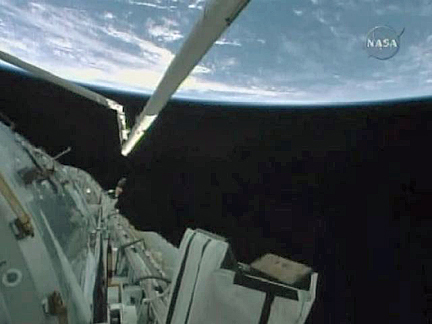
Endeavour's robot arm lifts the orbiter boom sensor system prior
to a detailed heat shield inspection. (Credit: NASA)
As with all post-Columbia missions, an inspection of the shuttle's reinforced carbon carbon nose cap and wing leading edge panels was the highlight of the day. The nose cap and leading edge panels experience the most extreme heating during re-entry and the post-launch inspection is designed to look for any signs of damage from ascent debris impacts.
Using the shuttle's robot arm and a 50-foot-long extension equipped with a laser scanner and high-resolution camera, the astronauts planned to inspect the shuttle's right wing leading edge first, then the nose cap and finally the left wing.
"It's a busy day for us," commander George Zamka said in a NASA interview. "We start running right out of the gate and Kay (Hire) and Nick will take the shuttle's robotic arm and grapple to the orbiter boom sensing system which we keep on the starboard side of the orbiter. They'll pull that out and they'll begin to image several parts of the orbiter but the meat of the inspection is using the Laser Dynamic Range Imager, which paints a three-dimensional picture of the leading edges of the shuttle and the nose as well, and we transmit those images down to Houston.
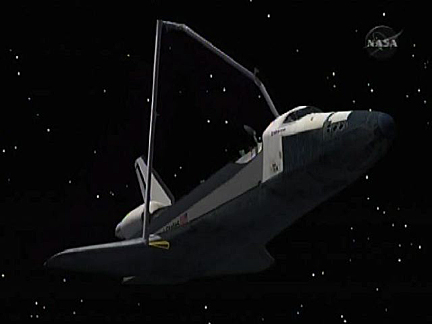
A computer graphic showing the OBSS, on the shuttle's robot arm,
inspecting the ship's right wing. (Credit: NASA)
"It takes a good part of the day for us to do that (and) we'll be swapping crews. Kay and Nick stop and then we'll be tag teaming as we go along through this inspection and when it's done, Kay gets back on and she and Terry will stow the boom back in its housing on the right side."
Later in the day, the crew will set up and check out the tools needed for the rendezvous with the International Space Station. Docking is targeted for 12:06 a.m. Wednesday.
"We use a handheld laser and we also have different systems on board configuring our computers to make sure that we're all set to go to monitor our rendezvous," Hire said. "We also monitor the actual location of the International Space Station and we start tracking that and start tracking how we're closing that distance between us. Then on flight day three, we will go ahead and rendezvous and dock with the International Space Station ... and start getting set up for the rest of the mission."
Here is an updated timeline of today's activity (in EST and mission elapsed time; includes revision C of the NASA television schedule):
EDT............DD...HH...MM...EVENT 02/08 Mon 06:14 PM...00...14...00...Crew wakeup Mon 07:44 PM...00...15...30...OMS rocket pod survey Mon 08:39 PM...00...16...25...FRED setup Mon 08:49 PM...00...16...35...Group B powerup Mon 09:04 PM...00...16...50...Ergometer setup Mon 09:14 PM...00...17...00...Laptop computer network setup (part 2) Mon 09:33 PM...00...17...18...NC-2 rendezvous rocket firing Mon 09:34 PM...00...17...20...Shuttle robot arm (SRMS) unberths OBSS Mon 09:49 PM...00...17...35...Group B powerdown Mon 11:04 PM...00...18...50...OBSS starboard wing survey Mon 11:59 PM...00...19...45...Crew meals begin 02/09 Tue 01:09 AM...00...20...55...OBSS nose cap survey Tue 01:59 AM...00...21...45...Spacesuit checkout preps Tue 02:24 AM...00...22...10...OBSS port wing survey Tue 02:29 AM...00...22...15...Spacesuit checkout Tue 03:59 AM...00...23...45...Spacesuit prepped for transfer to station Tue 04:00 AM...00...23...46...Mission status briefing on NTV Tue 04:14 AM...01...00...00...SRMS berths OBSS Tue 05:14 AM...01...01...00...FCMS ops Tue 05:44 AM...01...01...30...Centerline camera setup Tue 05:44 AM...01...01...30...Rendezvous tools checkout Tue 06:04 AM...01...01...50...Orbiter docking system ring extension Tue 06:42 AM...01...02...28...NC-3 rendezvous rocket firing Tue 07:14 AM...01...03...00...Laser data downlink Tue 09:14 AM...01...05...00...Crew sleep begins Tue 10:00 AM...01...05...46...Daily highlights reel Tue 12:00 PM...01...07...46...Solar Dynamics Observatory (SDO) webcast Tue 01:00 PM...01...08...46...SDO pre-launch news conference on NTV Tue 04:30 PM...01...12...16...Post-MMT briefing Tue 05:14 PM...01...13...00...Crew wakeup
5:00 AM, 2/8/10: Shuttle Endeavour roars into space in final night launch (UPDATED at 6:50 a.m. with foam assessment)
The shuttle Endeavour, carrying six astronauts, a 15-ton life support module and a bay window observation deck for the International Space Station, thundered into orbit early Monday, putting on a spectacular pre-dawn show in the program's final planned night launch.
With commander George Zamka and pilot Terry Virts at the controls, Endeavour's three main engines ignited with a rush of fiery exhaust and quickly throttled up to full power. Seconds later, at 4:14:07 a.m. EST, the shuttle's twin solid-fuel boosters fired, explosive bolts detonated and the spaceplane vaulted away from pad 39A.
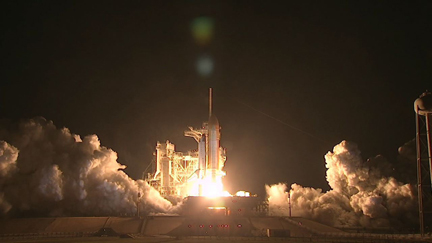
The shuttle Endeavour climbs away from pad 39A. (Photo: NASA TV)
A launch attempt Sunday was called off due to low clouds over the Kennedy Space Center, but the weather cooperated for the second attempt. While low clouds caused concern early in the countdown, they thinned out as launch time approached.
Majestically wheeling about to line up on a northeasterly trajectory, Endeavour was visible for hundreds of miles around as it quickly climbed skyward atop twin jets of 5,000-degree flame.
Lighting scattered clouds from above, Endeavour's boosters gave area residents and tourists a breathtaking show as the shuttle began the first of the program's final five flights.
Live television views from a camera mounted on the side of the ship's external tank showed what appeared to be a relatively large piece of foam insulation falling from the tank about two minutes into flight. Bill Gerstenmaier, chief of NASA's space flight operations, said the debris did not appear to strike the shuttle's heat shield.
"At about two minutes, we saw a piece of intertank stringer foam come off," he said. "It's probably╩about a quarter inch thick, maybe about a foot or so long. It didn't appear to impact the orbiter and we see no damage to the orbiter. It's something similar to what we've seen before."
As with all post-Columbia shuttle flights, engineers will study the on-board and ground-based imagery over the next few days to verify the condition of the heat shield.
Endeavour's huge boosters appeared to perform normally, separating as planned about two minutes and five seconds after blastoff. The shuttle's hydrogen-fueled main engines continued firing for another six-and-a-half minutes, boosting the spaceplane into the planned preliminary orbit before shutting down at 4:22 a.m.
"Just got a fantastic view from Long Island of Endeavour on it's way to orbit!" Tom Liverani, a space enthusiast, said in an email. "Was able to see approximately 30 seconds of powered flight. Unbelievable sight!" Gerry Haas spotted Endeavour from Abington, Mass., as it neared the end of the climb to orbit. "Saw last 20 seconds of powered flight then another 30 seconds of RCS (maneuvering jet firings) as they were getting off tank," Haas emailed. "Always so cool to see it launch on TV and then step out and see it fly by eight minutes later."Zamka, Virts and their crewmates - Kathryn Hire, flight engineer Stephen Robinson and spacewalkers Robert Behnken and Nicholas Patrick - faced a busy first few hours in space, doffing their bulky pressure suits and rigging Endeavour's systems for orbital flight.
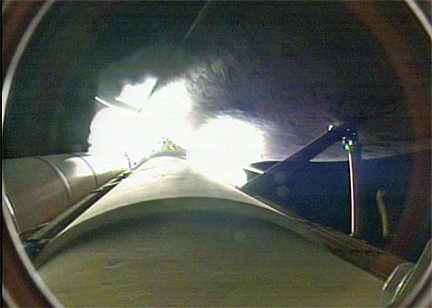
Debris can be seen separating from the external tank to the right
of the bipod structure. (Photo: NASA TV)

Endeavour separates from the external tan after reaching space.
No obvious signs of foam impact damage are visible.
Photo: NASA TV)
The primary goal of the mission is the delivery and installation of the Tranquility module and a seven-pane cupola that promises spectacular bay-window views of Earth and approaching spacecraft.
Tranquility will be attached to the left side of the station's central Unity module, providing a home for life support equipment, exercise gear and a toilet, all currently housed elsewhere in the station.
The astronauts also will deliver replacement hardware to overhaul the lab's water recycling system, the complex equipment that turns sweat and urine into ultra-pure water for drinking, crew hygiene and oxygen generation. The system has been out of action in recent weeks because of higher-than-expected calcium concentrations in a critical distillation assembly.
To give that system time to operate and assess its performance before Endeavour departs, the crew plans to delay moving the life-support systems into the new module, possibly extending the flight by one day. If that is not possible, the life support racks will be installed by the station crew after the shuttle undocks.
"Currently, we have a lot of those life support racks spread throughout the station and they're in the locations where crew members are either doing scientific experiments or exercising or eating," said Zamka. "The volume in which they're doing all that is fairly small.
"Once those racks have been moved into Tranquility, they will be out of the laboratory spaces so the labs can be for science and Tranquility will become the home for the water regeneration system, the atmospheric revitalization system and those things. And also exercise. ... So that's a big change for the astronauts."
The other major addition - the multi-window cupola - will improve the quality of life aboard the station. Full-time crew members now have sleep stations and internet access. With Endeavour's mission, they will get a bay window on the world.
Along with providing a home for a robot arm work station, the cupola will let the crew "look outside," Zamka said, "it'll be kind of a hemispheric place where they can look out and see tremendous views of the Earth."
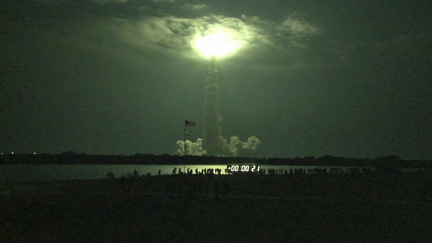
Endeavour climbs above the clouds as it heads for space.
(Photo: NASA TV)
Over the next two days, Zamka and Virts will carry out a series of rendezvous rocket firings to catch up with the International Space Station. Docking at the forward end of the lab complex is expected around 12:53 a.m. Wednesday.
Tranquility, also known as node 3, was built by Thales Alenia Space of Italy. It is scheduled for attachment to the station during the crew's first spacewalk overnight Thursday. Two additional spacewalks by Behnken and Patrick are planned to connect long ammonia coolant lines and to outfit the cupola, launched on one end of the new module and then moved to its permanent location on Tranquility's Earth-facing port.
Going into the flight, NASA planners do not assume a mission extension. As such, Endeavour is scheduled to undock Feb. 18 and to land back at the Kennedy Space Center around 10:01 p.m. two days later. If the flight is extended, those dates would slip accordingly.
"We are exceptionally excited about the prospect of sending this crew on its way to the International Space Station," said lead shuttle Flight Director Kwatsi Alibaruho. "This mission is not only the first mission of 2010, it's also expected to be the last night launch of the shuttle, and so many folks are excited about seeing that.
"This mission also represents the end of U.S. segment assembly. Node 3 is the last U.S.-produced module which will be added to the International Space Station."
01:05 AM, 2/8/10: Astronauts board shuttle; launch team monitors weather
The Endeavour astronauts returned to launch pad 39A early Monday and strapped in for a second attempt to blast off on a long-awaited space station assembly mission. Liftoff is targeted for 4:14:08 a.m. EST, roughly the moment Earth's rotation carries the pad into the plane of the International Space Station's orbit.
Engineers refueled the shuttle late Sunday, pumping a half-million gallons of super-cold liquid oxygen and hydrogen rocket fuel into the ship's external tank, finishing the three-hour procedure just before 10 p.m.
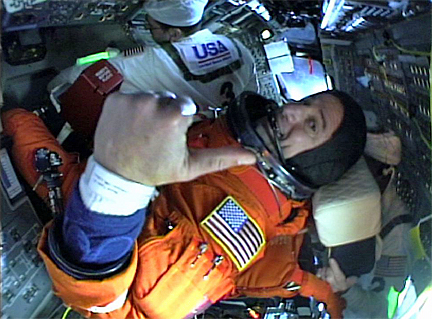
Shuttle commander George Zamka flashes a thumbs up after
getting into his seat aboard Endeavour. (Photo: NASA TV)
There are no technical problems of any significance at pad 39A, but launch managers are keeping tabs on low clouds that could cause problems.
An attempt to launch Endeavour early Sunday was called off during a hold at the T-minus nine-minute mark because of a 500-foot-thick deck of clouds at 3,800 feet, obscuring the shuttle's emergency runway and violating NASA's return-to-launch-site flight rules.
Forecasters predicted a 40 percent chance of more low clouds for Monday's launch attempt but they were hopeful the weather would cooperate.
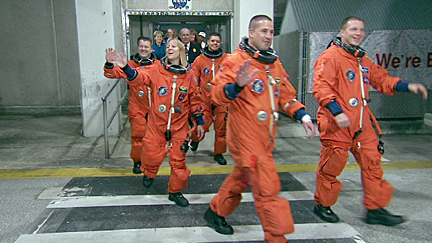
The Endeavour astronauts depart crew quarters and head for pad 39A.
(Photo: NASA TV)
Hoping for the best, Endeavour's crew - commander George Zamka, pilot Terry Virts, Kathryn Hire, flight engineer Stephen Robinson and spacewalkers Robert Behnken and Nicholas Patrick - departed their quarters shortly before 12:30 a.m. and began strapping in about a half-hour later.
07:30 PM, 2/7/10: Shuttle fueling begins for second launch try
Hoping for a break from the weather, engineers began refueling the shuttle Endeavour Sunday evening, setting the stage for a pre-dawn Monday launch to deliver a new module to the International Space Station.
Working by remote control, engineers began the three-hour fueling procedure at 6:50 p.m. EST, chilling down propellant feed lines before pumping a half-million gallons of liquid oxygen and hydrogen rocket fuel into the shuttle's huge external tank.
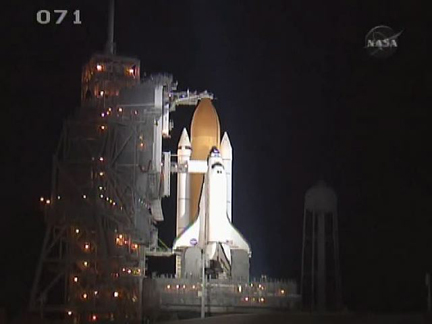
The shuttle Endeavour is refueled for launch. (Credit: NASA)
If all goes well, fueling will be complete by around 10 p.m. Endeavour's crew - commander George Zamka, pilot Terry Virts, Kathryn Hire, flight engineer Stephen Robinson and spacewalkers Robert Behnken and Nicholas Patrick - plans to begin strapping in around 12:54 a.m. Monday to await launch at 4:14:08 a.m.
There are no technical problems of any significance at pad 39A, but forecasters are predicting a 40 percent chance for a low deck of clouds over the Kennedy Space Center that could prompt a delay. A broken layer of low clouds early Sunday blocked the crew's initial launch try.
If Endeavour does not get off Monday, the flight likely will be delayed until Feb. 13, after the Wednesday launch of NASA's Solar Dynamics Observatory on an $848 million mission to study the sun.
Here is a timeline for major events in the remainder of Endeavour's countdown:
EST...........EVENT Sun 02/07/10 09:49 PM......Begin 2-hour 30-minute built-in hold (T-minus 3 hours) 09:49 PM......Closeout crew to white room 09:49 PM......External tank in stable replenish mode 10:04 PM......Astronaut support personnel comm checks 10:34 PM......Pre-ingress switch reconfig 11:00 PM......NASA TV coverage begins 11:49 PM......Final crew weather briefing 11:54 PM......Crew suit up begins Mon 02/08/10 12:19 AM......Resume countdown (T-minus 3 hours) 12:24 AM......Crew departs O&C building 12:54 AM......Crew ingress 01:44 AM......Astronaut communications checks 02:09 AM......Hatch closure 02:39 AM......White room closeout 02:59 AM......Begin 10-minute built-in hold (T-minus 20m) 03:09 AM......NASA test director countdown briefing 03:09 AM......Resume countdown (T-minus 20m) 03:10 AM......Backup flight computer to OPS 1 software load 03:14 AM......KSC area clear to launch 03:20 AM......Begin final built-in hold (T-minus 9m) 03:50:08 AM...NTD launch status verification 04:05:08 AM...Resume countdown (T-minus 9m) 04:09:08 AM...Orbiter access arm retraction 04:09:08 AM...Launch window opens 04:09:08 AM...Hydraulic power system (APU) start 04:09:13 AM...Terminate liquid oxygen replenish 04:10:08 AM...Purge sequence 4 hydraulic test 04:10:08 AM...Inertial measurement units to inertial 04:10:13 AM...Aerosurface profile 04:10:38 AM...Main engine steering test 04:11:13 AM...Liquid oxygen tank pressurization 04:11:33 AM...Fuel cells to internal reactants 04:11:38 AM...Clear caution-and-warning memory 04:12:08 AM...Crew closes visors 04:12:11 AM...Liquid hydrogen tank pressurization 04:13:18 AM...Booster joint heater deactivation 04:13:37 AM...Shuttle flight computers take control of countdown 04:13:47 AM...Booster steering test 04:14:01 AM...Main engine start (T-6.6 seconds) 04:14:08 AM...Booster ignition (LAUNCH)
Assuming an on-time liftoff, here's the NASA television schedule for the crew's first day in space (in EST, GMT and mission elapsed time; best viewed with fixed-width font):
REV.EVENT..............................MET DD/HH:MM...EST........GMT MONDAY, FEBRUARY 8 - FD 1/FD 2 ...LAUNCH..................................00/00:00...04:14 AM...09:14 ...MECO....................................00/00:08...04:22 AM...09:22 1...LAUNCH REPLAYS ........................00/00:13...04:27 AM...09:27 1...POST LAUNCH NEWS CONFERENCE............00/01:01...05:15 AM...10:15 2...PAYLOAD BAY DOOR OPENING...............00/01:25...05:39 AM...10:39 3...ASCENT FLIGHT TEAM VIDEO REPLAY........00/03:46...08:00 AM...13:00 3...ROBOT ARM CHECKOUT.....................00/04:10...08:24 AM...13:24 4...EXTERNAL TANK HANDHELD VIDEO DOWNLINK..00/04:35...08:49 AM...13:49 5...ENDEAVOUR CREW SLEEP BEGINS............00/06:00...10:14 AM...15:14 5...FLIGHT DAY 1 HIGHLIGHTS................00/06:46...11:00 AM...16:00 6...VIDEO FILE.............................00/07:46...12:00 PM...17:00 10...ENDEAVOUR CREW WAKE UP (FD 2).........00/14:00...06:14 PM...23:14
4:50 AM, 2/7/10: Shuttle launch delayed by low clouds (UPDATED at 6:00 a.m.)
Launch of the shuttle Endeavour on a space station assembly mission was delayed 24 hours, from Sunday to Monday, because of an unexpected deck of low clouds that swept over the Kennedy Space Center in the pre-dawn hours.
"We tried really, really hard to work the weather," Launch Director Mike Leinbach radioed commander George Zamka from the firing room. "It was just too dynamic. We got to feeling good there at one point and then it filled back in and we just were not comfortable launching a space shuttle tonight.
"So, we're going to go into a 24-hour scrub. Thank you all for the efforts you all put in tonight. We'll see you back again tomorrow night and we hope the weather's a little bit better."
"And Mike from Endeavour, we understand and we'll give it another try tomorrow night," Zamka replied.
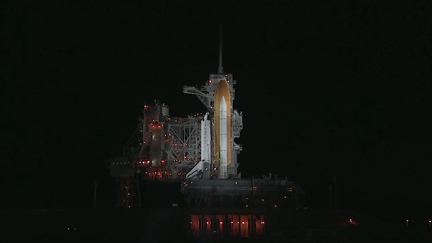
The shuttle Endeavour, moments after a launch scrub was
declared. (Photo: NASA TV)
Zamka and his crewmates - pilot Terry Virts, Kathryn Hire, flight engineer Stephen Robinson and spacewalkers Robert Behnken and Nicholas Patrick left the shuttle about an hour after the countdown was called off.
Forecasters are predicting a 60 percent chance of favorable weather Monday and Tuesday with the concern being low clouds over the Kennedy Space Center that could go broken and violate NASA's flight rules for an emergency return-to-launch-site abort and landing.
After discussing the forecast following Sunday's launch scrub, NASA managers opted to try again Monday. Assuming no other issues develop, engineers will begin fueling the shuttle around 6:45 p.m. Sunday, setting the stage for a launch attempt at 4:14:08 a.m. Monday.
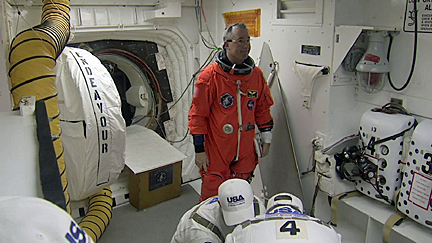
Astronaut Stephen Robinson exits Endeavour. (Photo: NASA TV)
The shuttle delay means a one-day slip for launch of NASA's Solar Dynamics Observatory science satellite, from Tuesday to Wednesday, atop a United Launch Alliance Atlas 5 rocket. If Endeavour fails to get off the ground Monday, the shuttle flight will slip to Feb. 13, after the SDO mission.
02:00 AM, 2/7/10: Astronauts strap in for launch
With the shuttle Endeavour's external tank loaded with rocket fuel, the ship's six crew members began strapping in around 1:30 a.m. to await liftoff at 4:39:50 a.m. EST.
There are no technical problems of any significance at pad 39A, but forecasters are concerned about an approaching deck of low clouds that could pose problems. On Saturday, forecasters predicted an 80 percent chance of good weather at launch time, but that was reduced to 60 percent "go" early Sunday.
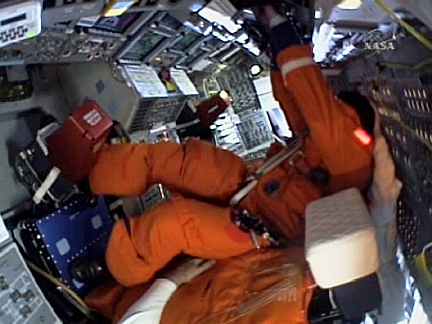
Shuttle commander George Zamka climbs into his seat aboard Endeavour.
(Photo: NASA TV)
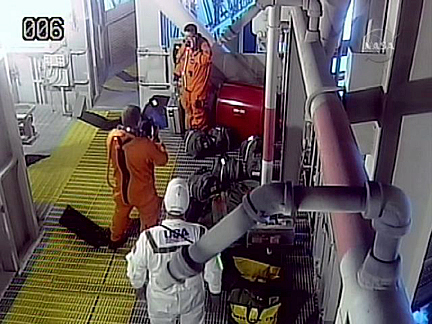
Astronaut Nicholas Patrick takes a picture of fellow spacewalker
Robert Behnken, making a final phone call from the 195-foot
level at pad 39A. (Photo: NASA TV)
Hoping for the best, commander George Zamka, pilot Terry Virts, Kathryn Hire, flight engineer Stephen Robinson and spacewalkers Robert Behnken and Nicholas Patrick were all smiles as they headed to the pad to strap in.

Commander George Zamka, front left, waves to supporters
as he and pilot Terry Virts lead the astronauts from crew
quarters. (Photo: NASA TV)
08:05 PM, 2/6/10: Shuttle fueling begins
Engineers began pumping a half-million gallons of super-cold liquid oxygen and hydrogen rocket fuel into the shuttle Endeavour's external tank Saturday evening, setting the stage for a pre-dawn Super Bowl Sunday launch. It is the final planned night launch in NASA's remaining five-mission manifest.
The three-hour fueling procedure began at 7:47 p.m. EST, about a half hour behind schedule because of a minor problem with ground equipment. The delay should have no impact and NASA launch commentary is scheduled to begin at 11:30 p.m.
Endeavour's crew - commander George Zamka, pilot Terry Virts, Kathryn Hire, flight engineer Stephen Robinson and spacewalkers Robert Behnken and Nicholas Patrick - plans to begin strapping in around 1:19 a.m. Sunday.
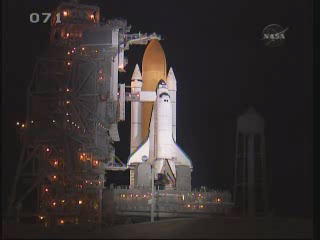
Shuttle Endeavour ready for fueling. (Photo: NASA TV)
The goal of the 130th shuttle mission is to deliver a new module and a bay-window cupola to the International Space Station. As such, liftoff is targeted for 4:39:50 a.m., roughly the moment Earth's rotation carries the launch pad into the plane of the station's orbit.
After downlinking imagery of the shuttle's external tank, setting up laptop computers and testing the ship's robot arm, the astronauts plan to go to bed around 10:39 a.m. Wakeup is scheduled for 6:39 p.m.
There are no technical problems of any significance at pad 39A and forecasters are continuing to predict an 80 percent chance of good weather. Here is the remainder of this evening's countdown (in EST):
EST...........EVENT 10:14 PM......Begin 2-hour 30-minute built-in hold (T-minus 3 hours) 10:47 PM......Closeout crew to white room 10:47 PM......External tank in stable replenish mode Sun 02/07/10 12:14 AM......Final crew weather briefing 12:19 AM......Crew suit up begins 12:44 AM......Resume countdown (T-minus 3 hours) 12:49 AM......Crew departs O&C building 01:19 AM......Crew begins strapping in 02:09 AM......Astronaut comm checks 02:34 AM......Hatch closure 03:04 AM......White room closeout 03:24 AM......Begin 10-minute built-in hold (T-minus 20m) 03:34 AM......NASA test director countdown briefing 03:34 AM......Resume countdown (T-minus 20m) 03:35 AM......Backup flight computer to OPS 1 software load 03:39 AM......KSC area clear to launch 03:45 AM......Begin final built-in hold (T-minus 9m) 04:15:50 AM...NTD launch status verification 04:30:50 AM...Resume countdown (T-minus 9m) 04:34:50 AM...Orbiter access arm retraction 04:34:50 AM...Launch window opens 04:34:50 AM...Hydraulic power system (APU) start 04:34:55 AM...Terminate LO2 replenish 04:35:50 AM...Purge sequence 4 hydraulic test 04:35:50 AM...Inertial measurement units to inertial 04:35:55 AM...Aerosurface test profile 04:36:20 AM...Main engine steering test 04:36:55 AM...LO2 tank pressurization 04:37:15 AM...Fuel cells to internal reactants 04:37:20 AM...Clear caution-and-warning memory 04:37:50 AM...Crew closes visors 04:37:53 AM...LH2 tank pressurization 04:39:00 AM...Booster joint heater deactivation 04:39:19 AM...Shuttle flight computers take control of countdown 04:39:29 AM...Booster steering test 04:39:43 AM...Main engine start (T-6.6 seconds) 04:39:50 AM...SRB ignition (LAUNCH)Assuming an on-time launch, here is the NASA television schedule for the crew's first day in space:
REV.EVENT................................MET DD/HH:MM...EST........GMT SUNDAY, FEBRUARY 7 - Flight Day 1/FD 2 ...LAUNCH....................................00/00:00...04:39 AM...09:39 ...MECO......................................00/00:08...04:47 AM...09:47 1...LAUNCH REPLAYS T=30:00...................00/00:13...04:52 AM...09:52 1...POST LAUNCH NEWS CONFERENCE..............00/00:51...05:30 AM...10:30 2...PAYLOAD BAY DOOR OPENING.................00/01:25...06:04 AM...11:04 3...ASCENT FLIGHT CONTROL TEAM VIDEO REPLAY..00/03:51...08:30 AM...13:30 3...RMS CHECKOUT.............................00/04:10...08:49 AM...13:49 4...EXTERNAL TANK HANDHELD VIDEO DOWNLINK....00/04:35...09:14 AM...14:14 5...ENDEAVOUR CREW SLEEP BEGINS..............00/06:00...10:39 AM...15:39 5...FLIGHT DAY 1 HIGHLIGHTS..................00/06:21...11:00 AM...16:00 10...ENDEAVOUR CREW WAKE UP (FD 2)...........00/14:00...06:39 PM...23:39 12...OBSS UNBERTH............................00/17:00...09:39 PM...02:39 13...RMS/OBSS TPS SURVEY BEGINS..............00/18:30...11:09 PM...04:09 MONDAY, FEBRUARY 8 - FD 2/FD 3 16...MISSION STATUS BRIEFING.................00/23:21...04:00 AM...09:00 17...OBSS BERTH..............................00/23:40...04:19 AM...09:19 17...CENTERLINE CAMERA INSTALLATION..........01/01:00...05:39 AM...10:39 18...ODS RING EXTENSION......................01/01:30...06:09 AM...11:09 18...RENDEZVOUS TOOL CHECKOUT................01/01:55...06:34 AM...11:34 20...ENDEAVOUR CREW SLEEP BEGINS.............01/05:00...09:39 AM...14:39
01:25 PM, 2/5/10: Shuttle countdown on track; weather improves to 80 percent 'go'
The shuttle Endeavour's countdown is ticking smoothly toward launch Sunday on a space station assembly mission, NASA managers said Friday. There are no technical problems of any significance at pad 39A and the weather forecast has improved to 80 percent "go."
NASA's Mission Management Team held a launch-minus-two-day readiness review and "we're in really good shape," said MIke Moses, director of shuttle integration at the Florida space center. "We had a fantastic review this morning, a unanimous poll pressing forward to go for launch. Everybody's ready to go. ... No significant issues."

The shuttle Endeavour at launch complex 39A. (Photo: NASA TV)
Endeavour and its six-person crew - commander George Zamka, pilot Terry Virts, Kathryn Hire, flight engineer Stephen Robinson and spacewalkers Robert Behnken and Nicholas Patrick - are scheduled for launch at 4:39:47 a.m. EST Sunday, roughly the moment Earth's rotation carries the pad into the plane of the International Space Station's orbit.
"No issues out at the pad, the team is energized, the team is excited about the countdown, looking forward to getting Endeavour off the ground Sunday morning," said Launch Director Michael Leinbach.
Shuttle weather officer Kathy Winters said a cold front was expected to move through central Florida overnight Friday, bringing high winds and rain, but conditions were expected to improve Saturday.
"Weather is looking pretty good overall for launch," she said. "We do have a weather system that's going to be moving into the area this evening ... and that will cause some showers and storms to roll through the area. But the good news is that's all going to move out ... so we should be able to move right into our pre-launch operations without violating any weather constraints.
"By the time we get into the evening hours Saturday, the temperatures are going to start to drop, it's going to be cold and breezy out there but we're not forecasting any constraint violations. And so although it'll be windy at the launch pad at launch time, we are only going with a 20 percent chance of KSC weather prohibiting launch."
The forecast for Monday and Tuesday is also in the 80-percent-favorable range, but stormy weather at the shuttle's emergency runways in Europe could cause problems if the flight is delayed to Monday. Conditions in Europe improve on Tuesday.
Engineers plan to retract a protective gantry from around Endeavour at 8 a.m. Saturday. If all goes well, the three-hour process to load the shuttle's external tank with a half-million gallons of liquid oxygen and hydrogen rocket fuel will begin around 7:14 p.m. and the astronauts will begin strapping in around 1:20 a.m. Sunday to await liftoff.
A detailed mission preview is posted in the CBS News STS-130 Mission Archive. A detailed countdown timeline, flight plan, launch windows chart and other useful information is available on the CBS News STS-130 Quick-Look page.
1 PM, 2/5/10: STS-130 Mission Preview
KENNEDY SPACE CENTER, Fla. -- Reeling from a morale-sapping change of course, engineers are readying Endeavour for launch Sunday on NASA's final five shuttle missions, a three-spacewalk flight to attach a 15-ton crew module to the International Space Station.
Equipped with a seven-pane cupola that promises spectacular bay-window views of Earth and approaching spacecraft, the Tranquility module will be attached to the left side of the station's central Unity module, providing a home for life support equipment, exercise gear and a toilet, all currently housed elsewhere in the station.
The astronauts also will deliver replacement hardware to overhaul the lab's water recycling system, the complex equipment that turns sweat and urine into ultra-pure water for drinking, crew hygiene and oxygen generation. The system has been out of action in recent weeks because of higher-than-expected calcium concentrations in a critical distillation assembly.
To give that system time to operate and assess its performance before Endeavour departs, the crew plans to delay moving the life-support systems into the new module, possibly extending the flight by one day. If that is not possible, the life support racks will be installed by the station crew after the shuttle undocks.
"Currently, we have a lot of those life support racks spread throughout the station and they're in the locations where crew members are either doing scientific experiments or exercising or eating," said shuttle commander George Zamka. "The volume in which they're doing all that is fairly small.
"Once those racks have been moved into Tranquility, they will be out of the laboratory spaces so the labs can be for science and Tranquility will become the home for the water regeneration system, the atmospheric revitalization system and those things. And also exercise. ... So that's a big change for the astronauts."
The other major addition - the multi-window cupola - will improve the quality of life aboard the station. Full-time crew members now have sleep stations and internet access. With Endeavour's mission, they will get a bay window on the world.
Along with providing a home for a robot arm work station, the cupola will let the crew "look outside," Zamka said, "it'll be kind of a hemispheric place where they can look out and see tremendous views of the Earth."
Zamka and his crewmates - pilot Terry Virts, Kathryn Hire, flight engineer Stephen Robinson and spacewalkers Robert Behnken and Nicholas Patrick - are scheduled for liftoff from pad 39A at the Kennedy Space Center Sunday at 4:39:47 a.m. EST, roughly the moment Earth's rotation carries the pad into the plane of the station's orbit.
Forecasters are predicting a 70 percent chance of acceptable weather Sunday, improving to 90 percent "go" Monday and dropping back to 80 percent favorable Tuesday. NASA can make two attempts to launch Endeavour during that three-day period.
If the shuttle tries Sunday and Monday and doesn't make it, launch would slip to Feb. 13, after the Feb. 10 launch of NASA's Solar Dynamics Observatory science satellite. If Endeavour tries Sunday and Tuesday and doesn't make it, launch would slip to Feb. 14 and NASA would try to launch the SDO mission Feb. 11. If the shuttle takes off on schedule Sunday, SDO would go on Feb. 9.
Assuming Endeavour takes off on time, Zamka will guide the orbiter to a docking with pressurized mating adapter No. 2 on the forward end of the International Space Station around 1:18 a.m. Tuesday.
Tranquility, also known as node 3, was built by Thales Alenia Space of Italy. It is scheduled for attachment to the station during the crew's first spacewalk. Two additional spacewalks by Behnken and Patrick are planned to connect long ammonia coolant lines and to outfit the cupola, launched on one end of the new module and then moved to its permanent location on an Earth-facing port.
Going into the flight, NASA planners do not assume a mission extension. As such, Endeavour is scheduled to undock around 7:12 p.m. on Feb. 17 and to land back at the Kennedy Space Center around 11:13 p.m. two days later. If the flight is extended, those dates would slip accordingly.
"We are exceptionally excited about the prospect of sending this crew on its way to the International Space Station," said lead shuttle Flight Director Kwatsi Alibaruho. "This mission is not only the first mission of 2010, it's also expected to be the last night launch of the shuttle, and so many folks are excited about seeing that.
"This mission also represents the end of U.S. segment assembly. Node 3 is the last U.S.-produced module which will be added to the International Space Station."
Launch of the 130th shuttle mission comes just one week after the Obama administration unveiled NASA's fiscal 2011 budget, killing the agency's post-Columbia moon program and ordering a near-term switch to private-sector rockets for post-shuttle flights to and from low-Earth orbit.
The reaction of many space agency insiders has been decidedly negative, with some decrying what they fear will be a loss of institutional knowledge and operational experience, decreased safety and the absence of any long-range mission to move out of Earth orbit into the solar system.
NASA Administrator Charles Bolden insists those fears are unfounded, saying the new direction will give the agency a chance to focus on developing new technologies to facilitate eventual deep space missions while turning over more mundane flights to and from low-Earth orbit to the private sector.
Asked when NASA might unveil a long-range exploration strategy to replace Constellation, he said "it's more than a couple of weeks but it's less than years."
"We're already starting to form tiger teams that will help us come up with a schedule for how we're going to go about developing a new plan, a bold plan for exploration," he said. "Anybody who talks about exploration beyond low-Earth orbit, there are some places that naturally come to mind - the moon, Mars, asteroids, other near-Earth objects. ... We hope very soon to be able to give you a very definitive time schedule on which we hope to reach some of these destinations."
Asked about the perception that NASA is turning its back on manned spaceflight, Bolden said "we are not abandoning human spaceflight by any stretch of the imagination."
"I think we're going to get there perhaps quicker than we would have done before," he said, adding later that commercial manned rockets could be flying by 2016 if not earlier.
NASA's $19 billion 2011 budget supports extending the space station's life through 2020 and provides money to support the shuttle program through the end of 2010 or early 2011 if technical problems prevent NASA from launching all five remaining flights before the end of fiscal 2010 as planned.
Between the end of shuttle operations and the debut of whatever vehicle replaces it, U.S. astronauts will be forced to hitch rides to the station aboard Russian Soyuz rockets at more than $50 million a seat.
Closer to home, the shuttle workforce at the Kennedy Space Center is facing the loss of some 7,000 jobs when the shuttle is retired later this year. Despite the cancellation of the Constellation moon program and uncertainty about what sort of rocket will replace the shuttle - and when - NASA managers say the workforce remains focused on safety.
"For me, the space shuttle is an American icon, it's the flagship of the American space program and I'm confident, I'm positive that everyone who works on the space shuttle feels the same way," Zamka said. "So yes, there's a finish line out there but it's going to be a sprint to that finish line, no one's going to be slacking off. I'm as confident of this flight as I have been for any flight previously and the last one will be safe as well."
As for the commercial rockets and capsules that follow the shuttle, Bolden said last week the agency "will set standards and processes to ensure that these commercially built and operated crew vehicles are safe."
"No one cares about safety more than I," he said. "I flew on the space shuttle four times. I lost friends in the two space shuttle tragedies. So I give you my word these vehicles will be safe."
For Endeavour's crew, as for all post-Columbia shuttle flights, the first two days of the mission will be devoted to checking out rendezvous tools, testing the spacesuits and equipment needed for station assembly work and carrying out a series of rendezvous rocket firings to catch up with the lab complex. Given Endeavour's launch time, the mission will be conducted in the deep overnight hours, U.S. time.
During their second "day" in space, the astronauts will use a 50-foot-long boom attached to the end of the shuttle's robot arm to inspect the ship's reinforced carbon carbon nose cap and wing leading edge panels, which experience the most extreme heating during re-entry.
Data from a laser scanner and a high-resolution camera on the end of the orbiter boom sensor system, or OBSS, will be downlinked to Earth for analysis. That data will be folded into an ongoing study of ascent video, radar readings and data from wing leading edge sensors to look for external tank foam insulation losses and any signs of heat shield damage during the climb to space.
Another major inspection will be carried out during Endeavour's final approach to the station.
Approaching from behind and below, Zamka and Virts plan to position the shuttle 600 feet directly below the space station and then carry out a computer-assisted back flip, or rendezvous pitch maneuver, exposing the protective tiles on the shuttle's belly to the station crew. Using powerful telephoto lenses, the lab crew will snap hundreds of photographs and downlink them to the ground for analysis.
With the RPM complete, Zamka will fly the shuttle up to a point 400-feet directly in front of the station. From there, with Endeavour's nose pointed toward deep space and its payload bay docking port facing the station, the shuttle commander will manually guide the spaceplane in for a docking with pressurized mating adapter No. 2 on the front end of the forward Harmony module.
Waiting to welcome Endeavour's crew aboard will be Expedition 22 commander Jeffrey Williams, Russian flight engineers Maxim Suraev and Oleg Kotov, Japanese astronaut Soichi Noguchi and NASA flight engineer Timothy Creamer.
After a brief welcome ceremony and a mandatory safety briefing to familiarize the shuttle crew with space station emergency procedures, the combined crews will get to work, transferring spacesuits from Endeavour to the lab and using the station's robot arm to remove the OBSS from the shuttle's payload bay and hand it off to the orbiter's robot arm.
The next day, flight day four, Behnken and Patrick will prepare their tools and equipment for the first of three planned spacewalks while their crewmates move supplies and hardware from the shuttle to the space station. That afternoon, the shuttle crew will enjoy a half day off to relax and catch its collective breath.
Williams, meanwhile, will spend much of that day and the next installing replacement equipment in the station's water recycling system.
The station's urine processor has been shut down in recent weeks because of problems with a critical distillation assembly. More recently, blockage in a line knocked out the part of the system that converts condensate into clean water.
"We brought home the other failed distillation assembly on the last shuttle flight," said station Program Manager Mike Suffredini. "Through a failure investigation, we found calcium deposits inside the distillation assembly and we're doing quite a bit of investigation to determine how to prevent that in the future.
"One way is to not process to as high a concentration of brine inside the system, meanin g we empty the tank that carries the ultimate waste from the urine processor, we empty it a little more often. So we want to run the processor with the new distillation assembly inside long enough to fill the tank up to the new level we plan to operate at, remove that tank and bring it home.
"That will take us almost the entire mission, from the time we're able to install the spare until the time the crew has to depart," Suffredini said. "That's what's driving us not to do the rest of the rack moves until the urine processor can move."
As for the presumed line blockage problem with the water processing system that is preventing conversion of condensate, a filter will be carried up aboard Endeavour that should resolve the issue.
"When the shuttle arrives we'll install the filter and then we'll activate the water processor along with the urine processor and recover our regenerative (environmental control and life support) system by the end of the mission," Suffredini said.
The station has plenty of stockpiled water for extended operations while work to fix the current problems is carried out. Station Flight Director Bob Dempsey described the repairs as "an extensive amount of work."
"Once they complete that work, we'll activate from the ground and begin processing the urine and we'll watch that very closely," he said. "We'll process as much as we can through the mission so the filter/tank assembly gets to be used as much as we can and verify that the system is working in its new configuration and then we'll bring it back on the last day."
As it now stands, the oxygen generation system, the U.S. toilet and the water processing system racks bound for Tranquility will not be moved into the new module during the normal shuttle timeline. If the flight is extended one day as managers hope, the Endeavour astronauts should be able to get some, if not all, of the equipment transferred.
"It is likely during this mission we won't be moving all the regenerative ECLSS (environmental control and life support system) racks into node 3," Suffredini said. "If we get favorable conditions such that we can have (an) extra day and nothing else is needing that day, we may in fact stay one extra day and finish that work. It's not required, we can get the racks all moved during the stage (after Endeavour departs). But the preference is to try to do it during docked ops."
Behnken and Patrick will spend the night of flight day four in the station's Quest airlock module at a reduced pressure of 10.2 pounds per square inch. This now-routine "campout" procedure helps purge nitrogen from the spacewalkers' bloodstreams prior to spending a day in NASA's 5-psi spacesuits.
The primary goal of the first spacewalk is to prepare Tranquility for its extraction from Endeavour's cargo bay and its installation on the left-side port of the Unity module. Robinson will serve as spacewalk coordinator. Behnken, wearing a suit with red stripes, will go by the call sign EV-1 while Patrick, wearing an unmarked suit, will be EV-2.
The spacewalkers will make their way from Quest to the shuttle's payload bay and then split up. Behnken, working at the back of the cargo bay, will remove eight thermal blankets from the module's berthing mechanism while Patrick, working at the forward end of Tranquility, disconnects a shuttle power cable used to operate heaters inside the module.
While astronauts inside the space station use the lab's robot arm to pull Tranquility from Endeavour's payload bay and install it on Unity, Behnken and Patrick will pre-stage two large bags containing ammonia coolant lines and insulation needed for the second spacewalk. They then will move to the Canadian DEXTRE robot and remove a stowage tray that will be replaced during a subsequent flight.
"On the first spacewalk, the biggest concern is getting power to node 3 after it's attached to the space station," Behnken said in an interview. "The timer that's running on it for its keep-alive power is longer than an EVA but not long enough to go to the next EVA."
With Tranquility mated to Unity's left port, Behnken and Patrick will work to connect power and data cables. But the systems those cables support will not be activated until later, after the ammonia coolant lines are connected during the second and third spacewalks. In the meantime, Patrick will connect a cable to provide keep-alive power to the module's internal heaters.
The next day, the astronauts plan to outfit the vestibule between Tranquility and Unity and then to open the main hatch. But until the cooling system is activated and the module's electrical systems powered up, the astronauts will have to work with flashlights and temporary ventilation hoses while they complete initial preparations.
NASA originally planned to attach Tranquility to Unity's Earth-facing port, but engineers decided to move it to the left side of the module to improve visibility for robot arm operators and to provide more clearance for Soyuz spacecraft docking at a nearby Russian port.
But connectors needed to circulate ammonia coolant to and from Tranquility were not correctly positioned, or "clocked," for Tranquility to be attached to Unity's left-side port. Long 16-foot extension hoses were ordered, but problems during recent pressure tests forced NASA to develop an alternative approach.
NASA managers ultimately decided to connect shorter flight-qualified hoses to solve the problem while improvements were ordered to bring the longer hoses up to flight standards as a backup.
For redundancy, the space station has two independent cooling loops and during a second spacewalk on flight day seven, Behnken and Patrick plan to connect the supply and return lines for coolant loop A. Coolant loop B will be connected during the third spacewalk.
First, they will have to unfold a large sheet of multi-layer insulation and tether it in place. Then, the coolant lines will be laid down and the insulation wrapped around them.
"That's the biggest single challenge in all three of the EVAs, is getting the ammonia lines right," said Patrick. "Because there are four of them, and then there's this huge piece of insulation that we call MLI, for multi-layer insulation, it's about 20 feet long but it looks like it's a hundred feet long, shaped like a Y.
"It comes out of the bag very carefully and deliberately and we lay that down along the path of the ammonia jumpers. We put that MLI insulation behind some tethers that hold it in the right place and then, one at a time, we take the ammonia jumpers out of their bag and connect them to the lab and the new node 3 and open the valves."
While no one expects any leaks, the astronauts will be prepared for possible decontamination procedures if any problems are encountered.
"When we first open up the valve and allow the ammonia to flow, that'll be our first indication if there's any leaking," Dempsey said. "If there's something that happens at that point, there's not really any automated computer response. We will shut down the lines, have the crew take some sort of response, which may be to close the valve or something like that.
"If you didn't do anything with a leak, you could drain a large quantity of ammonia," he said. "However, we do have a number of valves at various places, mainly right on both sides where we will open the valves and connect them, that we could shut."
As for the astronauts, procedures are in place to "bake out" any ammonia that might adhere to their spacesuits.
"The second spacewalk, the big issue is the potential for exposure to ammonia," Behnken said. "If we were to release any of that ammonia that will be in those lines after we open the valves, we'll expose ourselves to that and we don't want to bring ammonia inside the space station. Just a very small amount of that could poison the crew on board.
"We have had some ammonia operations in the past that have leaked ammonia on crew members and there are extensive procedures for getting into the sunlight and making sure that ammonia sublimates, bakes off so that you don't bring any of it back inside."
The day after the second spacewalk - flight day eight - the astronauts will remove the multi-window cupola from the outboard end of Tranquility and move it to its permanent position on the module's Earth-facing port. The cupola was launched on the end of Tranquility to fit in Endeavour's cargo bay. Once in its final position, the astronauts working in Tranquility will begin making internal connections between the cupola and the larger module.
On flight day nine, a pressurized mating adapter docking port temporarily stowed on the upward facing port of the forward Harmony module will be moved to Tranquility's outboard port, the same port used by the cupola for launch. The shuttle crew will enjoy another half day off before preparing for the third and final spacewalk on flight day 10.
The goals of the third EVA include connecting the ammonia coolant loop B hoses, removing large insulation blankets from the aluminum shutters protecting the cupola's windows, removing the launch locks that secured the shutters during launch and routing video and data cables between Tranquility, the cupola and PMA-3.
"It's going to be amazing," Patrick said of the cupola. "It's like an observation bubble on an aircraft that let's you get right out there and look all the way around, forwards, aft, left and right and down towards the planet. It's an unprecedented view for people on the space station.
"What it's really for, of course, is robotic operations. The second robotics work station will be set up in the cupola either toward the end of our mission or immediately afterwards and that will allow people to do robotic grapples of approaching spacecraft with a direct out-the-window view, which is a really good thing to have."
Said Zamka: "That'll be tremendous, to be able to stick your head in there and have an outside look back at the space station."
The cupola, also built by Thales Alenia Space, weighs 1.6 tons and measures 7.15 feet across and about 5 feet high, featuring six trapezoidal side windows and a 31.5-inch circular top window, the largest ever launched into space. Each window features a protective "scratch" pane on the interior side, two inch-thick pressure panes and a debris pane on the outside to protect against space debris impacts.
"You basically have multiple layers of protection," Dempsey said. "The shutters are made of aluminum so they are lightweight and don't take up too much mass but do provide a fair amount of structural protection."
When not in use, the windows will be covered by the aluminum shutters, which are manually cranked open and closed by the astronauts. The greatest threat from a debris standpoint is from the front, along the direction of the station's 5-mile-per-second velocity vector. Shutters on the forward-facing windows typically will remain closed unless visibility in that direction is needed. Trailing windows can remain open for longer periods.
Hire will be responsible for opening the shutters for the first time.
"We have flight rules that involve protecting the windows, so we have these shutters on the external side of the windows that we'll keep closed anytime basically somebody's not looking out the window," Hire said. "Certainly, they'll have a good number of the windows open when they're performing robotic arm operations once we move the robotic control station into the cupola."
She said no commands from the ground are required to open the window shutters. While station astronauts presumably will be able to open shutters as desired, "there are external cameras on other parts of the space station that might be pointed over that way and some one might see a shutter open or something like that," Hire said.
She said the astronauts were looking forward to taking in the vista when the cupola is activated and the shutters are finally opened. She said the view should be spectacular, "especially flying over things like a big thunderstorm or something, where you see the lightning jumping from the tops of the different clouds. We send beautiful pictures back to the ground, we take high definition pictures, they're great. But this just doesn't compare.
"We're going to try everything we can to capture that experience and bring that back for you."
Dempsey said a window could be repaired in orbit if necessary, although it would take a fair amount of time to accomplish. A replacement window would have to be launched to the station and the repair work would require two spacewalks.
"We do have spare window assemblies that we could take up and install," Dempsey said. "We do not currently have them or plan to put them on orbit. But they are available. If we had a minor bit of damage, we would probably just close the shutter and keep it closed until we can repair it. If we had major damage, there's the potential that we'd have to close off the entire cupola, but that's very low likelihood.
"What we would do, there's an assembly that would be installed on a spacewalk and placed over the window and shutter assembly, which would then allow us to keep the inside pressurized as we pull that window out, not unlike repairing a window on the Earth. Then put in a new window, make sure the seal is good and then on another spacewalk we'd take that outside cover off."
Following the third and final spacewalk, the astronauts will spend flight day 11 wrapping up the transfer of equipment and supplies from the station to the shuttle. The joint crews will enjoy a final meal together and then the Endeavour astronauts will move back aboard the shuttle. Hatches will be closed and leak checks performed before the crew goes to bed.
The next day, with Virts at the controls, Endeavour will undock from the station. Assuming an on-time launch, undocking would occur around 7:12 p.m. on Feb. 17. After a one-lap photo-documentation fly around, Endeavour will leave the area and the crew will carry out another heat shield inspection to look for any signs of damage that might have occurred since the shuttle reached orbit.
Zamka, Virts and Robinson plan to test the shuttle's re-entry systems on flight day 13 while their crewmates pack up for the trip back to Earth. Landing at the Kennedy Space Center is targeted for 11:13 p.m. on Feb. 19.
12:10 PM, 2/4/10: Countdown begins; weather 70 percent 'go' for Sunday launch
The countdown began early Thursday for the planned pre-dawn launching of the shuttle Endeavour Sunday on a three-spacewalk mission to attach a new module to the International Space Station.
The countdown began on time at 2 a.m. EST and if all goes well, Endeavour will blast off on the first of a final five shuttle missions planned for 2010 at 4:39:47 a.m. Sunday. Forecasters are predicting a 70 percent chance of good weather with the only concern being a chance of high winds out of the north that could cause problems.
"All of our vehicle systems are in great shape, the crews are very excited about the upcoming launch, both flight crew and our ground crews," said NASA Test Director Jeffrey Spaulding. "The countdown itself is going extremely well."
The astronauts - commander George Zamka, pilot Terry Virts, Kathryn Hire, flight engineer Stephen Robinson and spacewalkers Robert Behnken and Nicholas Patrick - flew to the Kennedy Space Center from Houston late Tuesday to prepare for launch.
Shuttle weather officer Kathy Winters said stormy weather from a cold front is expected overnight Friday and early Saturday, but generally good weather is expected in Florida Sunday, Monday and Tuesday. Spaulding said if the weather or some other issue prevented a Sunday launch, NASA managers would pick the best day of the remaining two for a second attempt.
After that, the shuttle team would stand down until after the launch of United Launch Alliance Atlas rocket carrying NASA's Solar Dynamics Observatory science satellite.
"There is an Atlas right behind us," Spaulding said. "From a range perspective, have the seventh, eighth and ninth. If we're not of the ground by that time, we would stand down for the Atlas that would launch two days after us. After their launch, it takes three days to reconfigure the (Air Force Eastern) Range to get us ready again, meaning if we stand down for Atlas, it's a five-day turn before we could come back to try again.
"Right now, we're looking for probably the best two of the three days on the seventh through the ninth and we'll work that as needed for any of our scrub scenarios."
Spaulding said work to clean up water damage in the launch control center from a fire surpression system pipe that ruptured late last month is going well and no problems are expected for Endeavour's launch campaign.
11:20 PM, 2/2/10: Astronauts arrive for shuttle flight; supply ship launched to space station
The shuttle Endeavour's crew flew to the Kennedy Space Center late Tuesday to prepare for launch Sunday on a mission to deliver a new module - Tranquility - to the International Space Station. The module will house life support gear, exercise equipment and a seven-window cupola that promises spectacular views of Earth.
Commander George Zamka, pilot Terry Virts, Kathryn Hire, flight engineer Stephen Robinson and spacewalkers Robert Behnken and Nicholas Patrick landed at the Florida spaceport in a shuttle training jet at 10:09 p.m. EST.
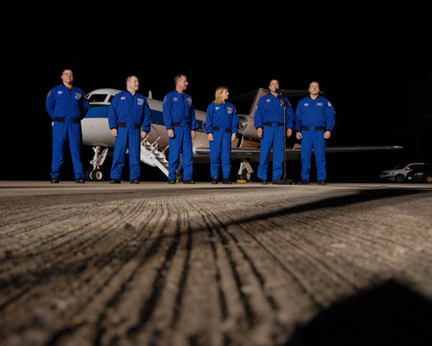
Endeavour's crew arrives at the Shuttle Landing Facility.
(Credit: Ben Cooper/Spaceflight Now)
"Welcome to the STS-130 night shift!" Zamka joked with reporters. "It is the only shift we've got. If you're working STS-130, it is going to be dark outside."
Endeavour's countdown is scheduled to begin at 2 a.m. Thursday, setting up a launch attempt at 4:39 a.m. Sunday. The mission will be conducted during overnight hours in the United States.
"Hey, it is great to be here at the Cape," Zamka said. "We've got Tranquility and cupola loaded up in the space shuttle Endeavour at launch pad 39A and this is the place for us to be."
He said the crew completed its final ascent simulation Monday night "and we're doing final preparations for our mission. Everything with Endeavour sounds like it's going very, very well. We've got a great team here at the Cape and they're doing an excellent job getting ready for 0439 on Sunday, the 7th.
"We talked to the space station crew - (commander) Jeff Williams and company - last night," Zamka said. "They are doing great, and we're all very excited about meeting up with them, rendezvousing with the space station and getting started on on this great project of bringing the Tranquility module to life and putting the cupola in its final position, opening up those shutters and taking a look at the Earth. Go Endeavour!"
Half a world away, a little more than a half hour after crew arrival, engineers at the Baikonur Cosmodrome in Kazakhstan successfully launched an unmanned Progress supply ship on a two-day flight to the International Space Station.
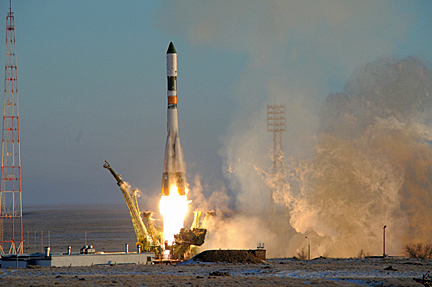
The Progress 36 supply ship blasts off from the Baikonur
Cosmodrome in Kazakhstan. (Credit: RSC Energia)
Liftoff occurred on time at 10:45 p.m. EST and after a smooth climb to space through a cloudless blue sky, the supply ship's solar arrays and antennas deployed as planned. If all goes well, the spacecraft will dock around 11:26 p.m. Thursday at the aft port of the Russian Zvezda command module.
3:00 PM, 1/27/10: Endeavour cleared for Feb. 7 launch (UPDATED at 6 p.m. with post-FRR briefing)
NASA managers Wednesday cleared the shuttle Endeavour for a predawn Superbowl Sunday launch Feb. 7, the first of a final five space station assembly flights before the shuttle fleet is retired later this year.
The countdown is scheduled to begin at 2 a.m. EST on Feb. 4, setting up a launch attempt at 4:39:44 a.m. Feb. 7 from launch pad 39A at the Kennedy Space Center. It is the last planned night launch on the shuttle schedule.
"We reviewed all aspects of the shuttle and the space station," Bill Gerstenmaier, chief of space flight operations, said after an executive-level flight readiness review. "The last flight of last year was a very clean flight for us, it had very few anomalies. Since it was such a clean flight, that allowed this review to go fairly quick, we didn't have really much to talk about.
"It was an extremely thorough review," he added. "We set the launch date for Feb. 7 at 4:39 and so far, things look pretty good."
Launch Director Mike Leinbach said Endeavour's processing was going smoothly and "we're in outstanding shape."
"We're not looking at any problems," he told reporters. "We have a good, low constraints count now in the firing room, so really in great shape there."
Assuming an on-time launch, commander George Zamka, pilot Terry Virts, Kathryn Hire, flight engineer Stephen Robinson and spacewalkers Robert Behnken and Nicholas Patrick plan to dock with the International Space Station two days later, at around 1:23 a.m. Feb. 9.
The primary goal of the flight is to attach the new Tranquility module, or node 3, to the left side of the lab complex to house life support gear, exercise equipment and a robotics work station. Three spacewalks by Behnken and Patrick are planned before undocking Feb. 17 and landing back at the Kennedy Space Center around 11:16 p.m. on Feb. 19.
"We're embarking on probably the last of the assembly flights to install a complicated module on the ISS," said station Program Manager Mike Suffredini. "There are still other assembly flights ahead of us, but node 3 is probably the last of the very complicated modules that'll have its own cooling system and be the home of all the regenerative (environmental control and life support) systems as well as some other critical systems that support the crew on orbit."
The astronauts will attach Tranquility to the left port of the central Unity module. Electrical and data lines will be connected, along with hoses that will tie the new module into the station's two independent ammonia coolant loops.
NASA originally planned to attach Tranquility to Unity's Earth-facing port, but engineers decided to move it to the left side of the module to improve options for docking future commercial cargo ships and NASA's planned Orion crew transfer vehicle.
But connectors needed to circulate ammonia coolant to and from Tranquility were not correctly positioned, or "clocked," for Tranquility to be attached to Unity's left-side port. Long extension hoses were ordered, but problems during recent pressure tests forced NASA to develop an alternative approach.
NASA managers ultimately decided to connect shorter flight-qualified hoses to solve the problem while improvements were ordered to bring the longer hoses up to flight standards as a backup. Suffredini said the modified shorter hoses were ready for shipment to the Kennedy Space Center.
"All of that allows us to activate the node and begin the process of installing the (life support system) racks into node 3," he said.
But first, engineers want to get run time on a new urine processor system distillation assembly being ferried up aboard Endeavour.
The station's urine processing system, which converts urine into ultra-pure water for drinking, crew hygiene and oxygen generation, has been shut down in recent weeks because of problems with a critical distillation assembly. More recently, blockage in a line knocked out the part of the system that converts condensate into clean water.
"We brought home the other failed distillation assembly on the last shuttle flight," Suffredini said. "Through a failure investigation, we found calcium deposits inside the distillation assembly and we're doing quite a bit of investigation to determine how to prevent that in the future.
"One way is to not process to as high a concentration of brine inside the system, meaning we empty the tank that carries the ultimate waste from the urine processor, we empty it a little more often. So we want to run the processor with the new distillation assembly inside long enough to fill the tank up to the new level we plan to operate at, remove that tank and bring it home.
"That will take us almost the entire mission, from the time we're able to install the spare until the time the crew has to depart," Suffredini said. "That's what's driving us not to do the rest of the rack moves until the urine processor can move."
As for the presumed line blockage problem with the water processing system that is preventing conversion of condensate, a filter will be carried up aboard Endeavour that should resolve the issue.
"The plan is, as early as we can, to install those new components, before the shuttle arrives, and when the shuttle arrives we'll install the filter and then we'll activate the water processor along with the urine processor and recover our regenerative (environmental control and life support) system by the end of the mission," Suffredini said.
In the meantime, he said the station had plenty of stockpiled water for extended operations while work to fix the current problems is carried out. Depending on how that work goes, some of the life support system racks bound for Tranquility may not be moved into the new module before Endeavour departs.
"It is likely during this mission we won't be moving all the regenerative ECLSS (environmental control and life support system) racks into node 3," Suffredini said. "We're going to take a shot at it and get as many as we can and if we get favorable conditions such that we can have (an) extra day and nothing else is needing that day, we may in fact stay one extra day and finish that work. It's not required, we can get the racks all moved during the stage (after Endeavour departs). But the preference is to try to do it during docked ops."
12:15 PM, 1/20/10: Astronauts optimistic about ammonia line fix; work ahead of schedule
Work to modify hoses needed to route ammonia coolant to and from a new space station module is running on or ahead of schedule and the new lines should be delivered to the Kennedy Space Center in time for an on-schedule launch Feb. 7, officials said Wednesday.
The shuttle and its six-member crew are tentatively scheduled for takeoff at 4:39 a.m. EST on Feb. 7 to deliver the new Tranquility module, or node 3, to the International Space Station. The multi-port module will be used to house critical life support equipment, a robotics work station and exercise gear that's currently located elsewhere in the lab complex.
NASA originally planned to attach Tranquility to the Earth-facing port of the station's central Unity module, but engineers decided to move it to the left side of the module to improve options for docking future commercial cargo ships and NASA's planned Orion crew transfer vehicle.
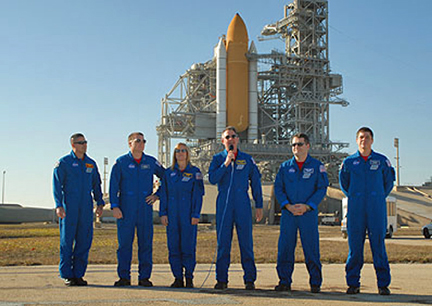
The shuttle Endeavour's crew answers questions from reporters
at pad 39A. (Photo: Ben Cooper/Spaceflight Now)
But connectors needed to circulate ammonia coolant to and from Tranquility were not correctly positioned, or "clocked," for Tranquility to be attached to Unity's left-side port. Long extension jumpers were ordered, but problems during recent pressure tests put the Feb. 7 launch date in doubt.
NASA managers ultimately decided to connect shorter flight-qualified hoses to solve the problem. As a backup, improvements were ordered to the longer hoses.
Endeavour spacewalker Robert Behnken said Wednesday work to ready the replacement hoses was ahead of schedule and should be delivered to the Kennedy Space Center in time for launch.
"We've been following these ammonia lines and the story associated with them for 13 months," he said. "I think folks paying close attention right now haven't really heard the entire story. So we've been watching them closely for a long time."
He said the crew flew to NASA's Marshall Space Flight Center in Huntsville, Ala., last weekend "to see the first line as it was coming together and actually put it on a test rig to make sure it was going to do the job that it was intended. We're expecting this Saturday to fly up and see all four lines in a pretty good configuration, pretty flight representative. Those lines, after that, will come down here to KSC for processing and installation into the orbiter."
"Right now, the schedule appears for that set of lines to be a couple of days ahead," he said. "Our original plan was to do our fit check and our opportunity with them next weekend, but they're ahead now and we'll be able to do that this Saturday, which is great news."
Behnken and his crewmates - commander George Zamka, pilot Terry Virts, Kathryn Hire, flight engineer Stephen Robinson and fellow spacewalker Nicholas Patrick - flew to the Kenned Space Center Monday to review launch pad emergency procedures and to participate in a practice countdown Thursday.
NASA managers plan to hold an executive-level flight readiness review Jan. 27 to assess Endeavour's processing and to set an official launch date. If all goes well, the shuttle countdown will begin Feb. 4.
Aboard the International Space Station, meanwhile, commander Jeffrey Williams and Max Suraev plan to strap into the Soyuz TMA-16 spacecraft Thursday and move it from the aft port of the Zvezda command module to the new Poisk docking module attached to the module's upper, or zenith, port.
On Saturday, the station crew will use the lab's robot arm to move a pressurized mating adaptor docking port - PMA-3 - from Unity's left-side port to the zenith port of the forward Harmony module. That will clear the way for Tranquility's attachment to Unity during Endeavour's mission.
After Endeavour's crew attaches Tranquility to Unity's left-side port, PMA-3 will be removed from Harmony and attached to the new module's outboard port.
7:15 PM, 1/12/10: Station managers opt for welded hoses; optimistic about Feb. 7 shuttle launch target
NASA managers decided Tuesday to modify existing space station ammonia coolant hoses by welding shorter sections together to replace a longer hose design that failed a recent ground pressure test. If the work goes well - and the schedule is tight - NASA hopes to launch the shuttle Endeavour on Feb. 7 as planned to deliver a new module to the orbiting lab complex.
The primary goal of the three-spacewalk mission is to attach a pressurized module known as Tranquility to the left side of the space station's central Unity module. Tranquility will be used to house critical life support systems and exercise gear that currently are located elsewhere in the laboratory.
NASA originally intended to attach Tranquility to Unity's Earth-facing port but later decided to mount it on the left side instead. Connectors needed to circulate ammonia coolant to and from Tranquility were not correctly positioned, or "clocked," for Tranquility to be attached to Unity's left-side port.
As a result, custom 14-foot-long hoses were ordered to compensate for the offset. But during a ground test last week, a hose ruptured below the required pressure level, throwing a potential wrench into NASA's schedule.
At a space station program requirements control board meeting Tuesday at the Johnson Space Center in Houston, NASA managers decided to replace the suspect hoses with shorter, flight-qualified lines that will be welded together to reach the required length.
At the same time, engineers will modify the hose design that failed to make it strong enough to meet the design criteria.
NASA spokesman Kelly Humphries said the welded hoses and the modified longer lines are expected to be shipped to the Kennedy Space Center about five days before Endeavour's planned launching.
"Both sets of hoses are expected to be ready within a day or so of each other," he said.
If that schedule can be maintained, the astronauts should be able to fly a full-duration three-spacewalk mission, attaching and activating Tranquility as planned. But if additional problems develop, NASA flight controllers have developed fall-back plans to fly a scaled-back two-spacewalk mission that would defer some work until later.
Endeavour and its six crew members - commander George Zamka, pilot Terry Virts, Kathryn Hire, flight engineer Stephen Robinson and spacewalkers Robert Behnken and Nicholas Patrick - plan to fly to Florida Jan. 18 to review emergency procedures and participate in a dress-rehearsal countdown Jan. 21.
Shuttle program managers, meanwhile, will assess Endeavour's launch processing next week and senior managers will meet Jan. 27 for a flight readiness review that will include an update on the space station hose work. Endeavour's countdown is scheduled to begin Feb. 4 for a launch attempt at 4:39 a.m. EST on Feb. 7.
3:30 PM, 1/8/10: Station engineers assess cooling issue; possible shuttle launch impact
Problems with ammonia lines and connectors needed to route cooling to and from a new space station module scheduled for launch aboard the shuttle Endeavour Feb. 7 could force NASA managers to modify or delay the assembly flight, sources said Friday.
But a delay is far from certain. Engineers said it may be possible to clear the lines for use as is, allowing Endeavour's crew to take off on time. If the lines can't be used, NASA could opt to launch the new module on time but delay its activation until new lines can be installed during a subsequent flight.
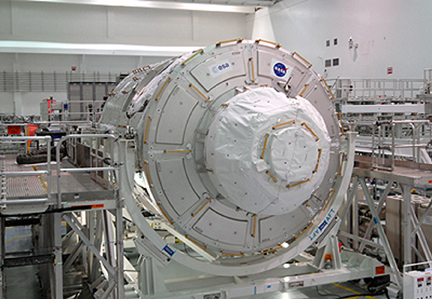
Tranquility, or node 3, during processing at the Kennedy Space
Center. (Photo: Ben Cooper/Spaceflight Now)
Sources said senior managers have ruled out delaying Endeavour's launching until after a flight currently scheduled for mid March.
Endeavour and a crew of six are currently scheduled for launch at 4:39 a.m. EST on Feb. 7 to deliver node 3, or Tranquility, to the International Space Station. Tranquility, attached to the left side of the central Unity module, will house critical life support equipment and exercise gear currently housed in other station modules.
Those systems require cooling and the module was designed to be connected to the station's external ammonia coolant loops.
NASA managers originally intended to attach Tranquility to Unity's Earth-facing port but later decided to mount it on the left side instead. Connectors needed to circulate ammonia coolant to and from Tranquility were not correctly positioned, or "clocked," for Tranquility to be attached to Unity's left-side port.
As a result, custom hoses were ordered to compensate for the offset. During a ground test this week, a hose ruptured below the expected threshold. The failure occurred at a much higher than normal pressure, but engineers are looking into the issue to find out what might be needed to resolve the matter.
Endeavour was hauled to the pad Thursday and there are no problems with the spacecraft that would preclude an on-time launch. Sources said senior managers have ruled out rolling Endeavour back to the Vehicle Assembly Building and proceeding instead with the next flight in the sequence.
Additional testing may show the hoses are acceptable for flight as is, a manager told CBS News. If not, engineers also are considering whether Tranquility can be launched on time, delaying its activation and connecting "keep-alive" power until new or redesigned hoses can be launched and installed during a later flight.
Space station engineers and managers plan to discuss the issue in more detail Tuesday.
02:40 PM, 1/6/10: Shuttle Endeavour hauled to launch pad
The shuttle Endeavour was hauled to the launch pad Wednesday for work to ready the ship for launch Feb. 7 on a space station assembly mission, the first of a final five flights planned for 2010.
Endeavour, mounted atop a mobile launch platform carried by an Apollo-era crawler-transporter, began the 3.4-mile trip from the Vehicle Assembly Building to launch complex 39A at 4:13 a.m. EST. The MLP was "hard down" at the pad at 10:37 a.m.

Shuttle Endeavour approaches pad 39A at the Kennedy Space Center.
(Photo: Stephen Clark/Spaceflight Now)
A program-level flight readiness review is planned for Jan. 19 and 20, followed by an executive-level review Jan. 27 to assess launch processing and set an official launch date.
"February 7th is looking great," Dana Hutcherson, the Endeavour flow director, said Wednesday. "We got a little bit of contingency time (in the processing schedule), so everything is looking well. We're not tracking any major issues or concerns."
Endeavour's crew - commander George Zamka, pilot Terry Virts, Kathryn Hire, Stephen Robinson, Nicholas Patrick and Robert Behnken - plans to fly to the Kennedy Space Center Jan. 19 to review emergency procedures and participate in a practice countdown Jan. 21.
If all goes well, the real countdown will begin at 2 a.m. on Feb. 4. Liftoff on the 130th shuttle mission currently is targeted for 4:39 a.m. on Feb. 7.
The primary goal of the flight is to deliver and attach a final major U.S. pressurized module, a roomy addition known as node 3, or Tranquility, that will house life support equipment and exercise gear currently located elsewhere in the lab complex.
Sporting a multi-window cupola that will permit spectacular panoramic views, Tranquility will be attached to the left-side port of the central Unity module, directly across from the station's Quest airlock.
Assuming an on-time launch, Endeavour will dock with the space station around 1:23 a.m. on Feb. 9. Tranquility will be attached during a spacewalk by Behnken and Patrick on Feb. 10. Two more spacewalks are scheduled for Feb. 12 and 15 before undocking Feb. 17 and landing back at the Kennedy Space Center two days later.
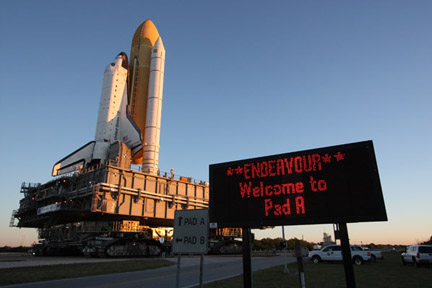
Welcome to pad 39A! (Photo: Stephen Clark/Spaceflight Now)
Endeavour's flight is the first of five shuttle missions planned for 2010, the final five flights before NASA's orbiters are retired. Here is the current schedule (times in EST/EDT and subject to change):
4:15 PM, 12/16/09: Setting up STS-130 page
The shuttle Endeavour, mated to an external fuel tank and a set of solid-fuel boosters, will be hauled to pad 39A on Jan. 6, setting the stage for launch around Feb. 7 on a mission to deliver a final major U.S. module to the International Space Station.
A program-level flight readiness review is planned for Jan. 19 and 20, followed by an executive-level FRR Jan. 27 that will set an official launch date. As of this writing, liftoff is targeted for 4:39 a.m. EST on Feb. 7.

The shuttle Endeavour is attached to an external fuel tank Dec. 12.
Rollout to pad 39A is targeted for Jan. 6. (Credit: NASA)
On board will be commander George Zamka, pilot Terry Virts, Kathryn Hire, flight engineer Stephen Robinson and spacewalkers Robert Behnken and Nicholas Patrick.
The goal of the 130th shuttle mission is to deliver and install node 3, or "Tranquility," a final major U.S. module that will house life support equipment and exercise gear. Node 3 will be attached to the left-side port of the central Unity module.
The Italian-built module, similar in size and function to the Harmony module on the forward end of the station, also features a multi-window cupola that will give station astronauts an unparalleled vista for Earth-observations and atmospheric research.

A graphic showing Node 3, with cupola, attached to the Unity
module of the International Space Station. (Credit: Thales Alenia Space)
The latest version of the STS-130 flight plan, the countdown and other useful information is posted on the CBS News STS-130 Quick-Look page. Additional data will be posted here as it becomes available.
10:05 AM, 11/27/09: Shuttle Atlantis lands in Florida (UPDATED at 1 p.m. with quotes from commander, NASA management; UPDATED at 4:15 with Stott comments; Bresnik departure)
The shuttle Atlantis dropped out of a crystal clear Florida sky and glided to a "picture-perfect" landing at the Kennedy Space Center Friday to close out a successful 11-day space station mission, bringing astronaut Nicole Stott back to Earth after 91 days in space.
With commander Charles Hobaugh at the controls, Atlantis executed a sweeping right overhead turn to line up on runway 33, pilot Barry Wilmore deployed the ship's landing gear and the shuttle settled to a tire-smoking touchdown at 9:44:23 a.m. EST.
"Houston, Atlantis, wheels stopped," Hobaugh radioed as the orbiter rolled to a halt on the runway centerline.
"Roger, wheels stopped, Atlantis, that was a picture-perfect end to a top-fuel mission to the space station," replied astronaut Chris Ferguson from mission control at the Johnson Space Center. "Everybody, welcome back to Earth, especially you, Nicole."
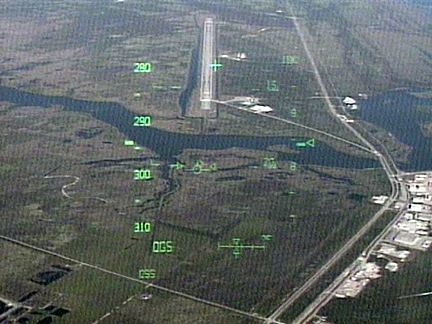
The view from pilot Barry Wilmore's cockpit window during final
approach to runway 33 at the Kennedy Space Center.
(Photo: NASA TV)
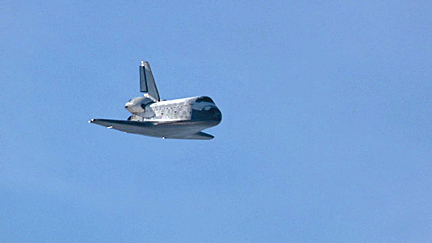
Atlantis lines up on the runway. (Photo: NASA TV)
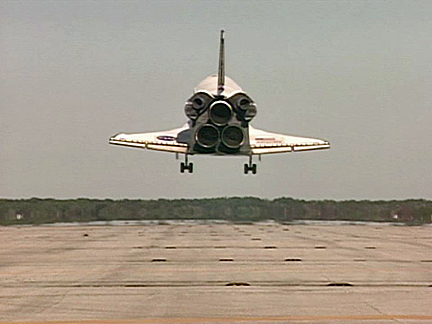
A runway camera captures Atlantis seconds before touchdown.
Photo: NASA TV)
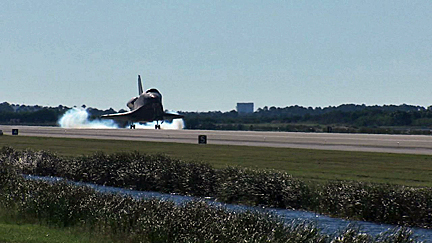
Atlantis touches down on runway 33. (Photo: NASA TV)
Mission duration was 10 days 19 hours 16 minutes and 13 seconds, covering a distance of 4.4 million miles and 171 complete orbits since blastoff from pad 39A at 2:28:10 p.m. on Nov. 16.
"This was just an amazing mission," said Bill Gerstenmaier, NASA's chief of space operations. "An on-time launch, on-time landing ... just a phenomenal team effort across the board. ... The folks did great, the vehicle did good, the folks who did all the processing down here did a great job giving us a very good vehicle."Hobaugh, Wilmore, flight engineer Leland Melvin and spacewalkers Robert Satcher, Michael Foreman and Randolph Bresnik doffed their pressure suits for a traditional runway inspection about an hour after touchdown.
"We really had truly an amazing mission," Hobaugh said on the runway. "It was not us, it was not any single group, but it was just an incredible team from all around the nation."We were lucky, I mean, part of it's luck and part of it's just pure, great skill, workmanship in processing Atlantis, getting it ready for us. We had no hitches, we went off on time, we landed on time. ... Nicole came back with us, she's doing great, she's headed back to see her family."
Launched to the lab in August, Stott made the trip back to Earth resting on her back in a recumbent seat on the shuttle's lower deck to ease her return to gravity after 91 days in orbit.
Flight surgeons were standing by to help her off the shuttle and carry out initial medical checks before accompanying her to crew quarters for a more detailed exam. Looking comfortable and in good spirits, she told a NASA interviewer a few hours later that while her vestibular system had not yet re-adapted to gravity, she was in good shape and glad to be home.
"As you move, everything else seems to be moving around you," she said. "And it's not a spinning, dizzy feel, it's more if I get up, then everything else seems to want to move up. ... But other than that, the main thing was when they opened the hatch, it smelled like fresh, clean, fall air. And that was really nice."
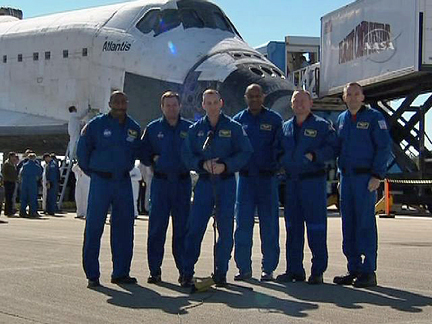
The Atlantis astronauts posing in front of the shuttle. (Photo: NASA TV)
Her husband and 7-year-old son were on hand to welcome her back to Earth and "I have the promise of a Coca-Cola with crushed ice in a styrofoam cup and some good food, Thanksgiving left overs, waiting for me upstairs. There are also nice, warm showers here so that's a definite luxury I think I will enjoy for some time."
Stott, Hobaugh, Wilmore, Melvin, Foreman, and Satcher planned to fly back to Houston early Saturday. Bresnik, whose wife Rebecca gave birth to the couple's second child on Saturday, flew home right away aboard a NASA training jet to meet his daughter for the first time.
Stott is the last space station crew member to launch and land aboard a space shuttle. With just five more shuttle missions before the fleet is retired next year, all future U.S. station astronauts will fly to and from the lab complex aboard Russian Soyuz capsules.
Stott's former station crewmates face a busy weekend in orbit preparing for the Dec. 1 departure and landing of Expedition 21 commander Frank De Winne, cosmonaut Roman Romanenko and Canadian astronaut Robert Thirsk, who were launched to the lab May 27. They are scheduled to land in Kazakhstan aboard the Soyuz TMA-15 capsule around 2:16 a.m. EST Tuesday to close out a 188-day stay in space.
Expedition 22 commander Jeffrey Williams and cosmonaut Maxim Suraev, who arrived at the lab complex in October, will have the outpost to themselves until Dec. 23 when three fresh crew members - cosmonaut Oleg Kotov, astronaut Timothy Creamer and Japanese astronaut Soichi Noguchi - are scheduled to arrive.
In the midst of departure preparations, flight controllers were tracking a piece of debris from a Delta rocket body that was expected to pass by the station Saturday evening. The station crew may be asked to carry out an avoidance maneuver rocket firing if additional tracking indicates the debris might pass too close.
Hobaugh and his shuttle crewmates delivered nearly 15 tons of spare parts and equipment to the space station, including two pallets loaded with large components as a hedge against failures after the shuttle is retired.
The gear included two orientation control gyroscopes, a spare pump module, nitrogen pressurization tank and ammonia coolant for the lab's external cooling system, equipment for the mobile transporter that carries the station's mechanical arm, a new latching end effector, or hand, for the space crane, and equipment for the lab's electrical system.

Atlantis on final approach. (Photo: Steven Young/Spaceflight Now)
The astronauts also carried out three spacewalks to prepare the complex for the attachment of NASA's final major module in February and the eventual arrival of additional spare parts and equipment that will be ferried up next year. In addition, a high-pressure oxygen tank was attached to the station's Quest airlock module.
For the trip back to Earth, the shuttle carried 2,100 pounds of station gear, including a urine distillation centrifuge that failed shortly before Atlantis took off. A replacement will be carried aloft on the next shuttle mission in February.
Atlantis' mission was one of the most trouble free in recent memory and re-entry Friday went off without a hitch.
Flying upside down and backward over the southern Indian Ocean, Hobaugh and Wilmore fired the ship's twin orbital maneuvering system for two minutes and 47 seconds starting at 8:37 a.m., slowing the ship by 211 mph to drop it out of orbit.
After a half-hour free fall, Atlantis plunged into the discernible atmosphere 400,000 feet above the Pacific Ocean around 9:13 a.m., its nose pitched up to a 40-degree angle of attack for the onset of atmospheric heating.
Following a southwest-to-northeast trajectory, the shuttle's computer-controlled entry carried it above Central America and just off the extreme western tip of Cuba before a descent across southern Florida to the Kennedy Space Center.